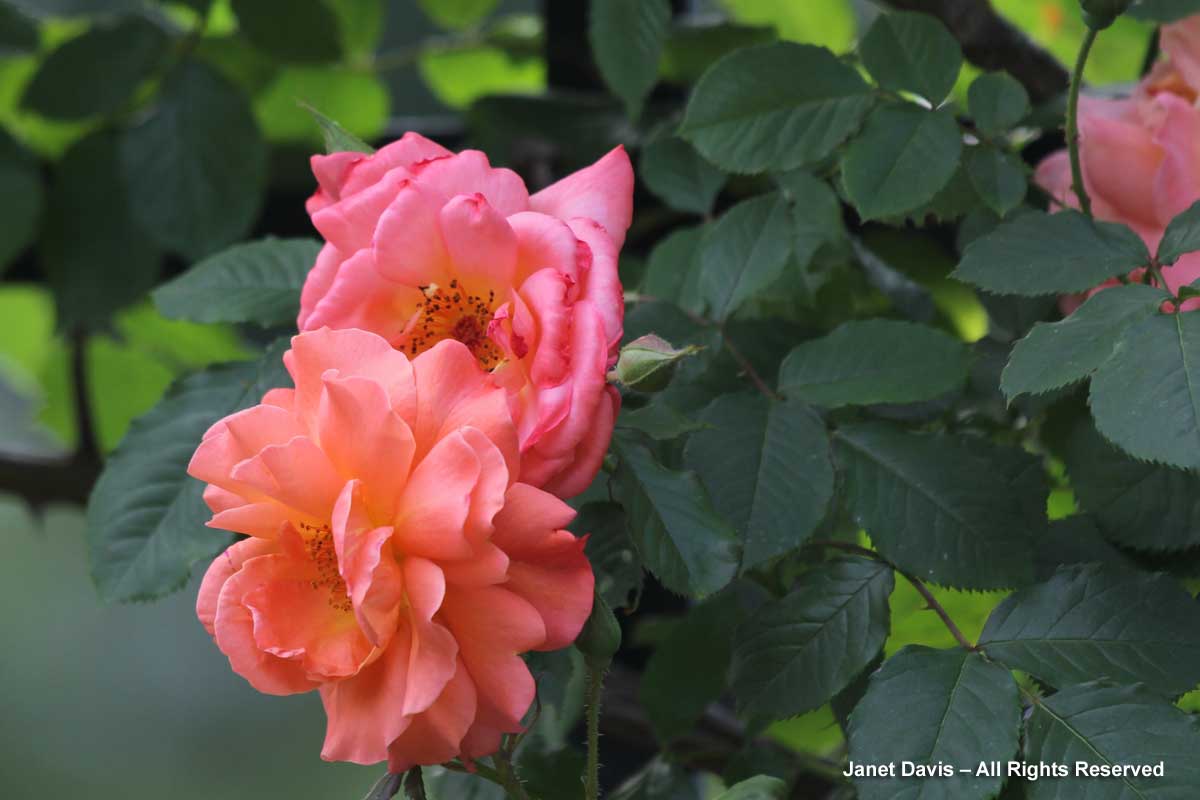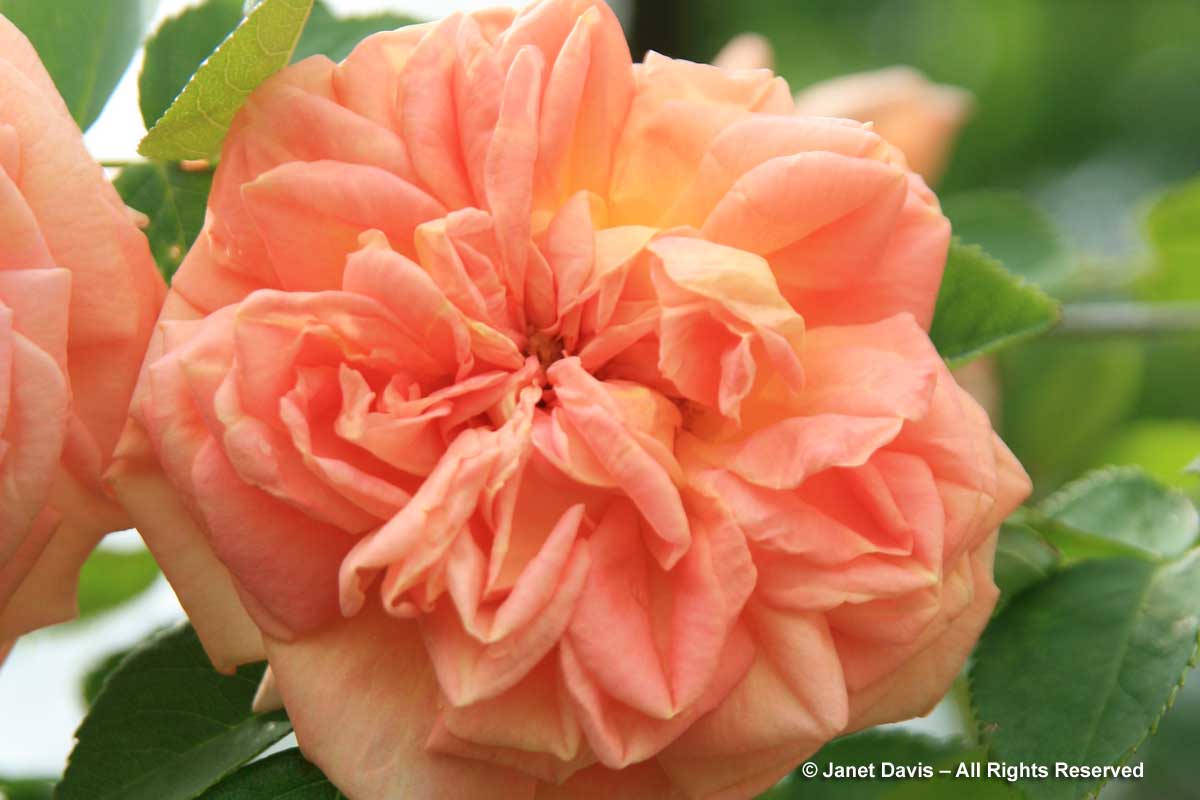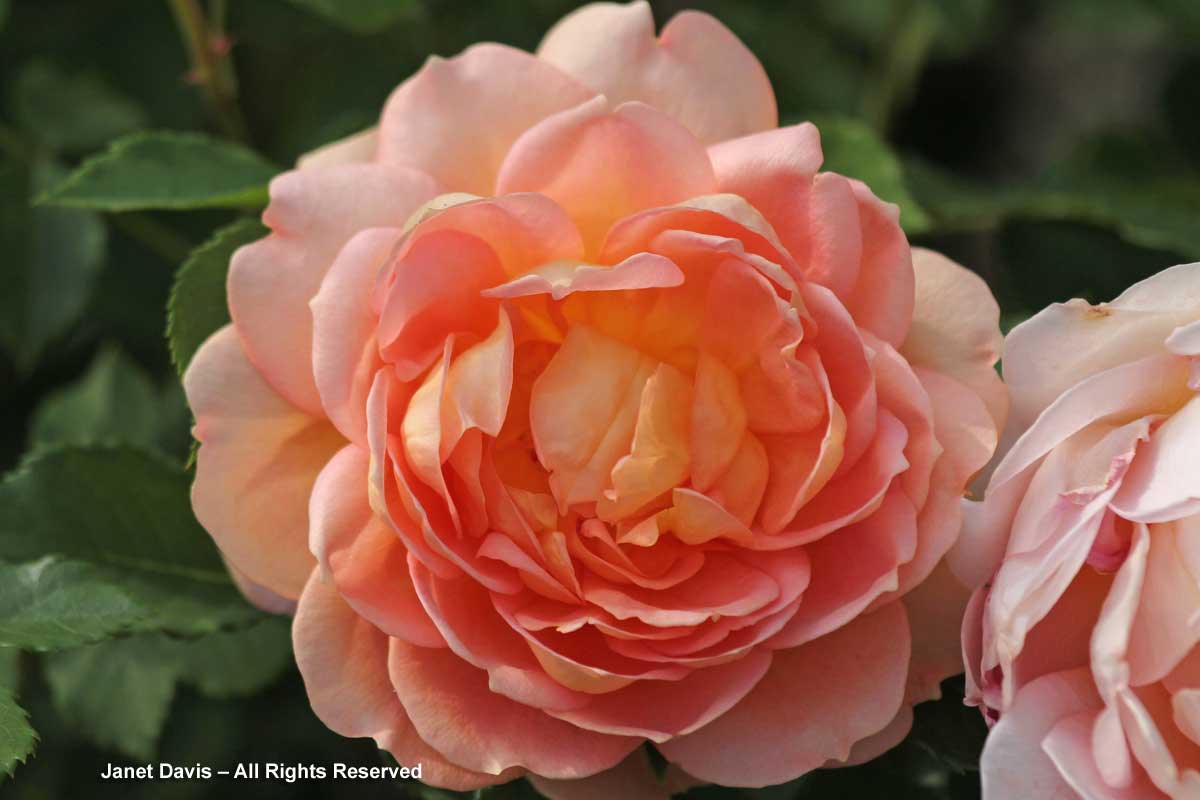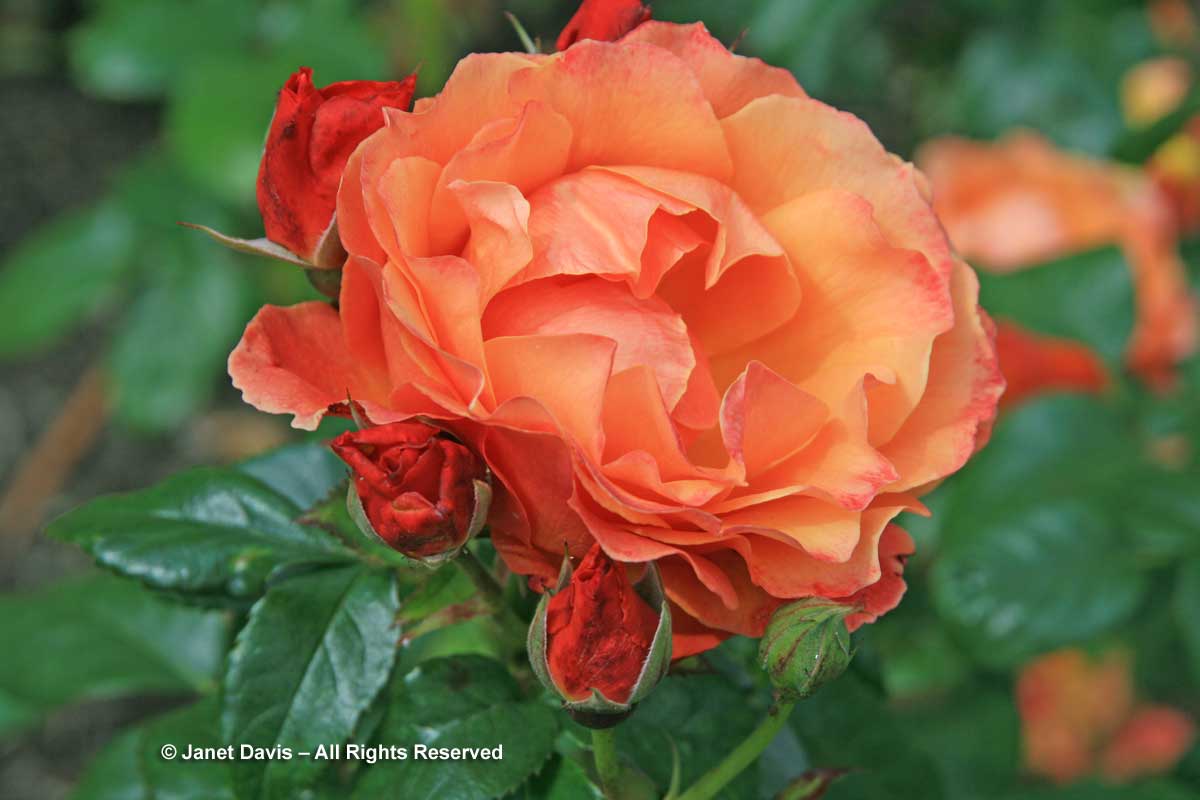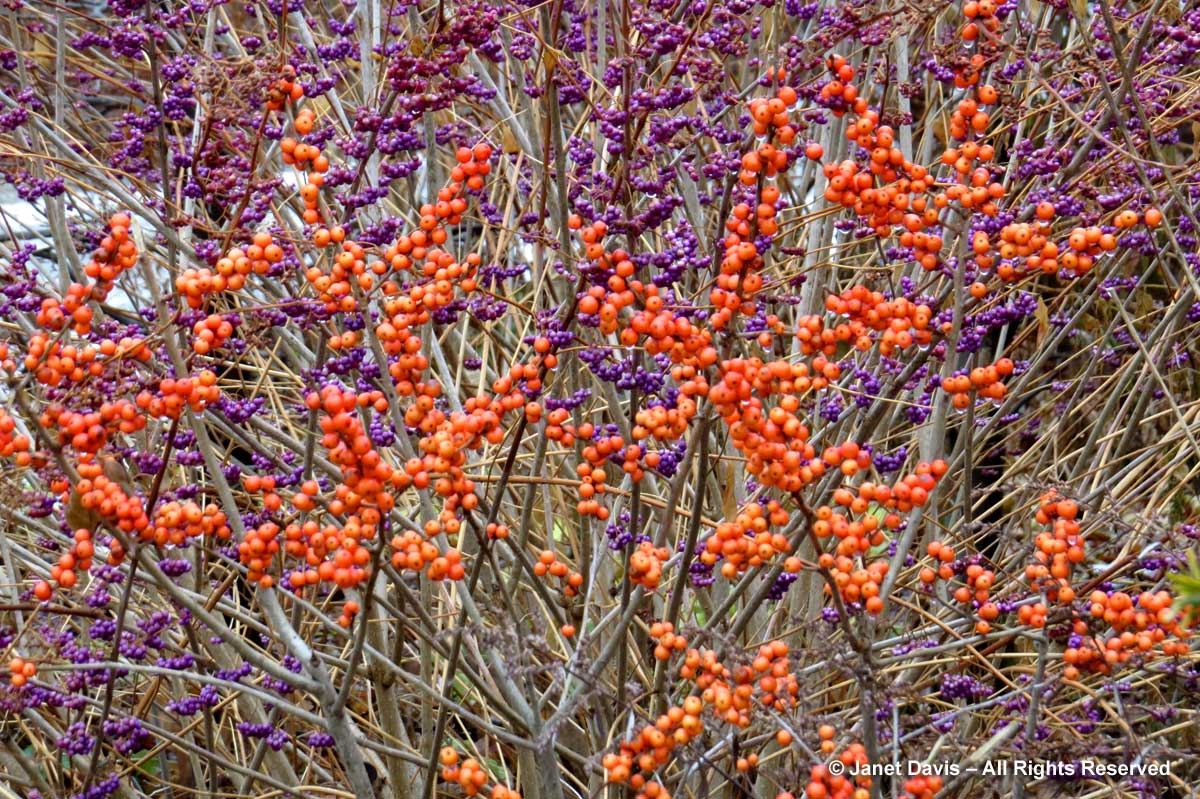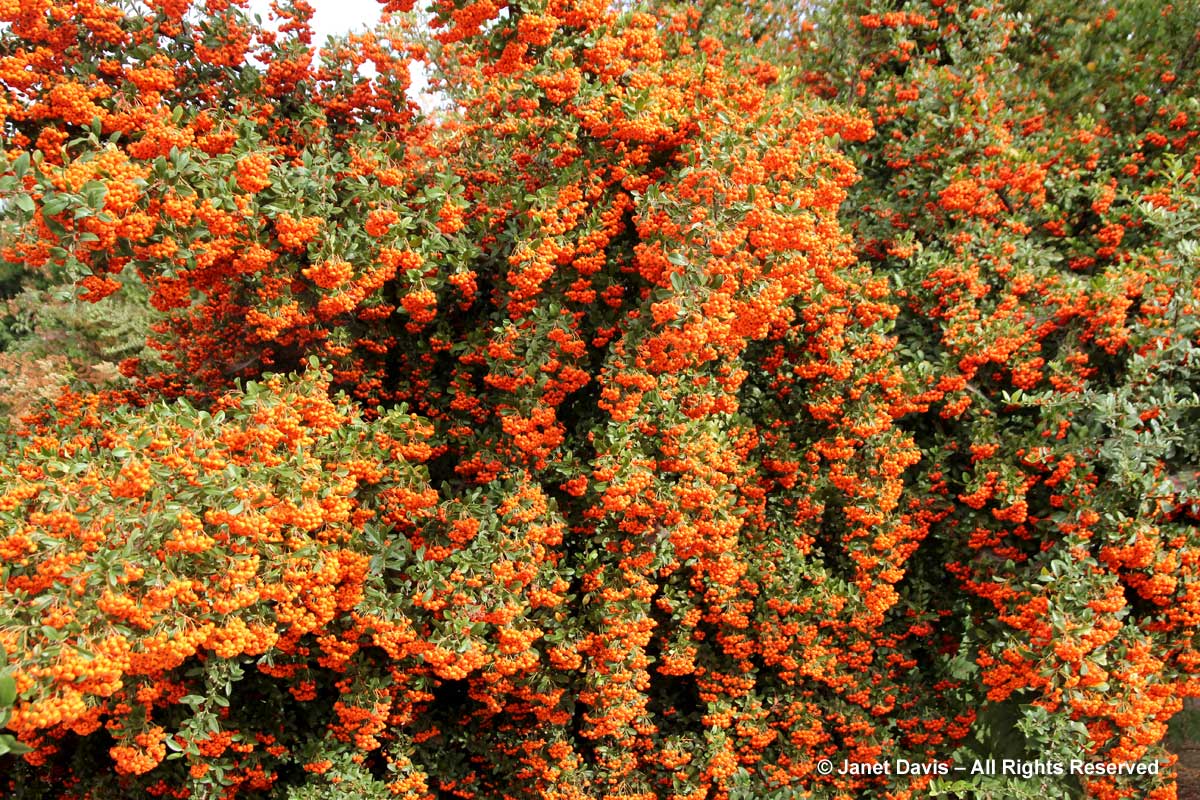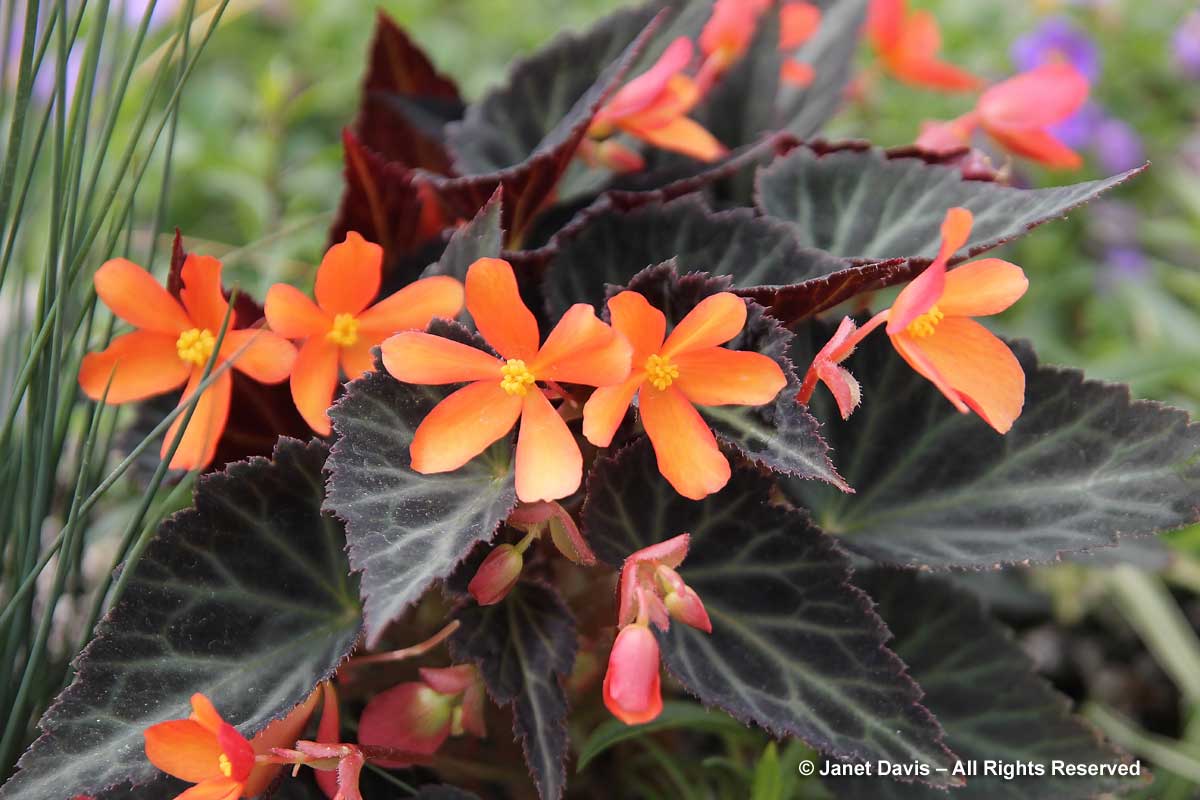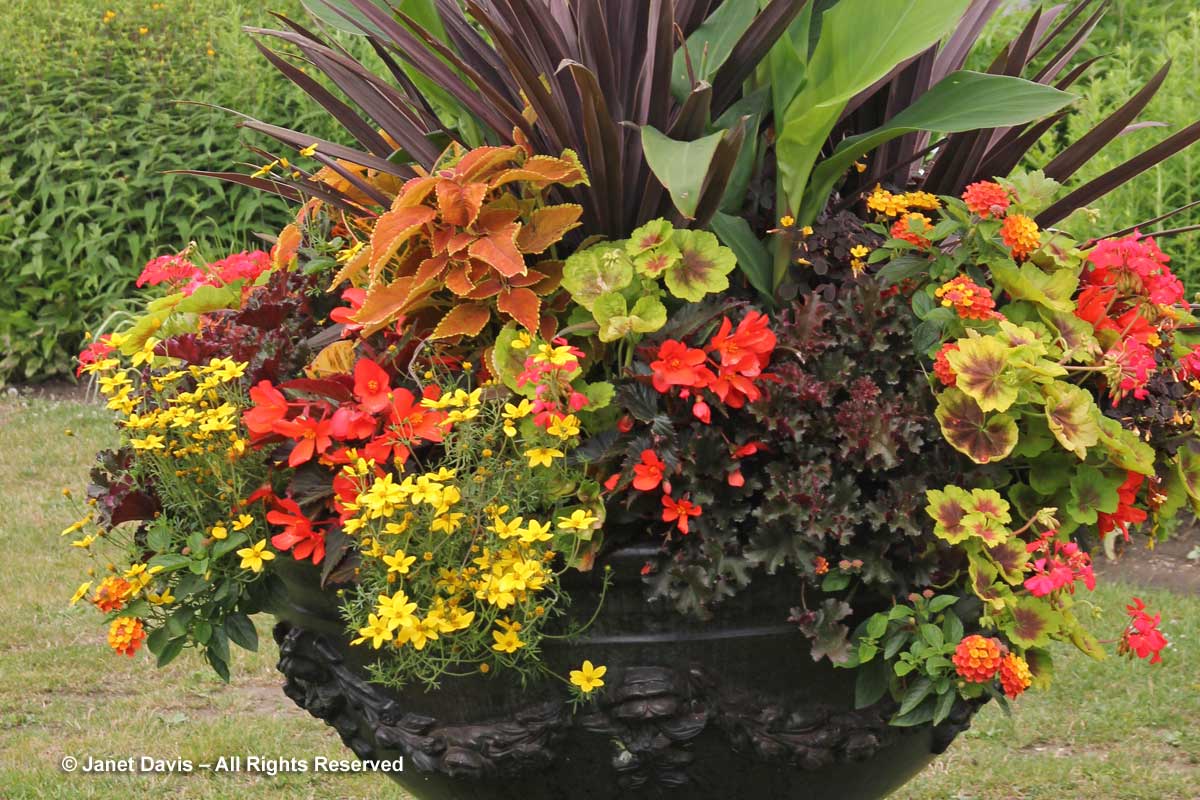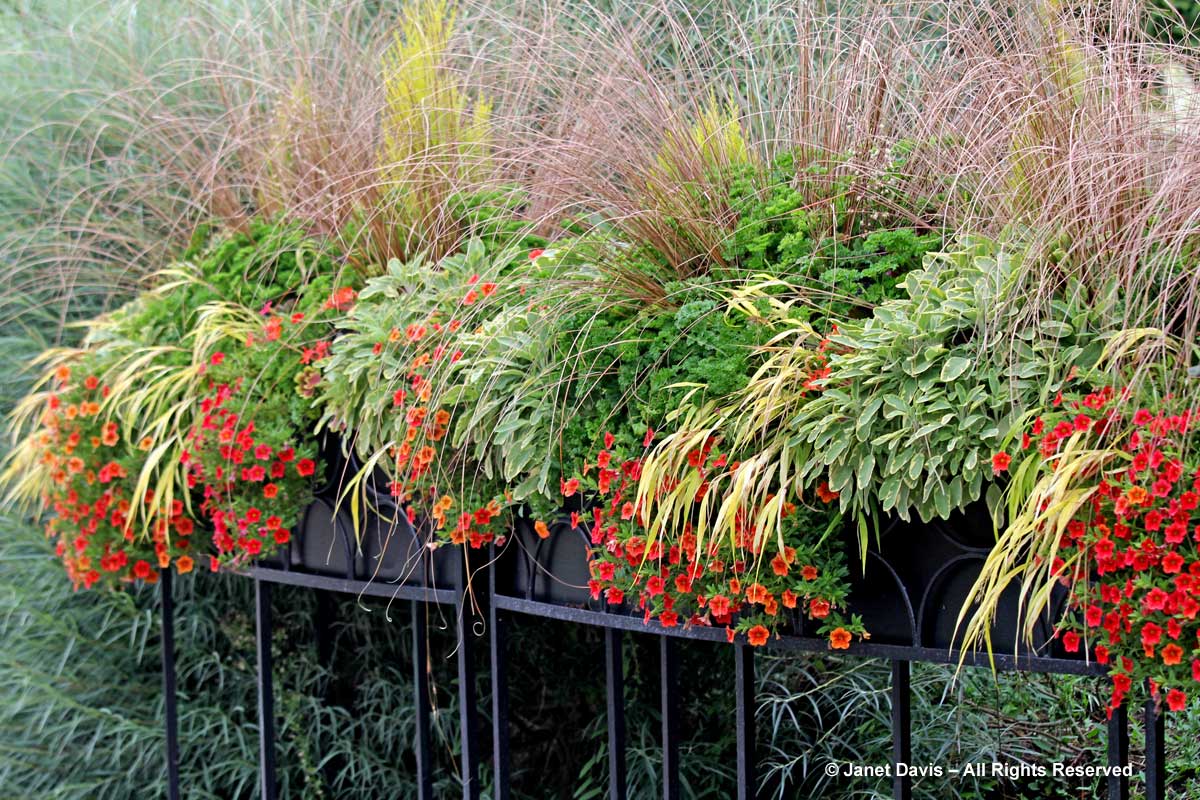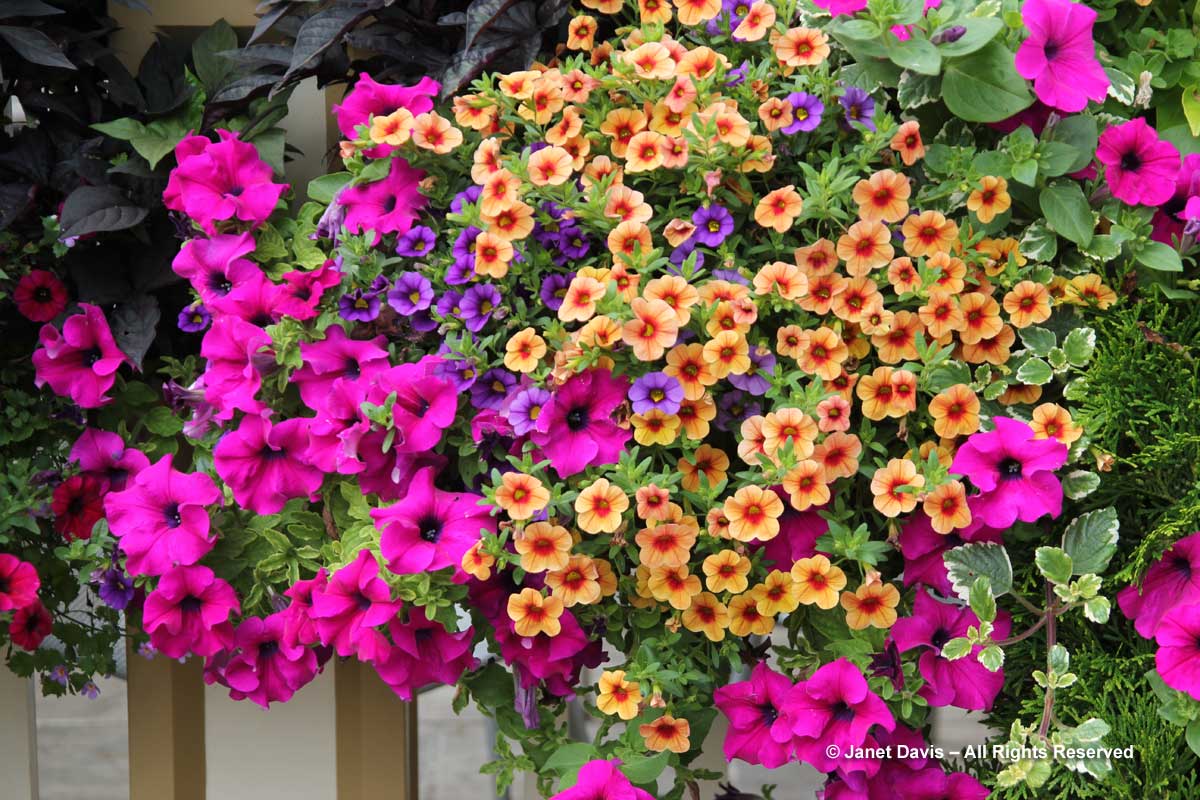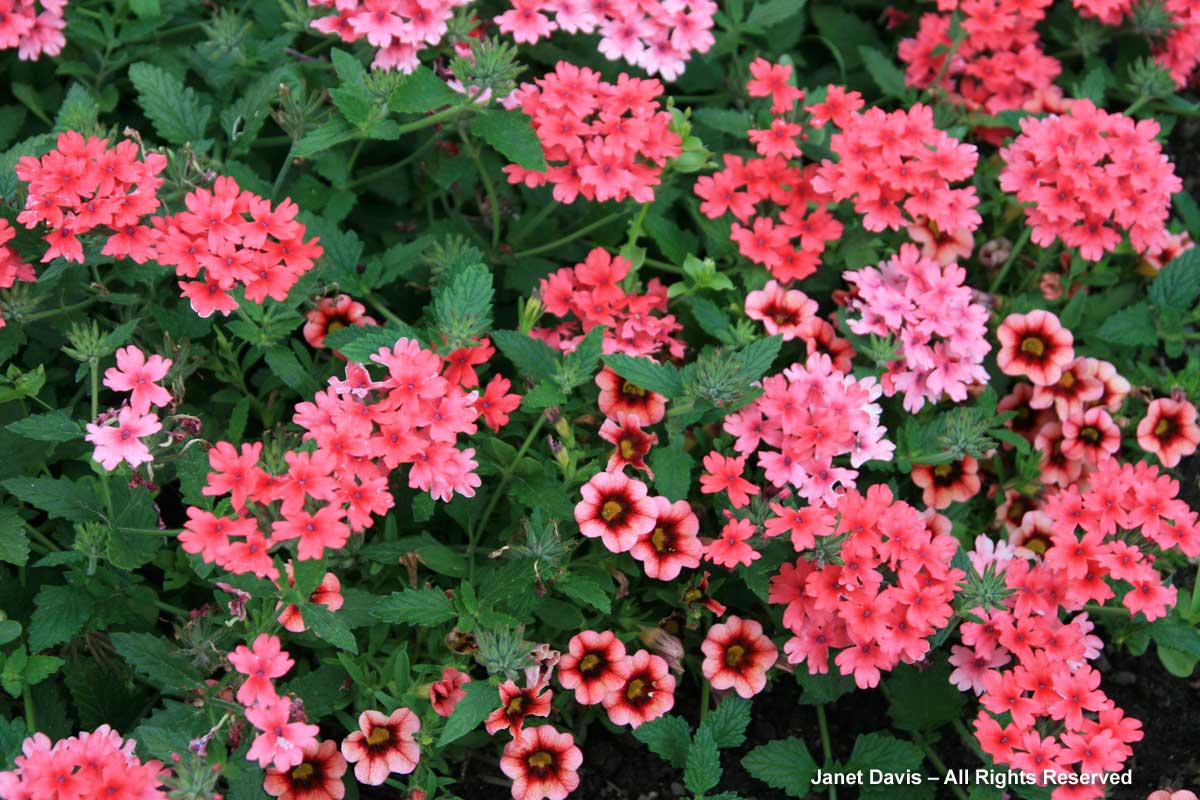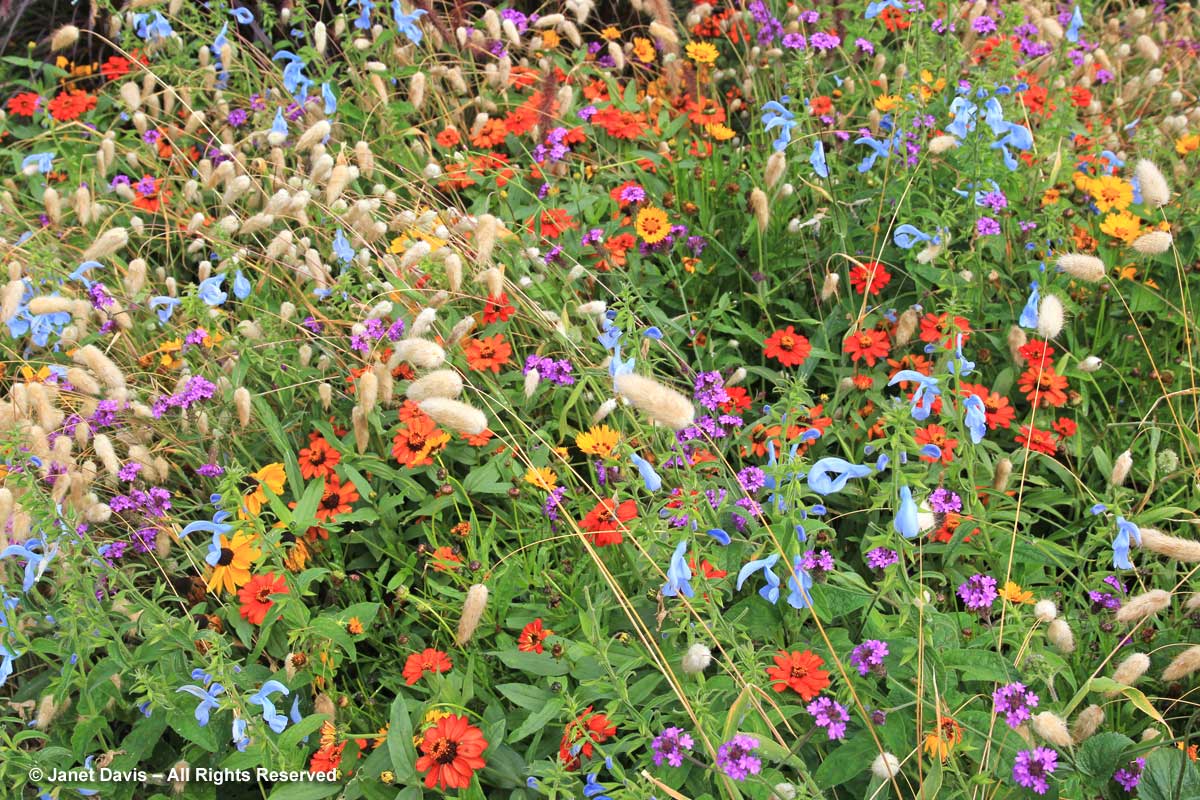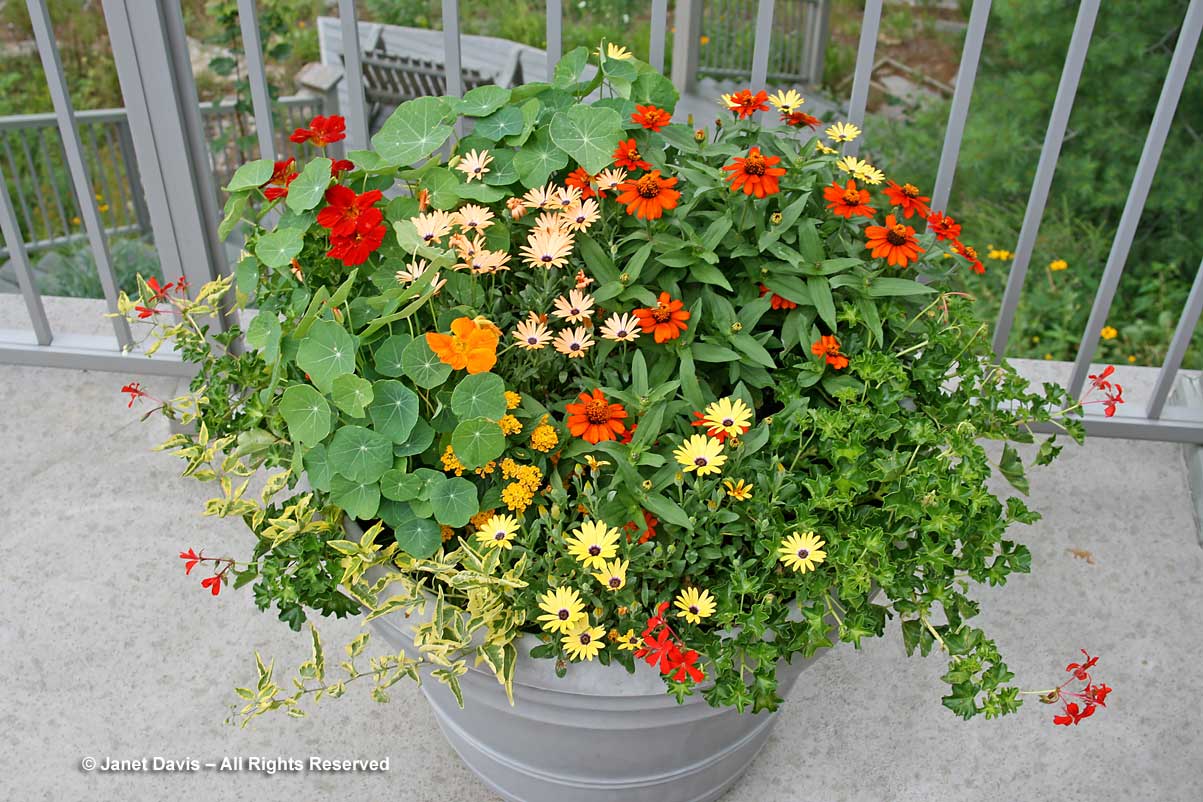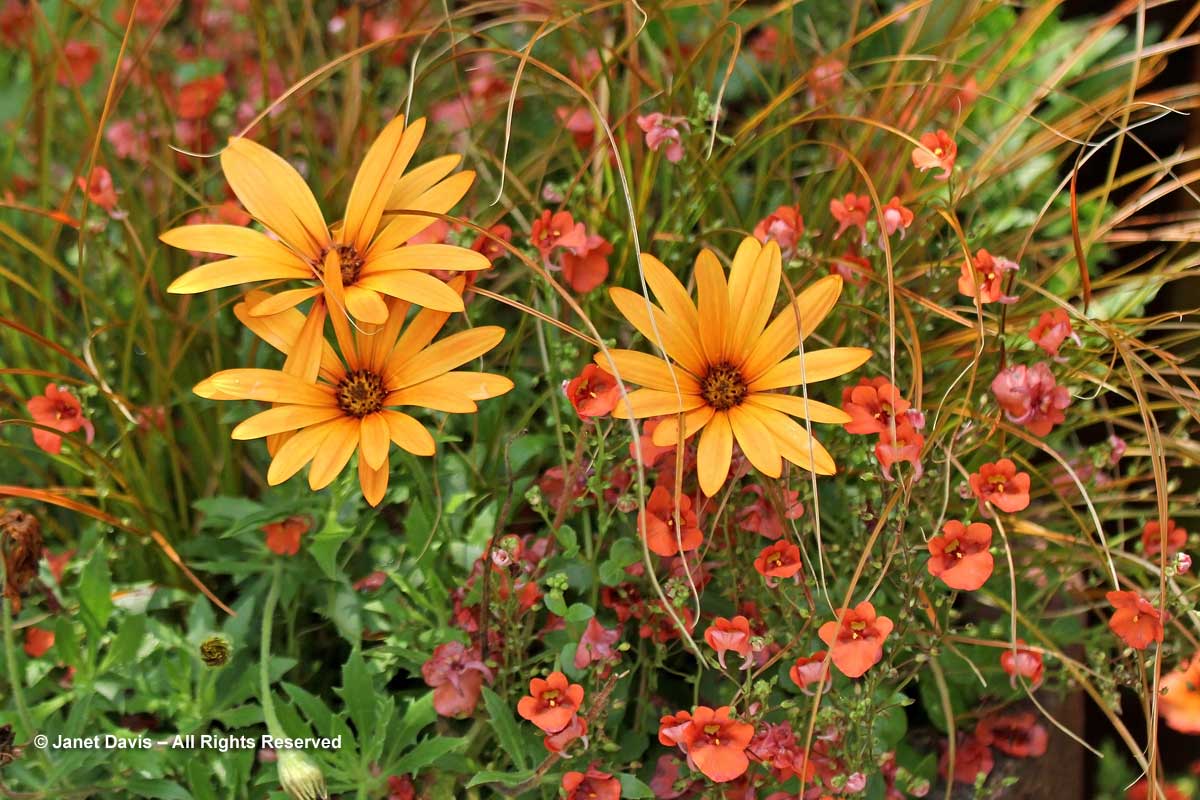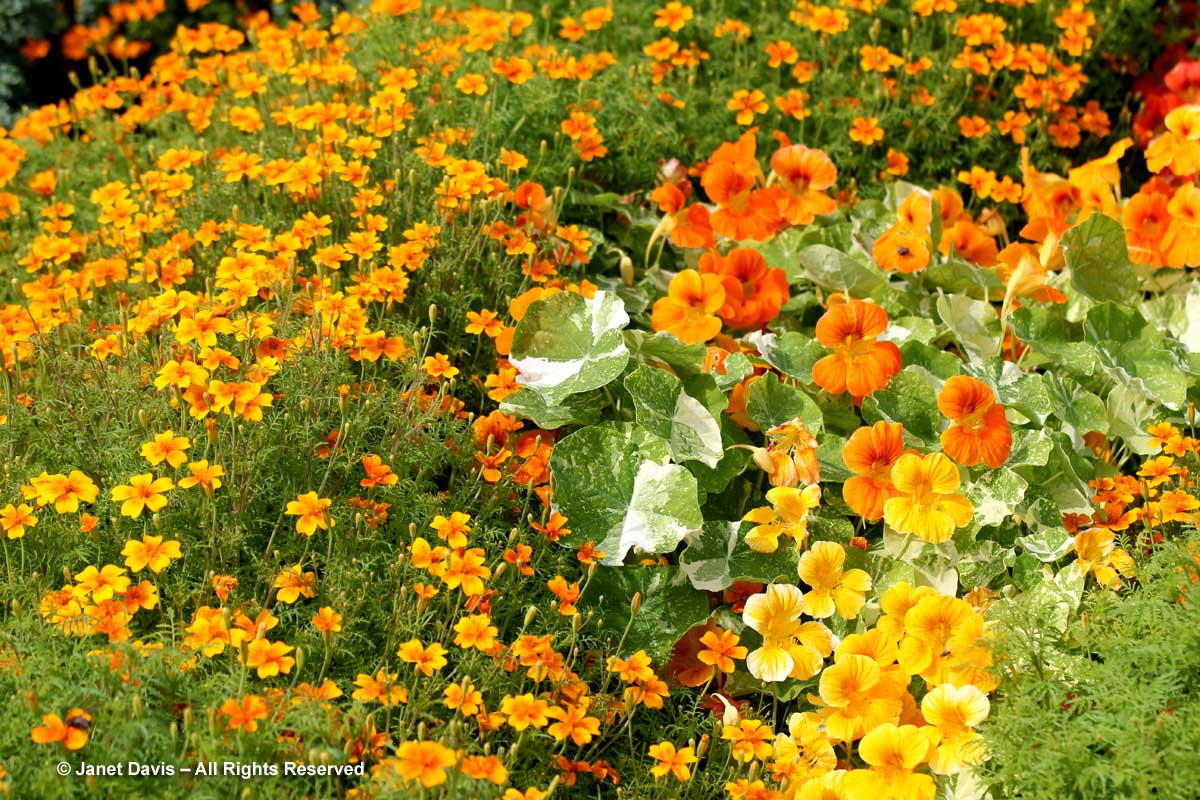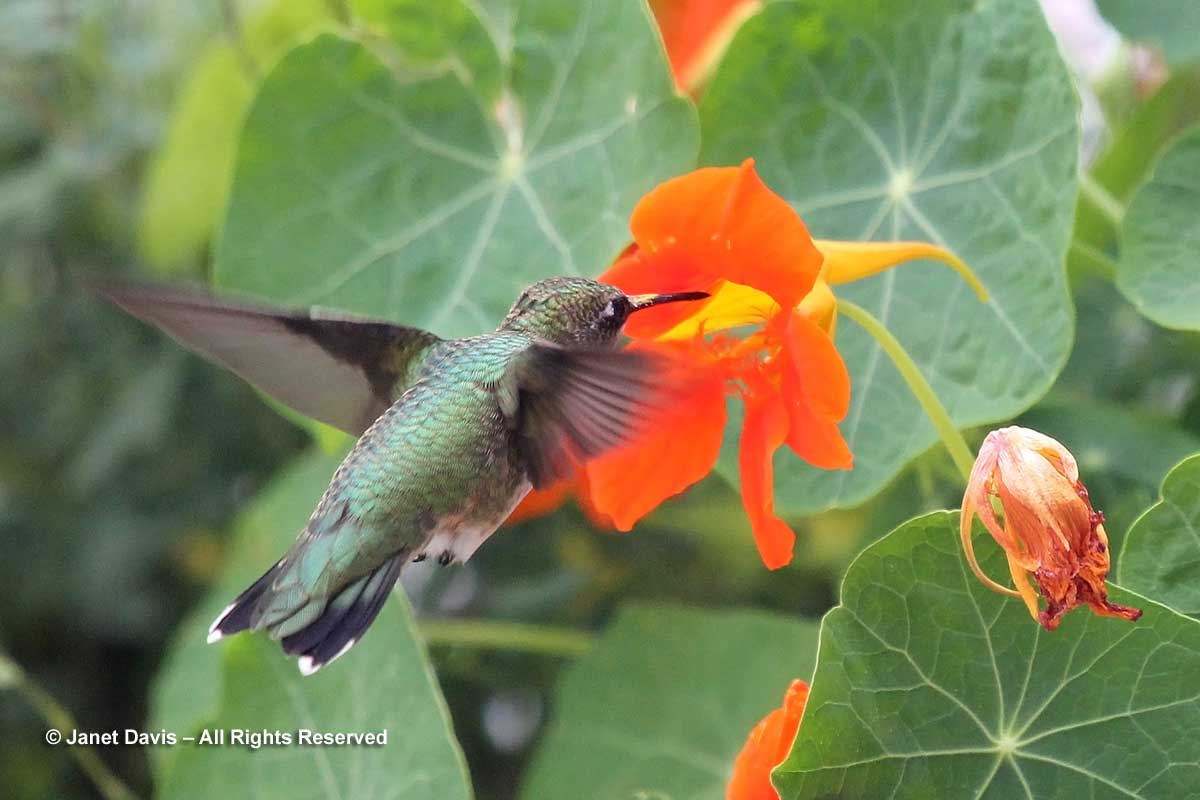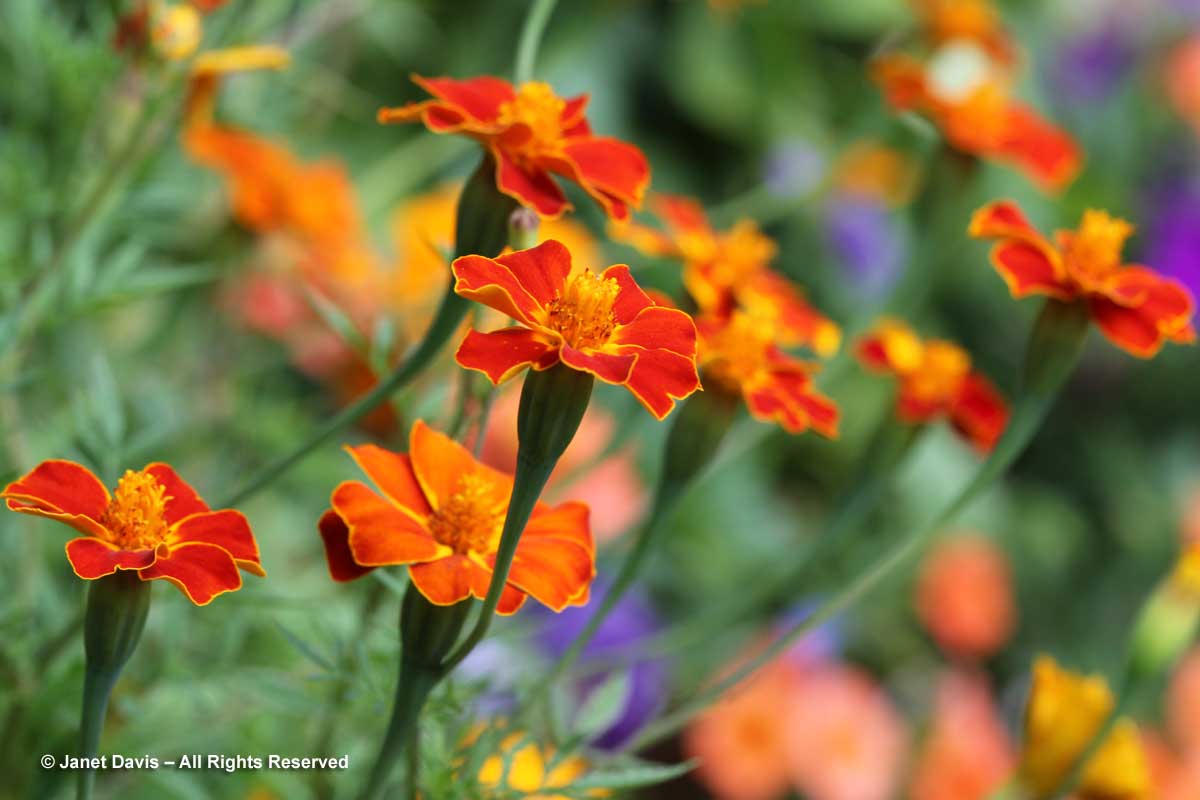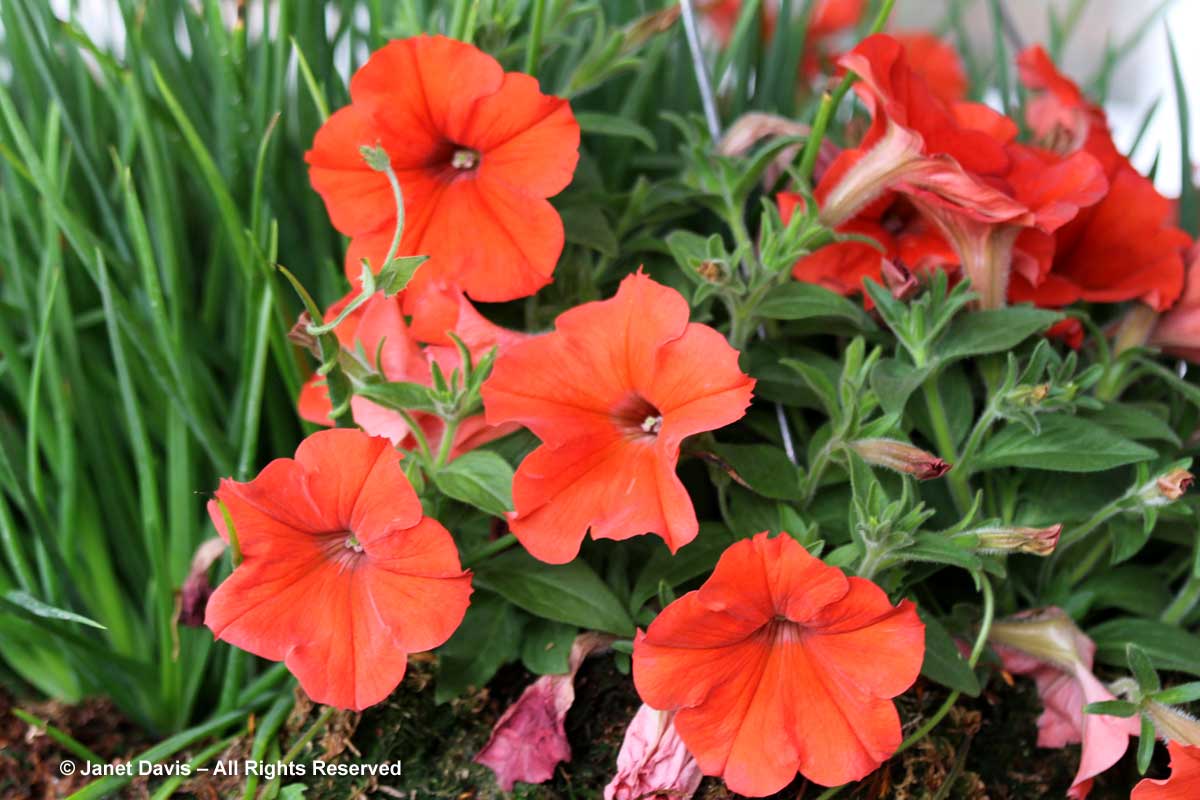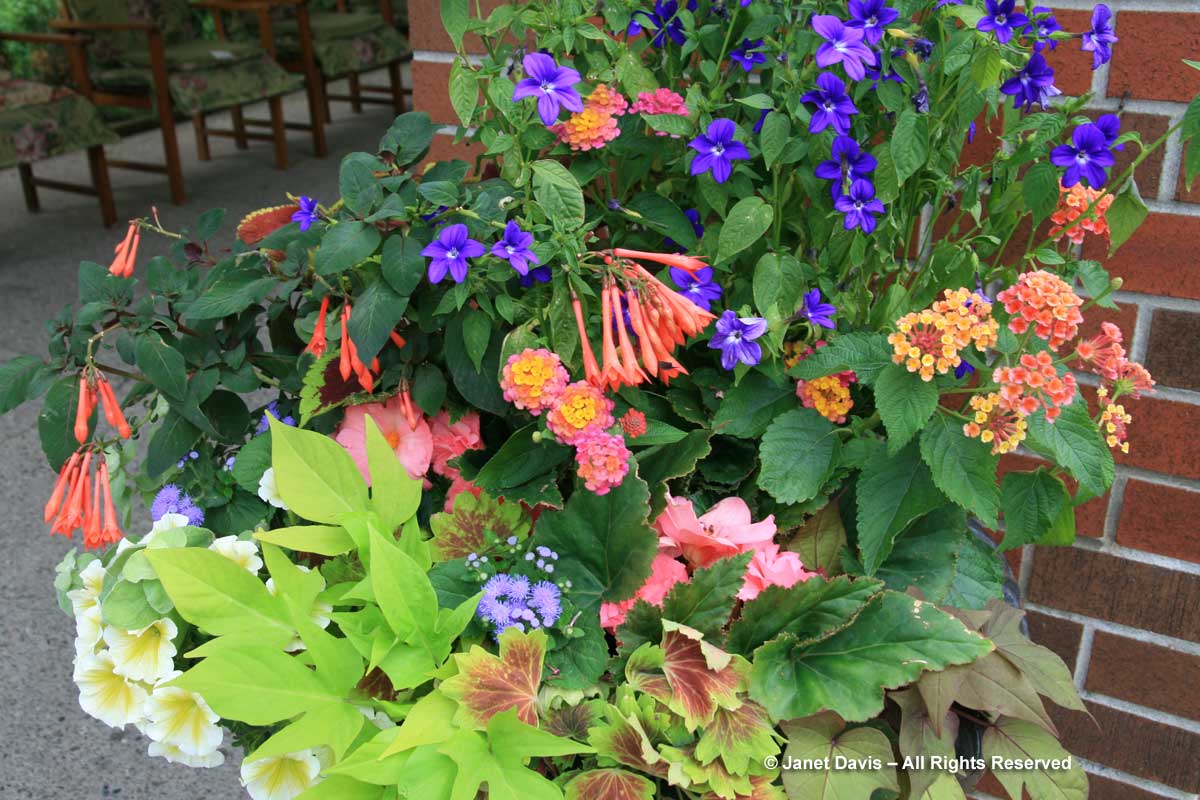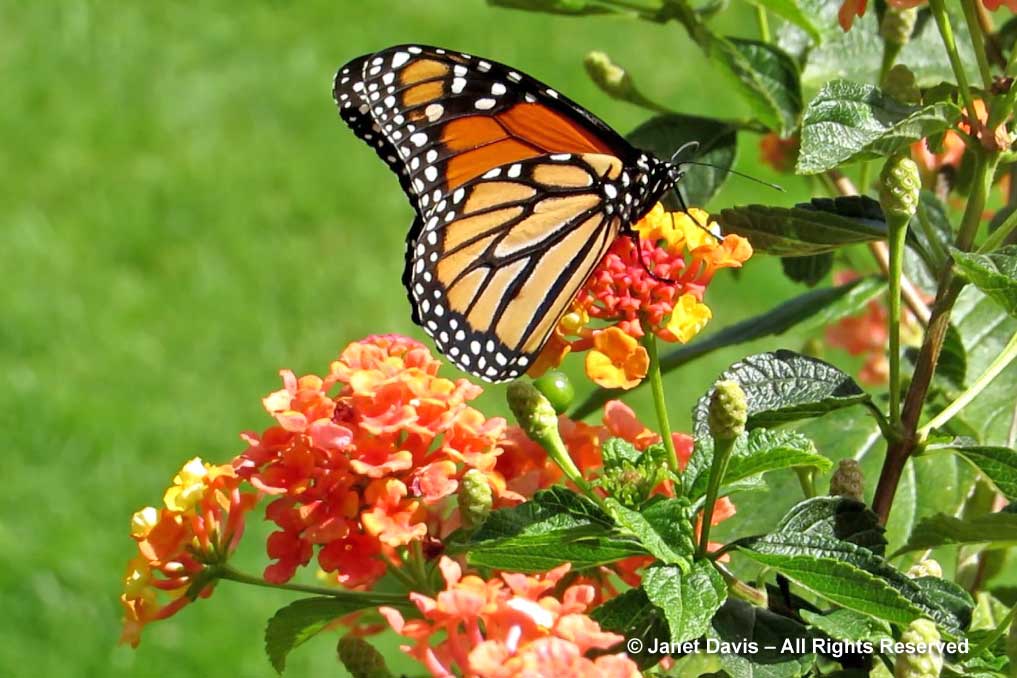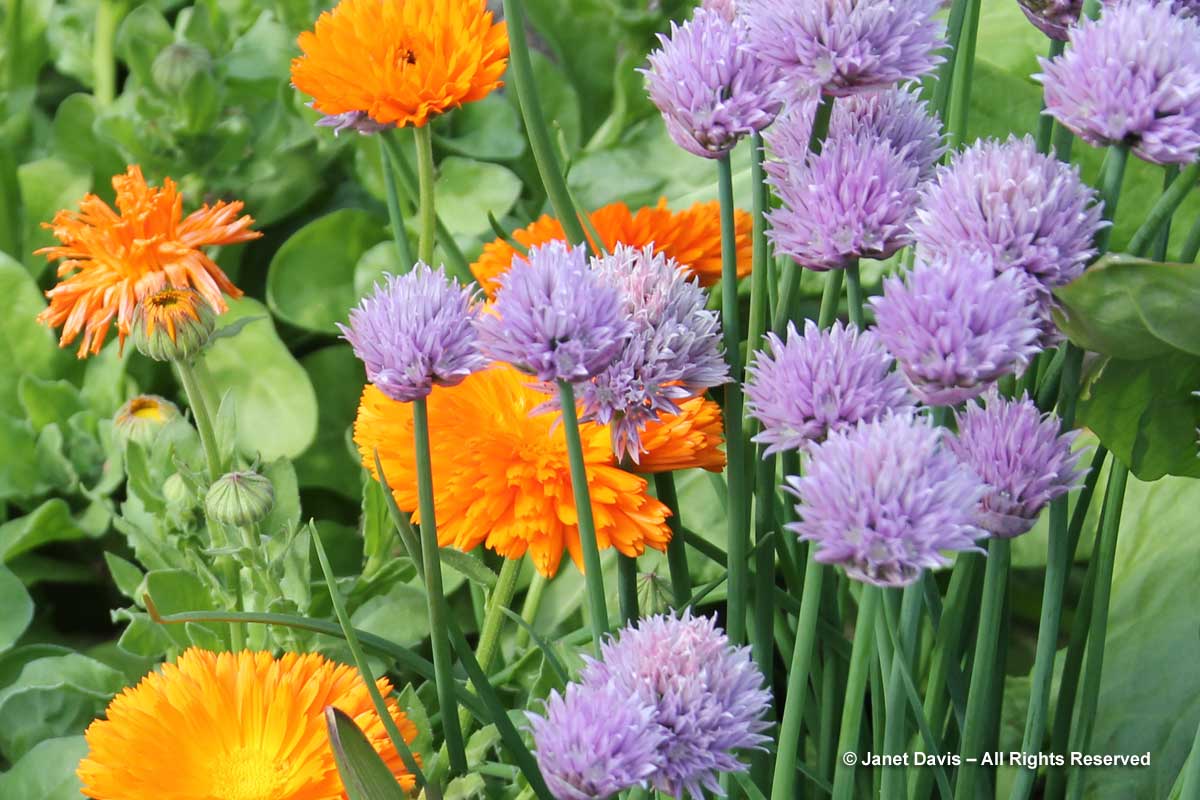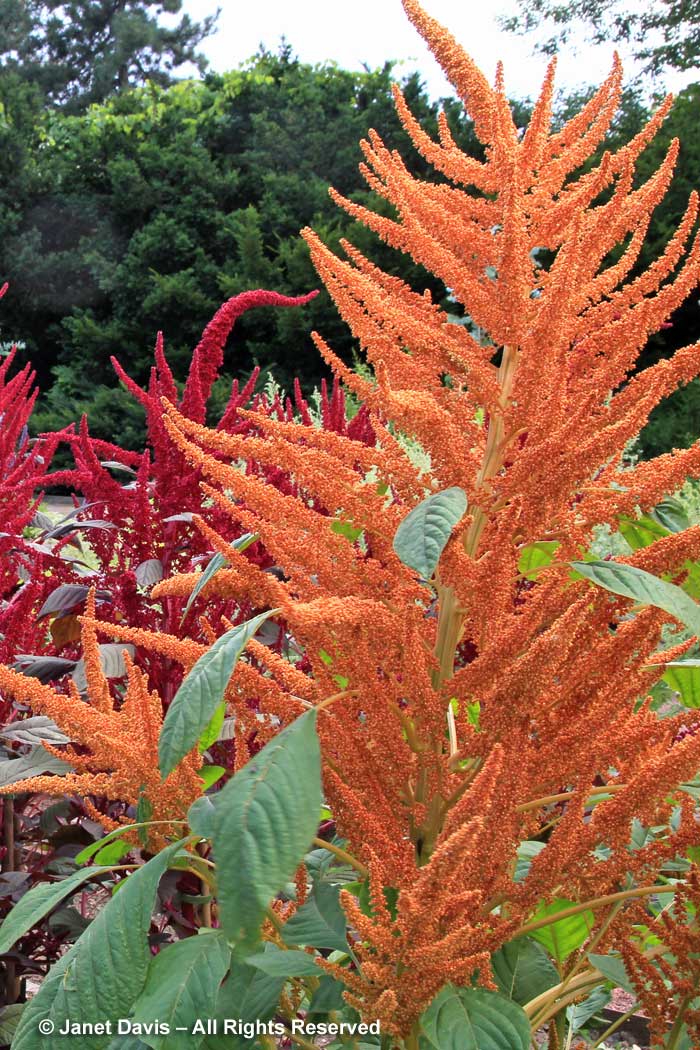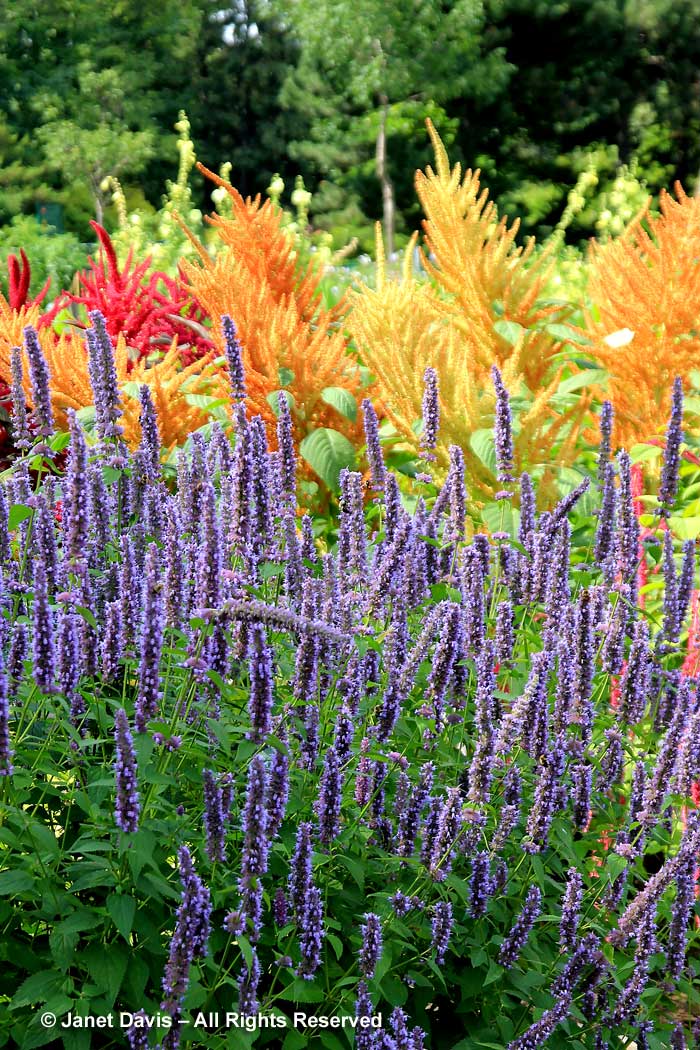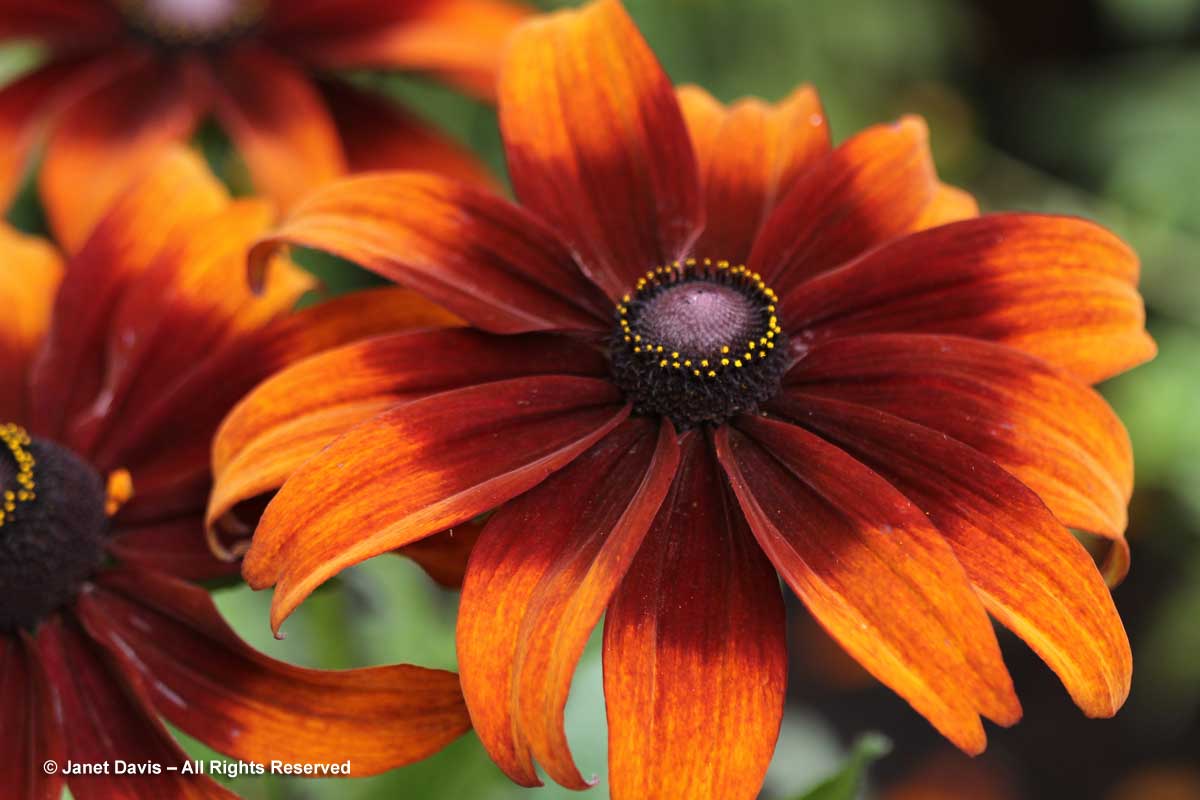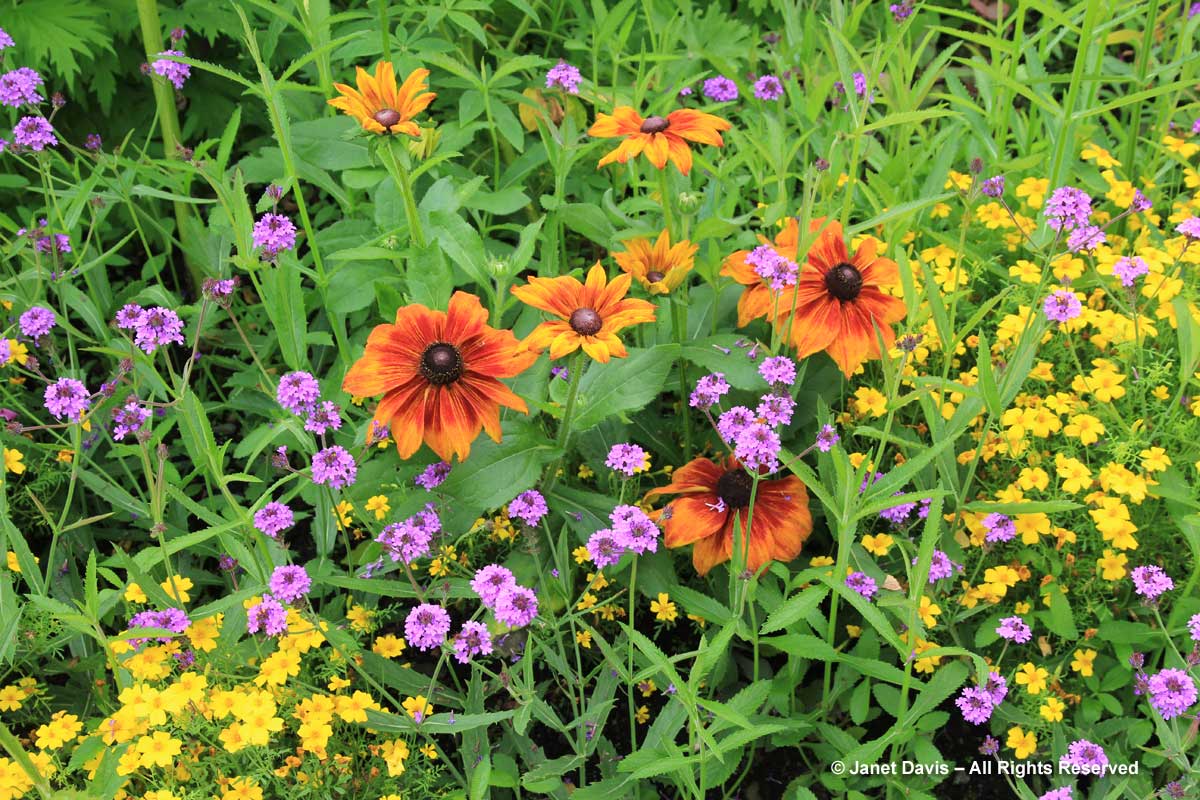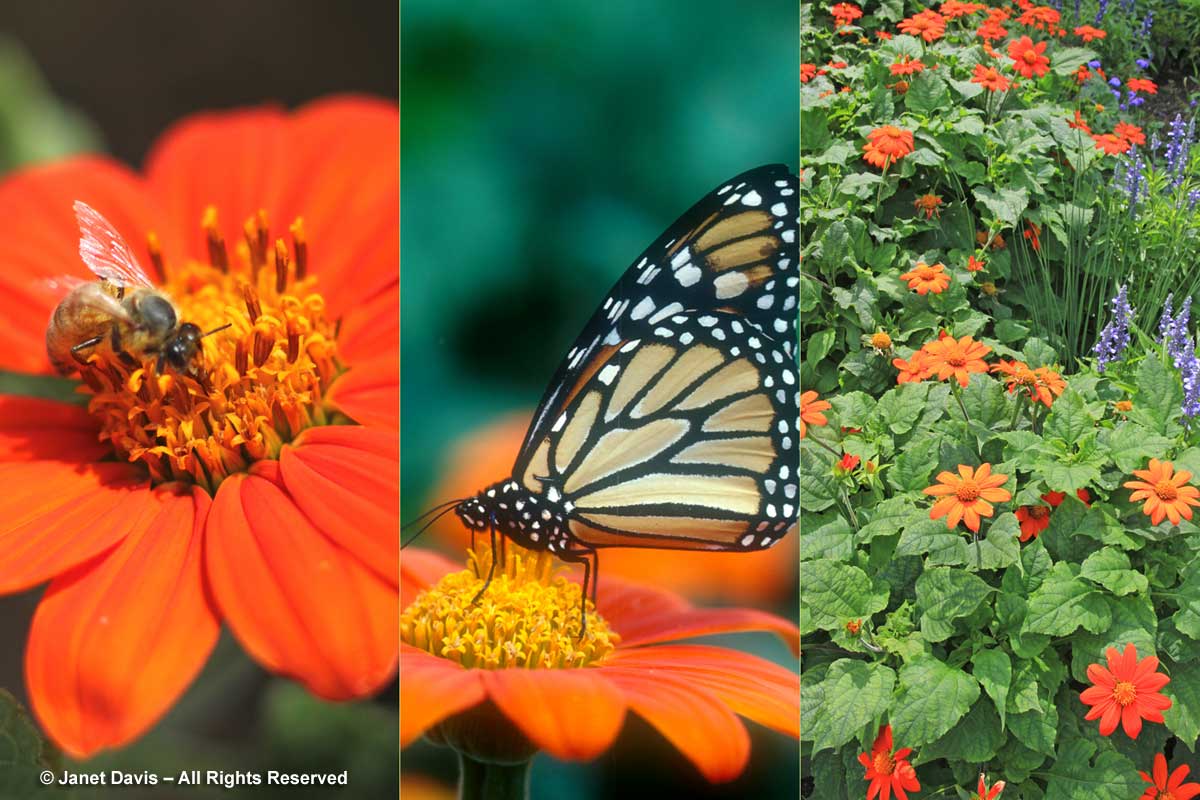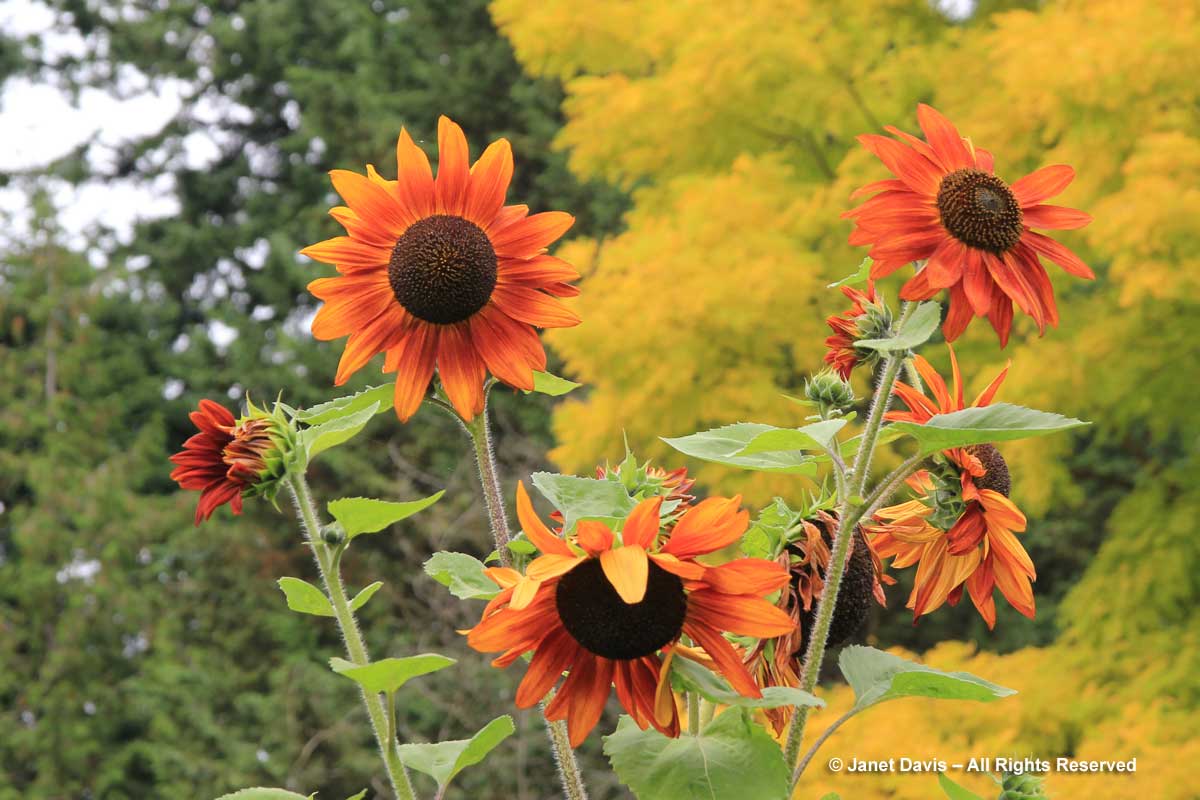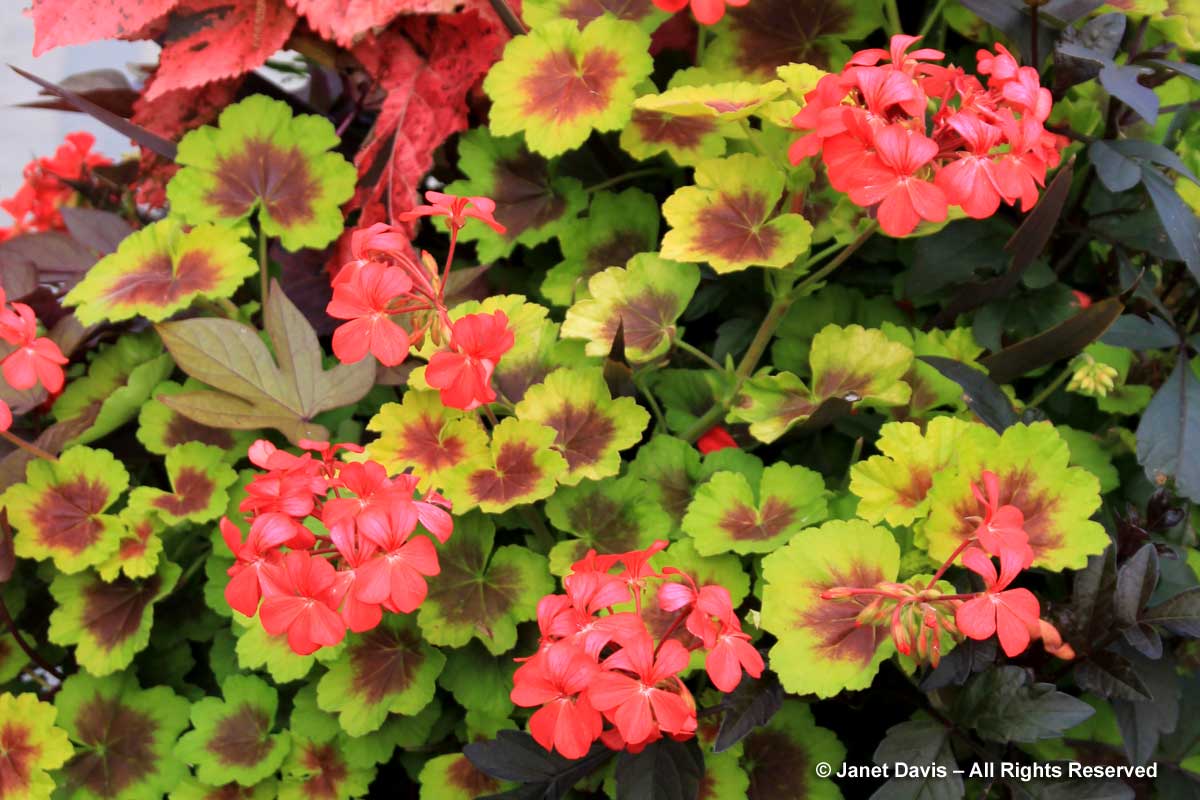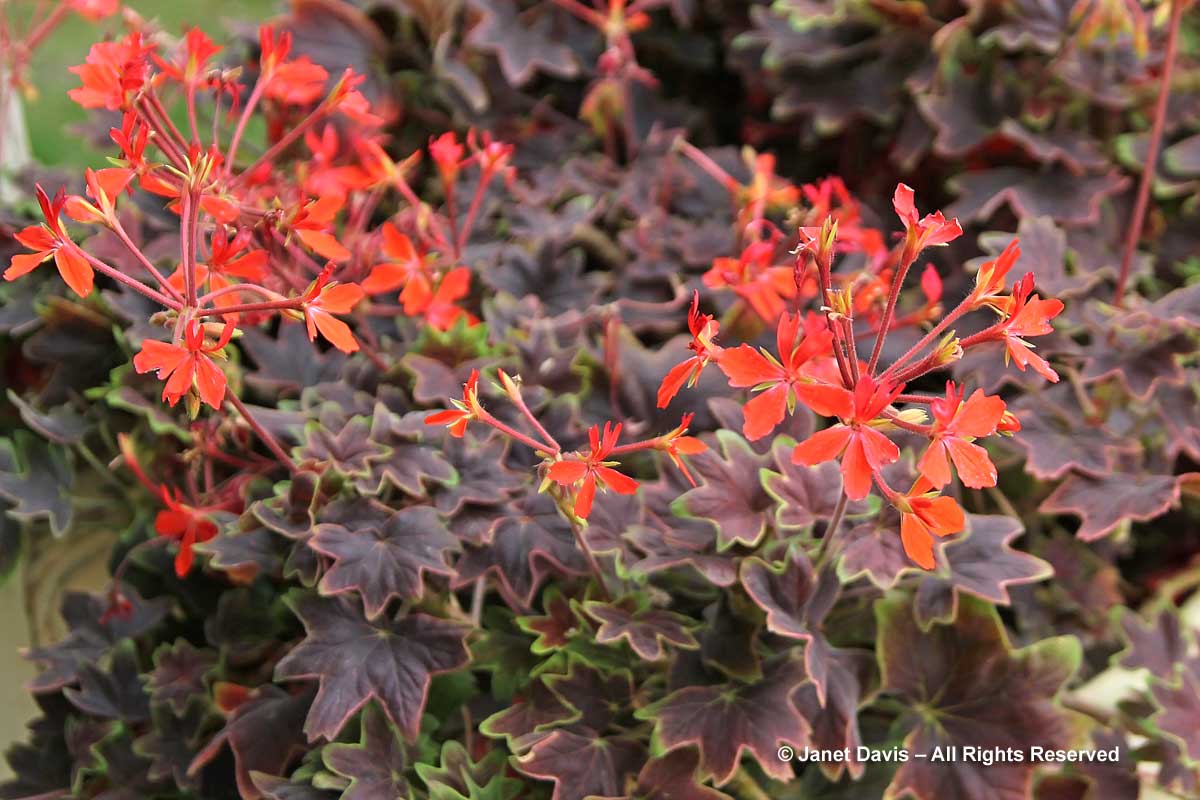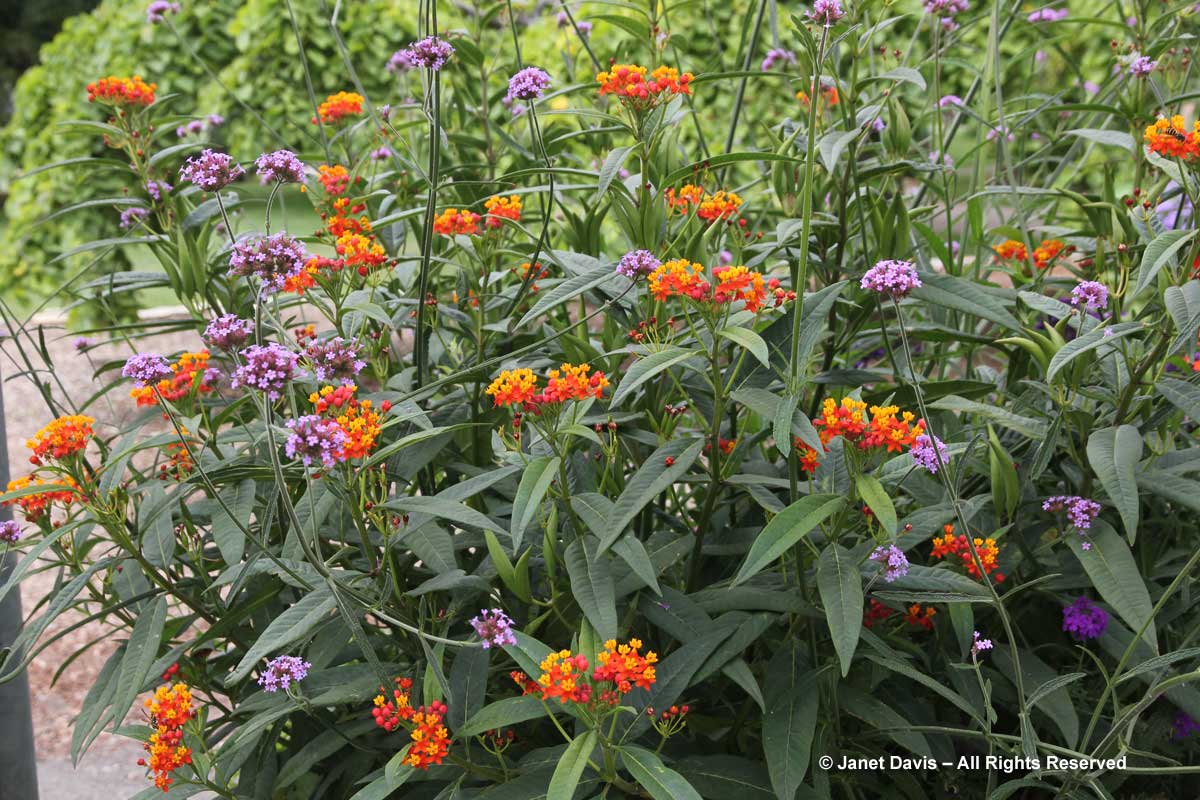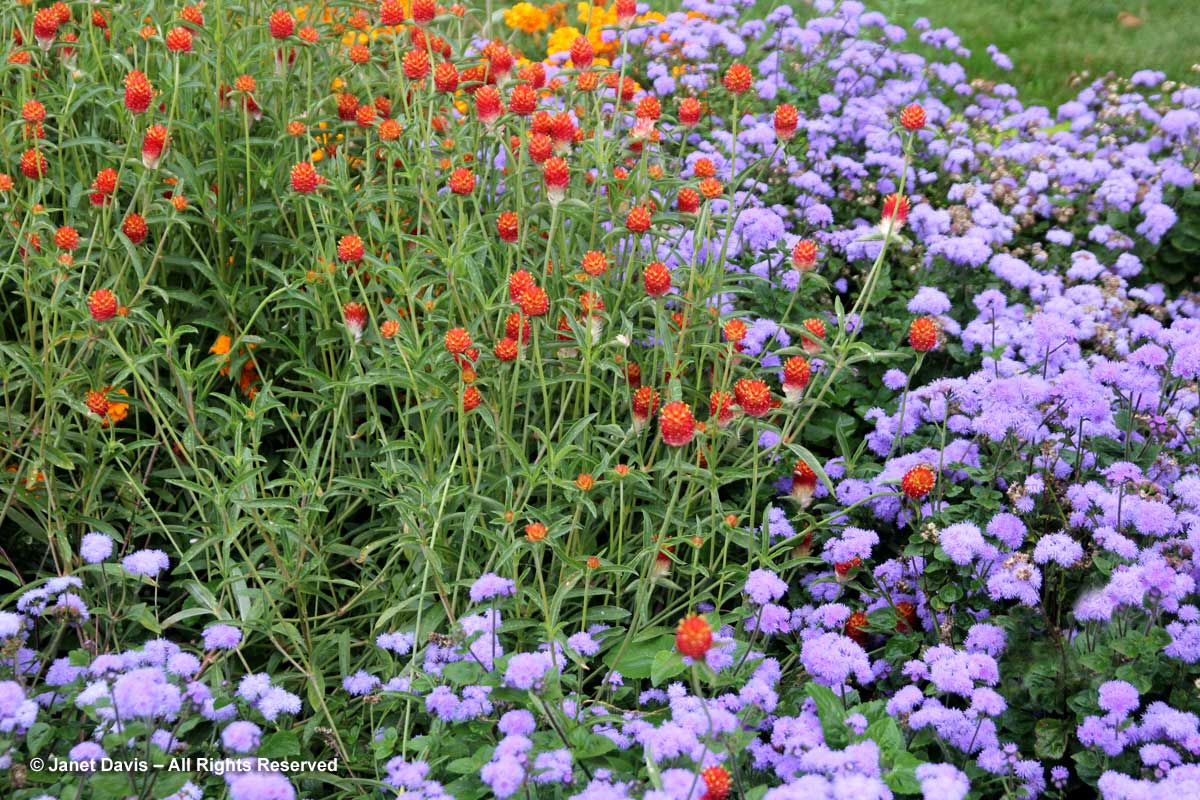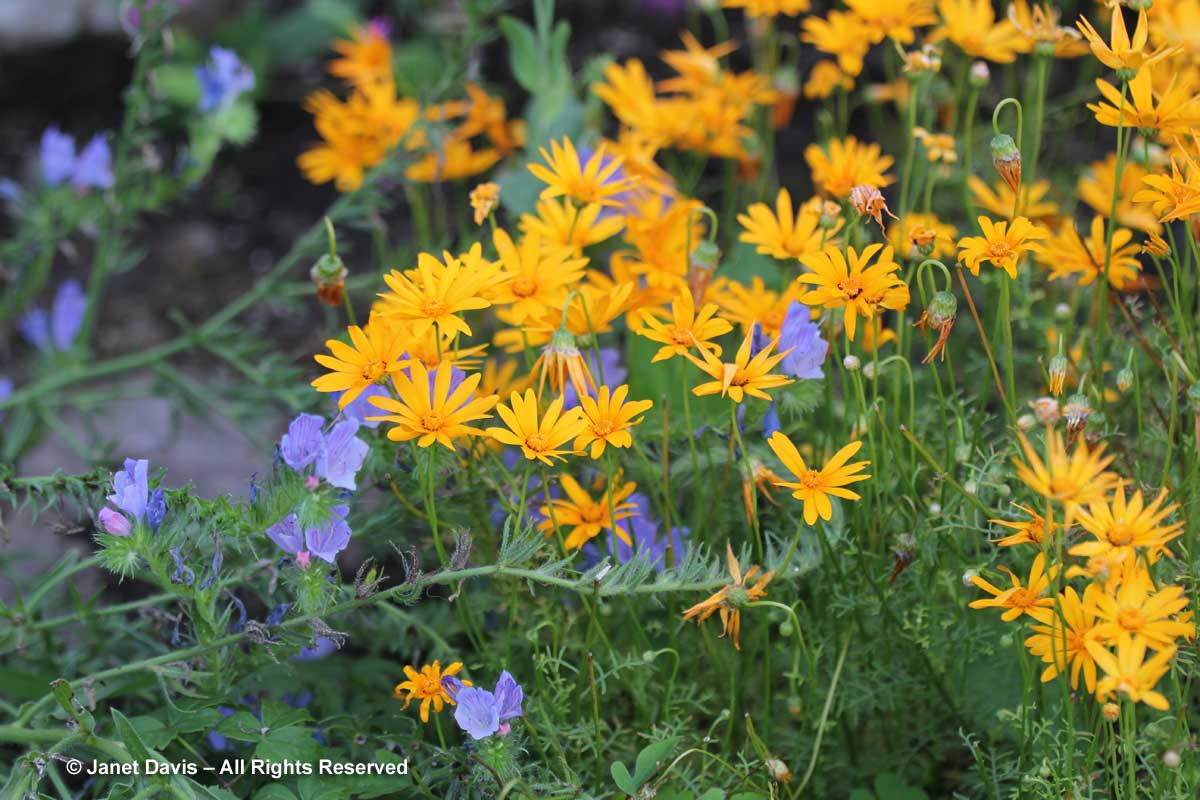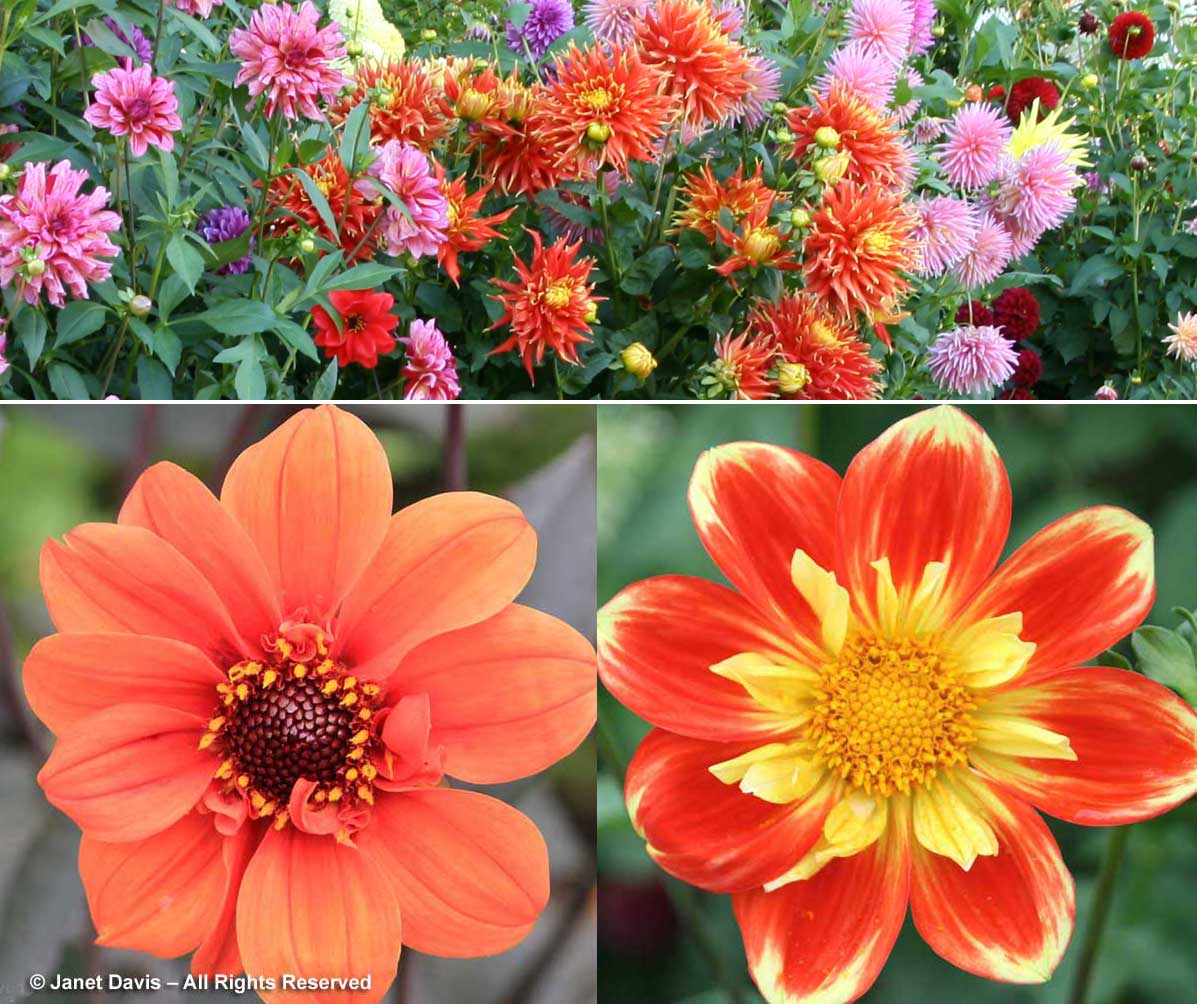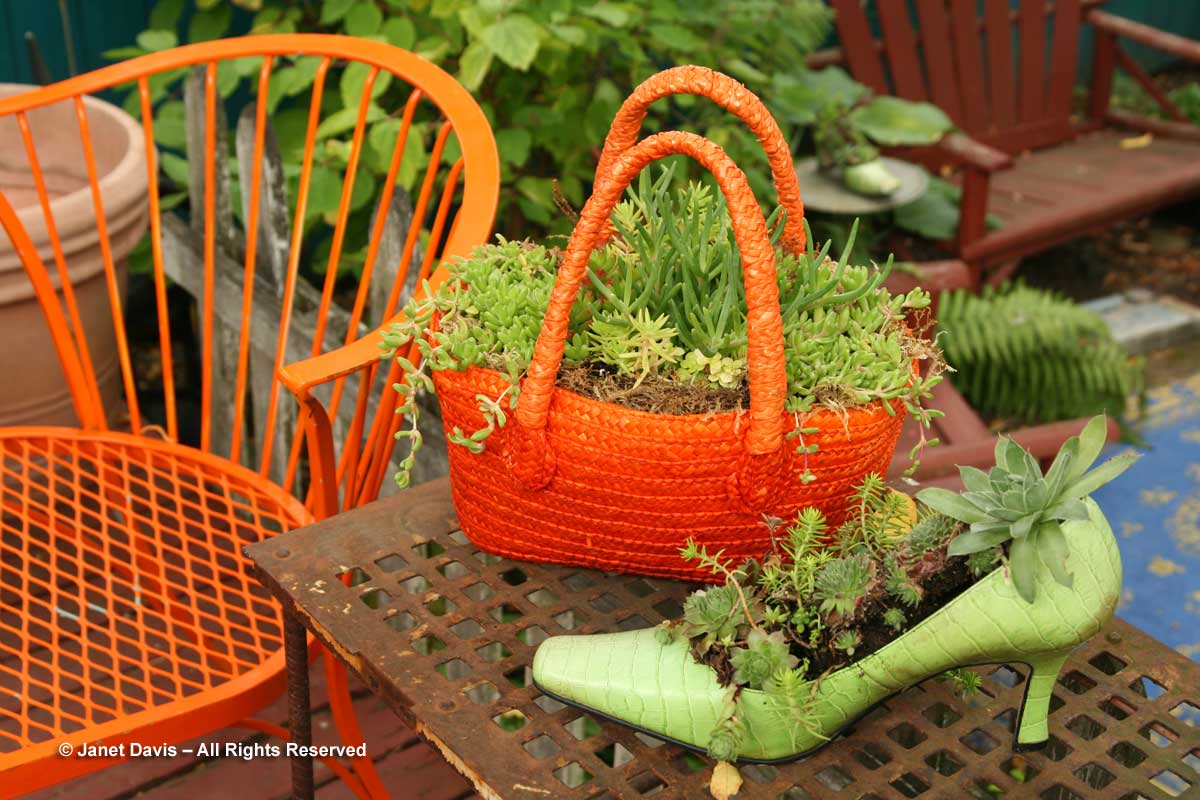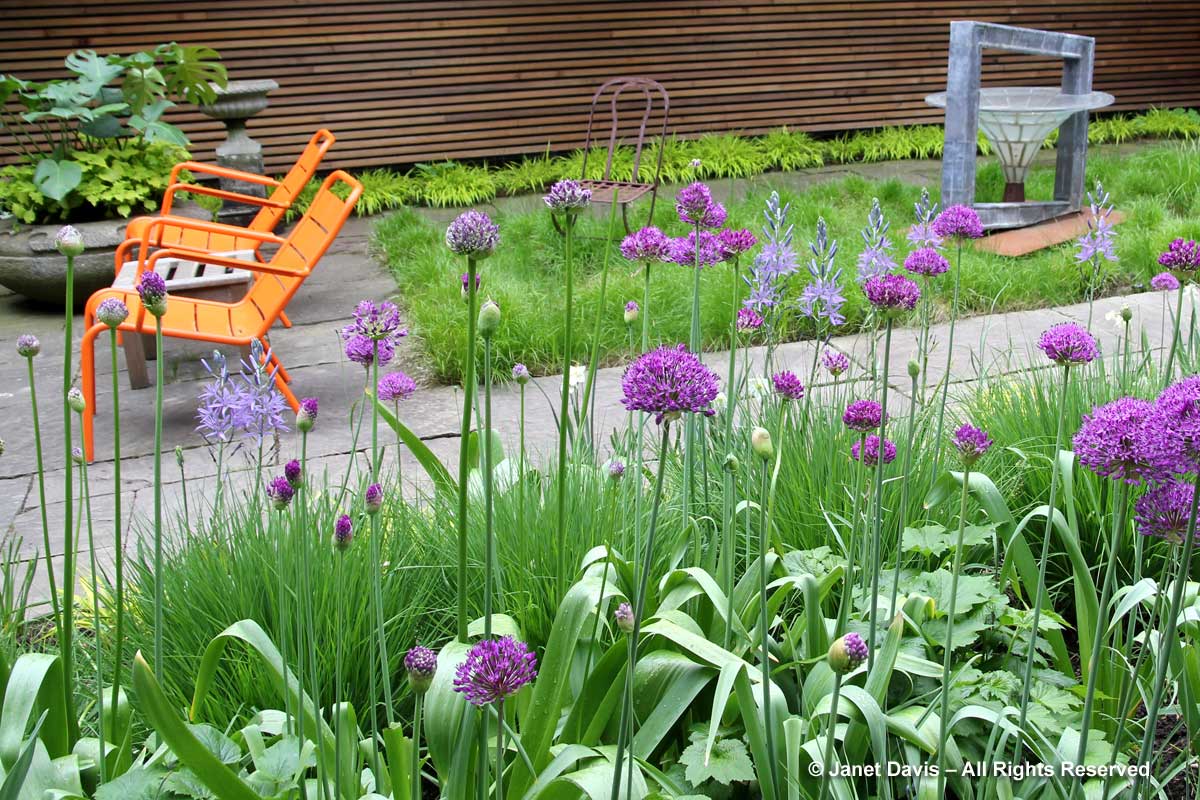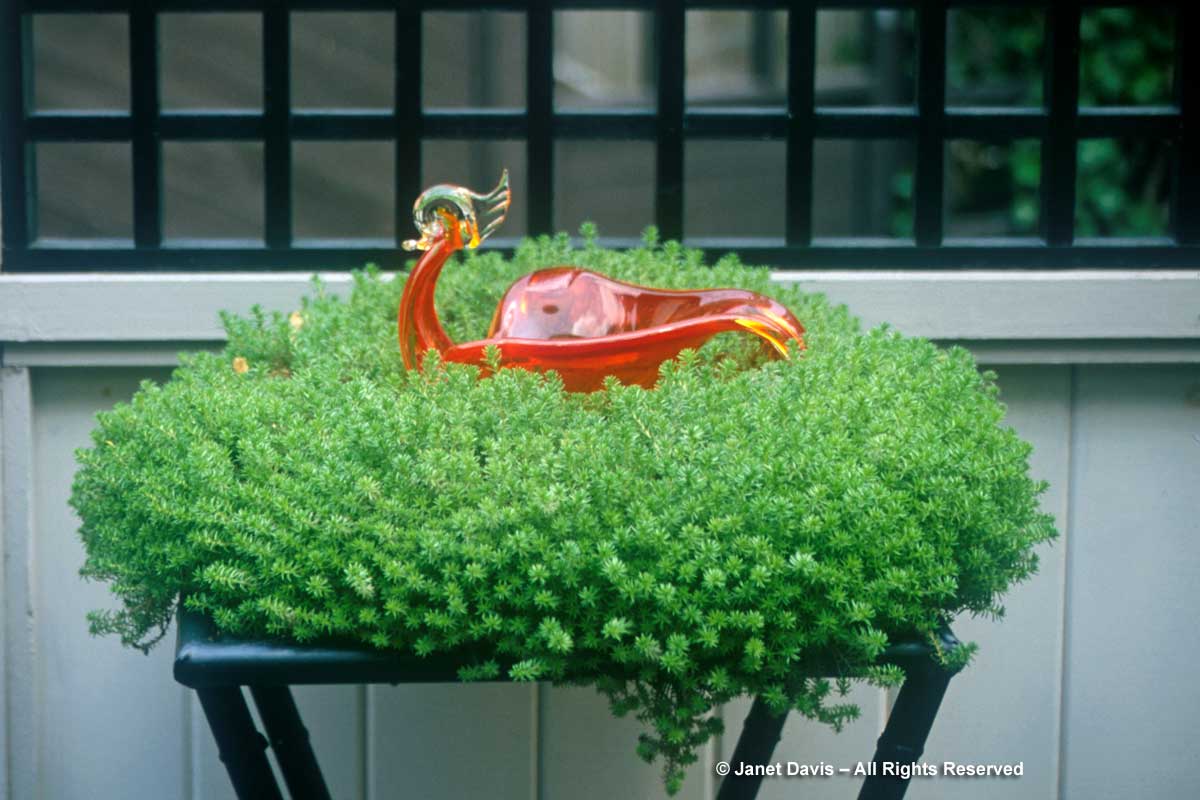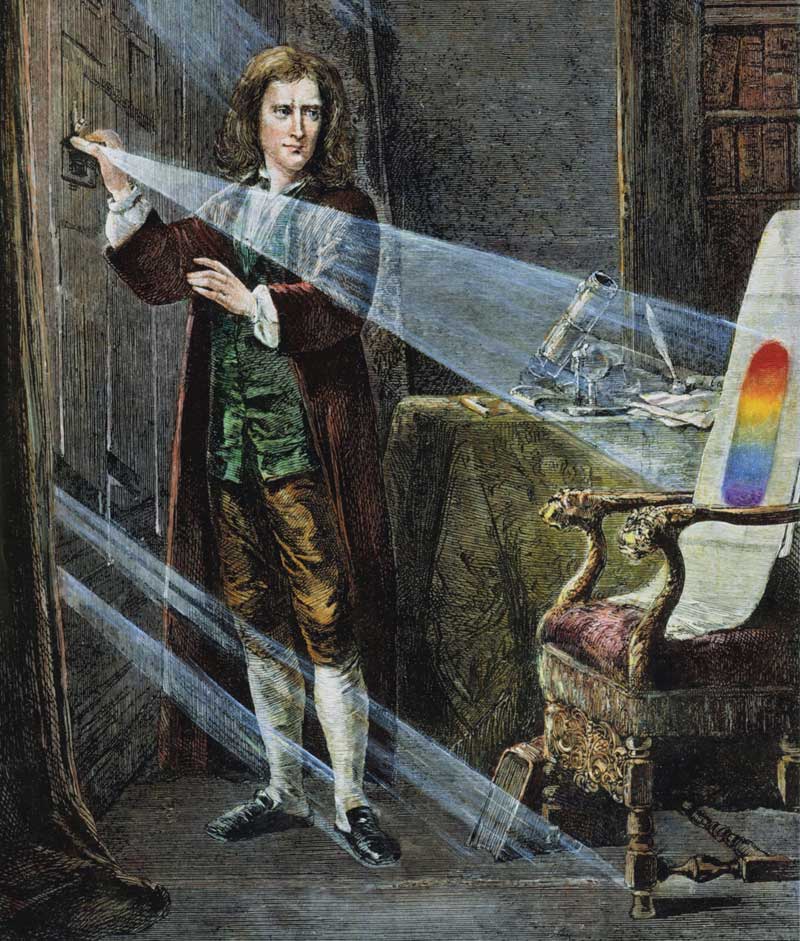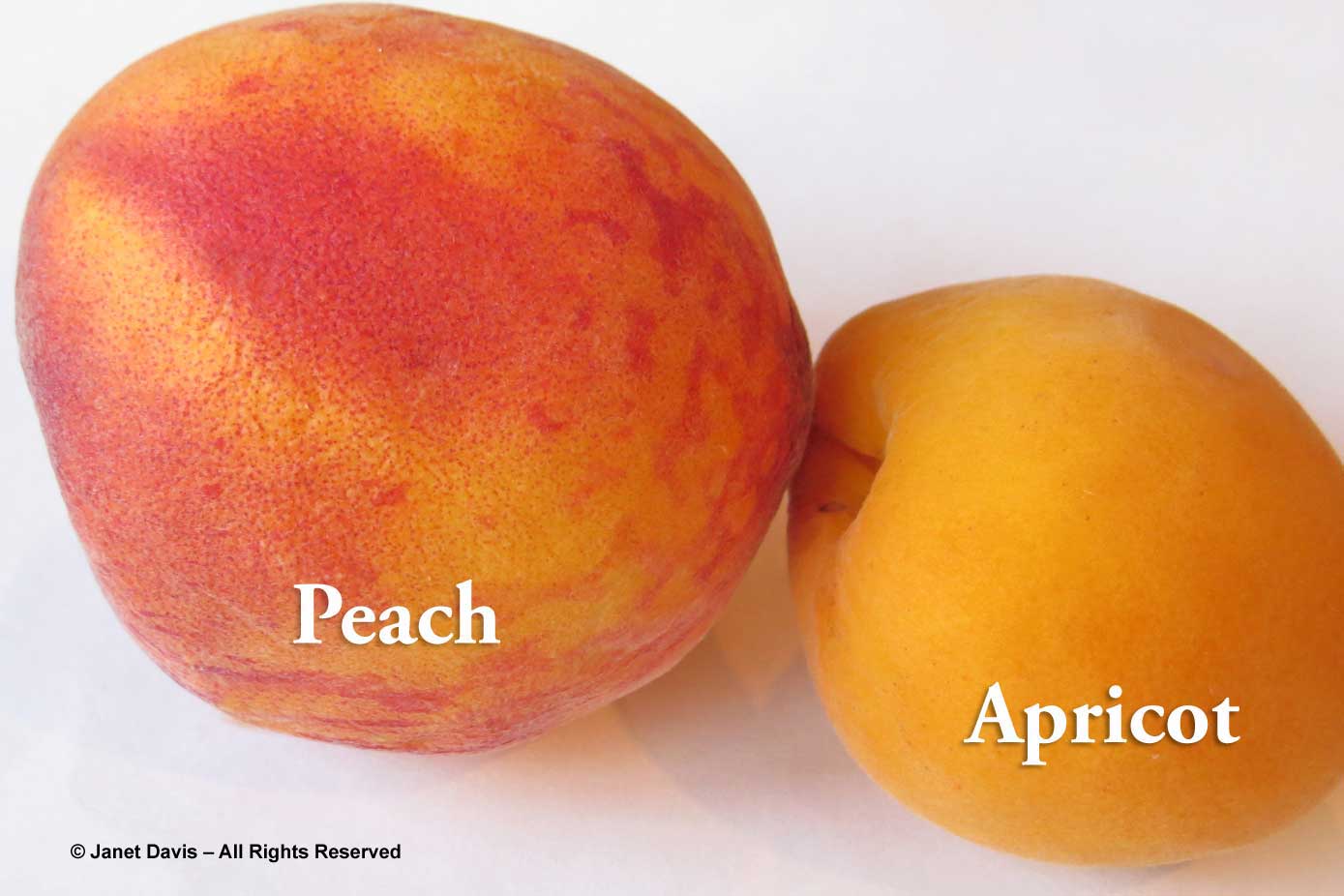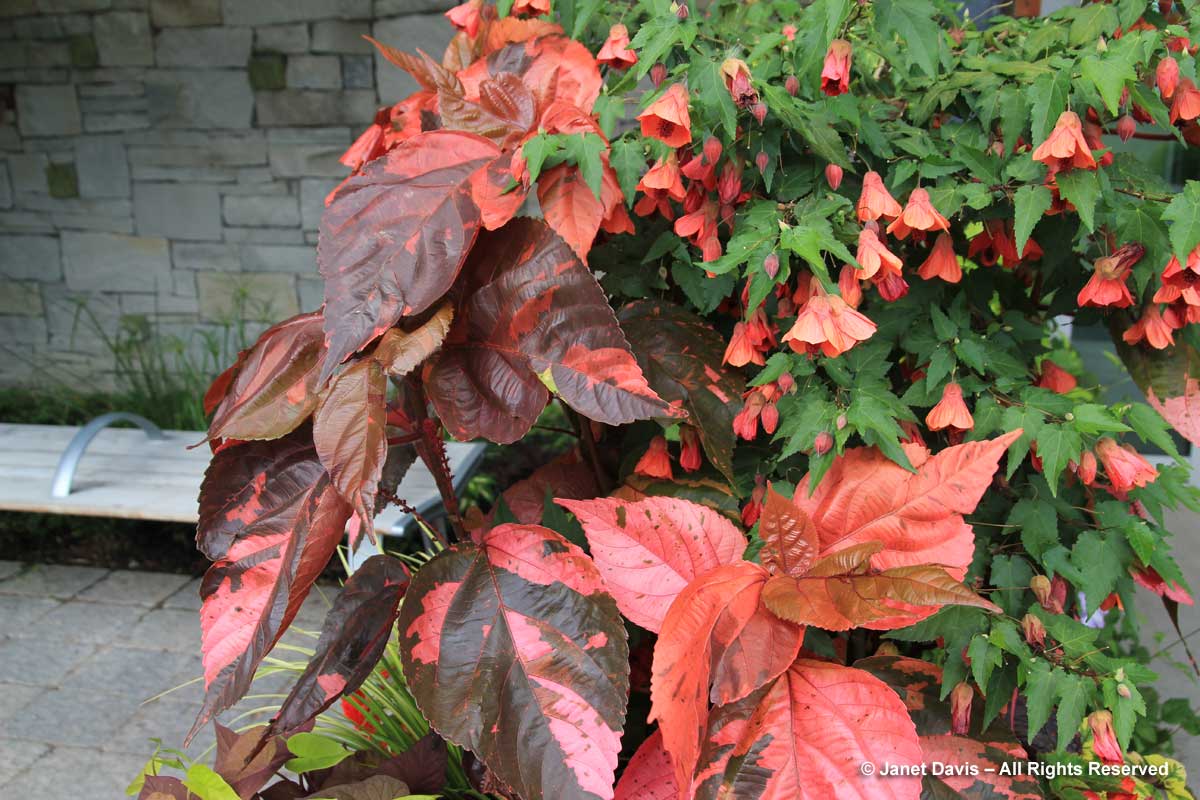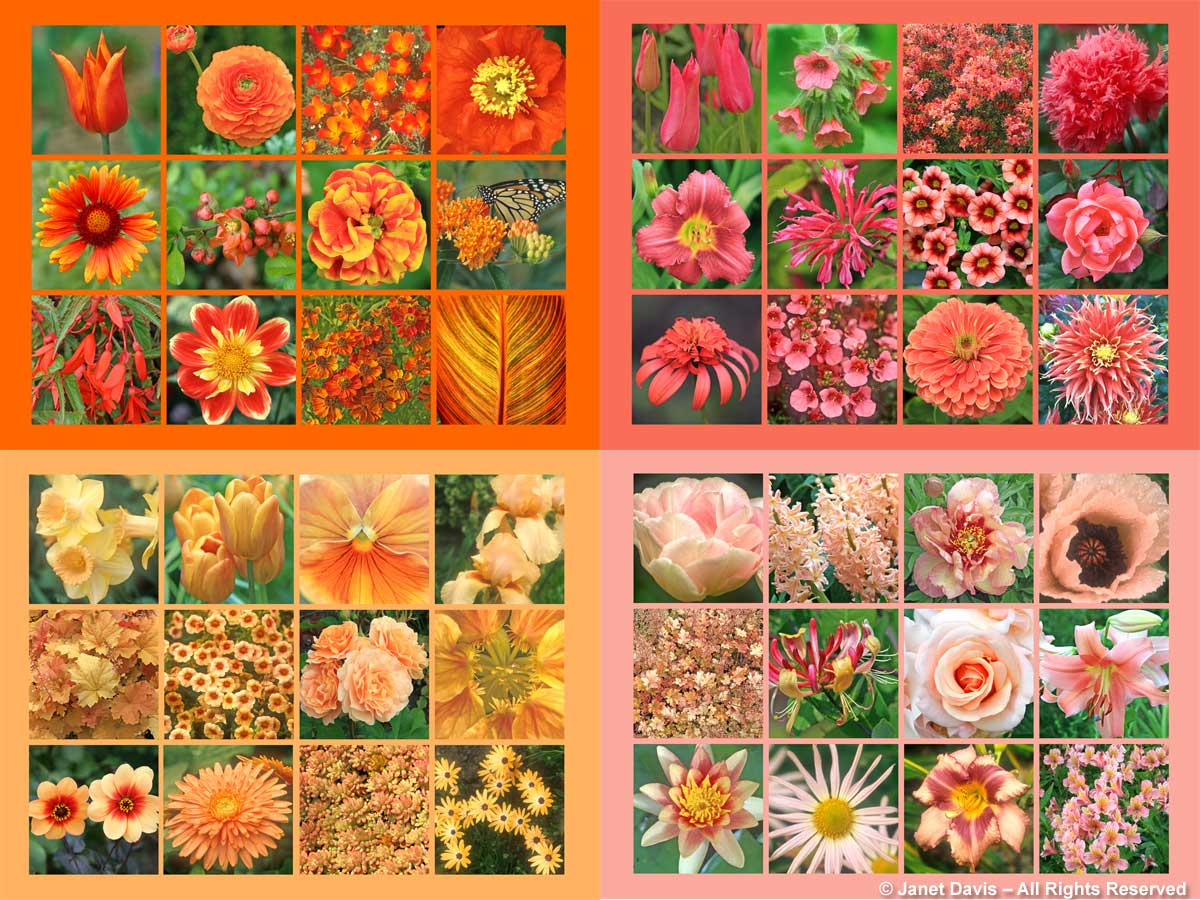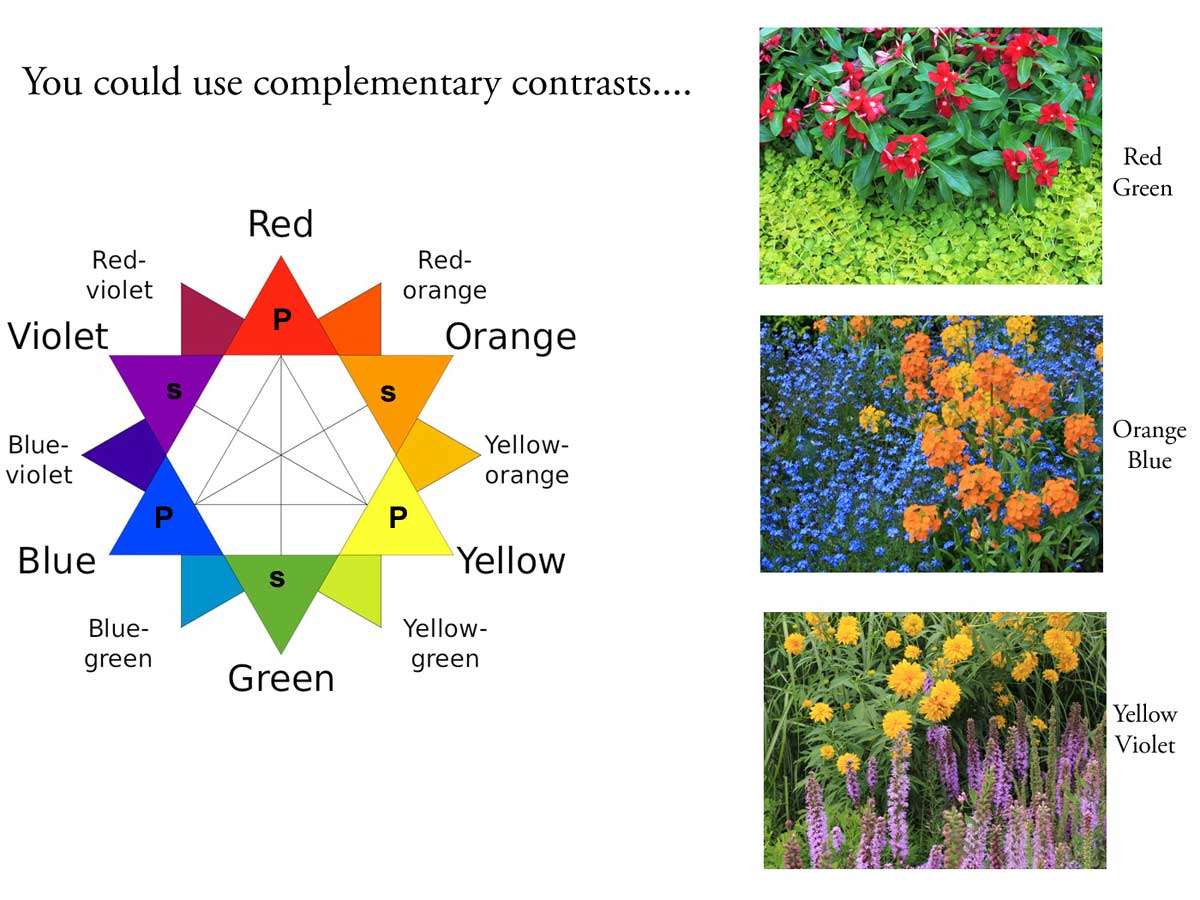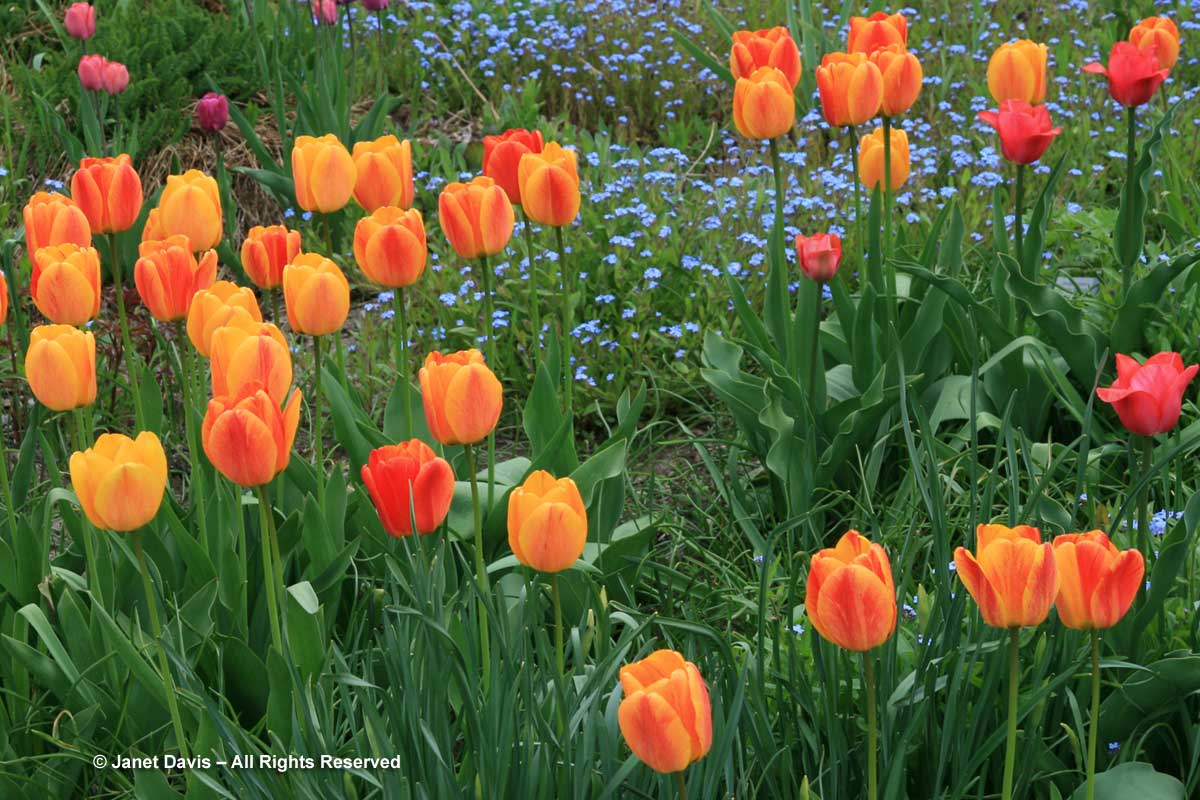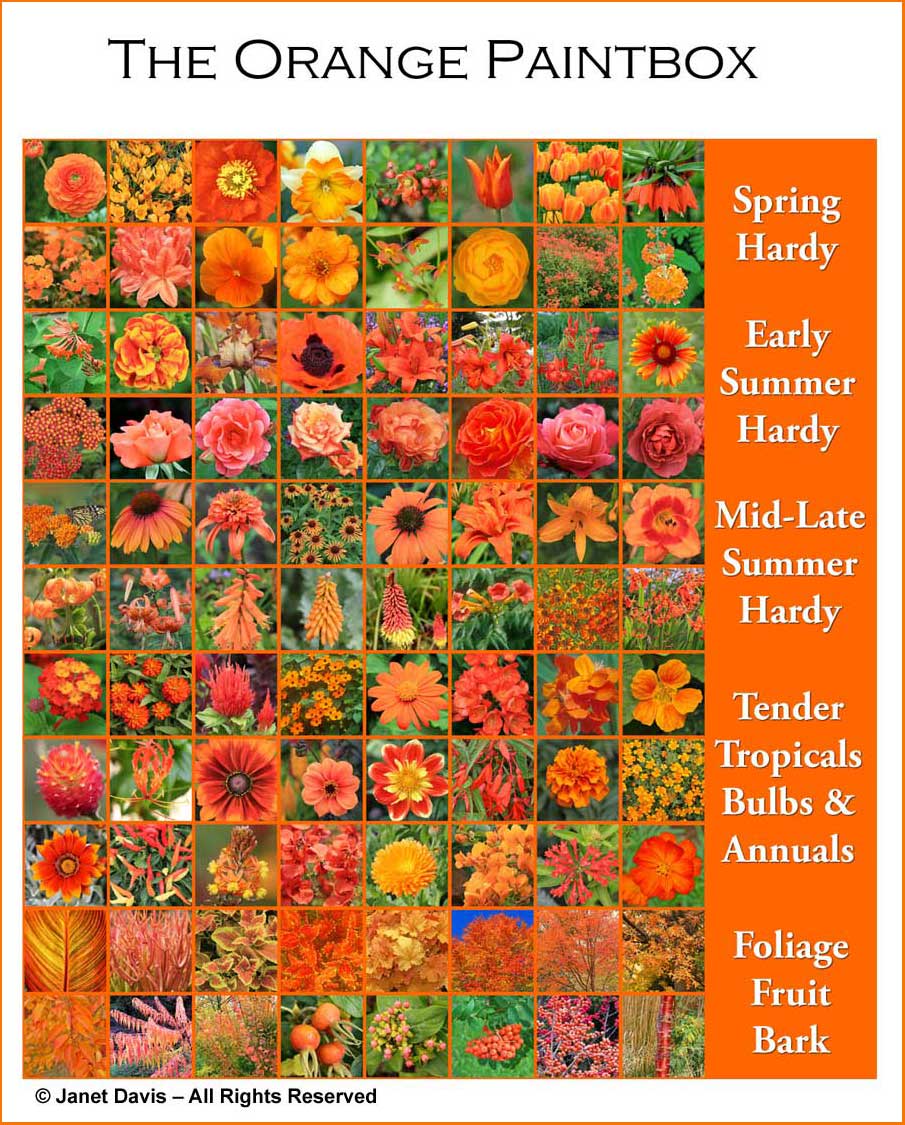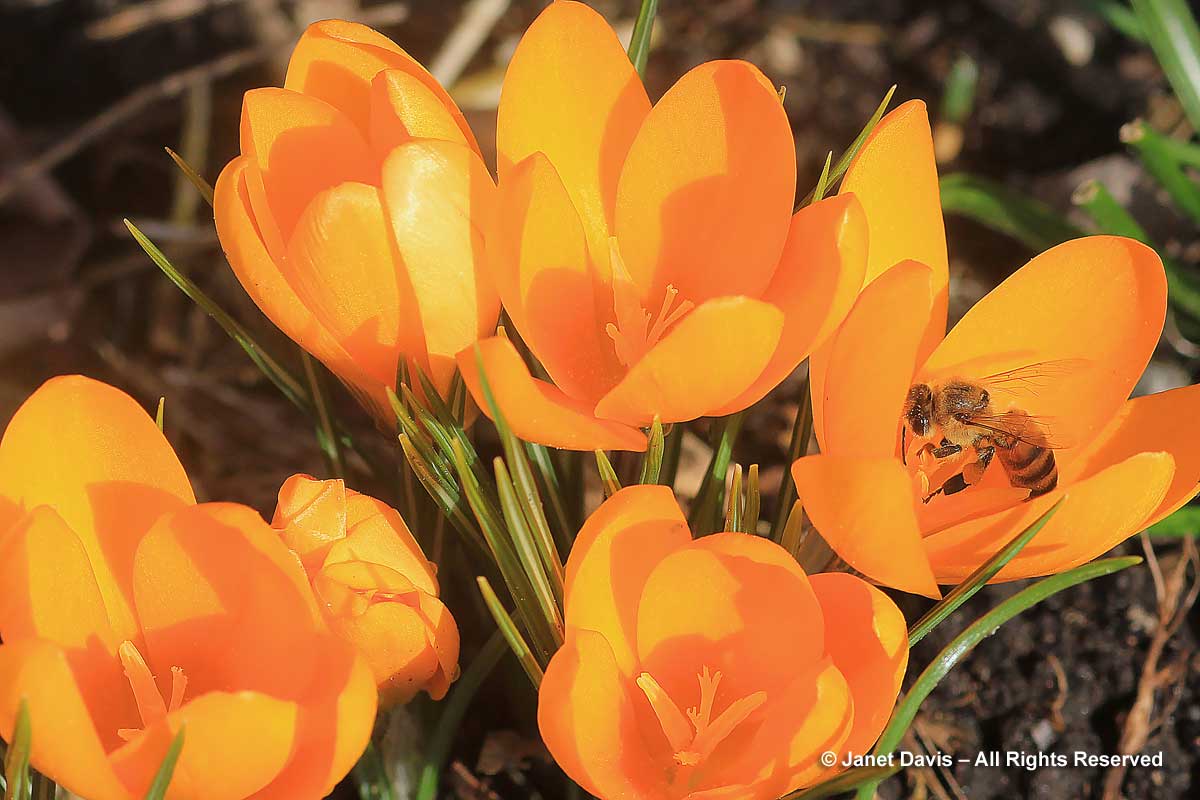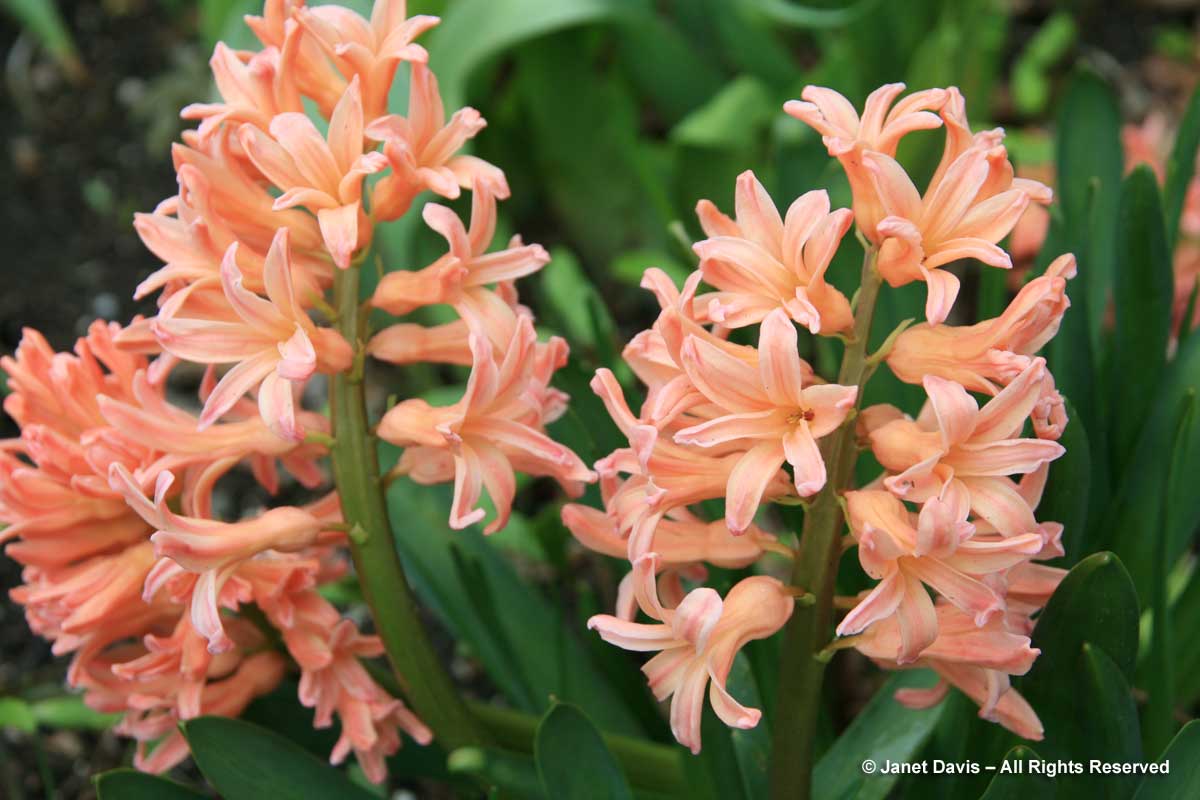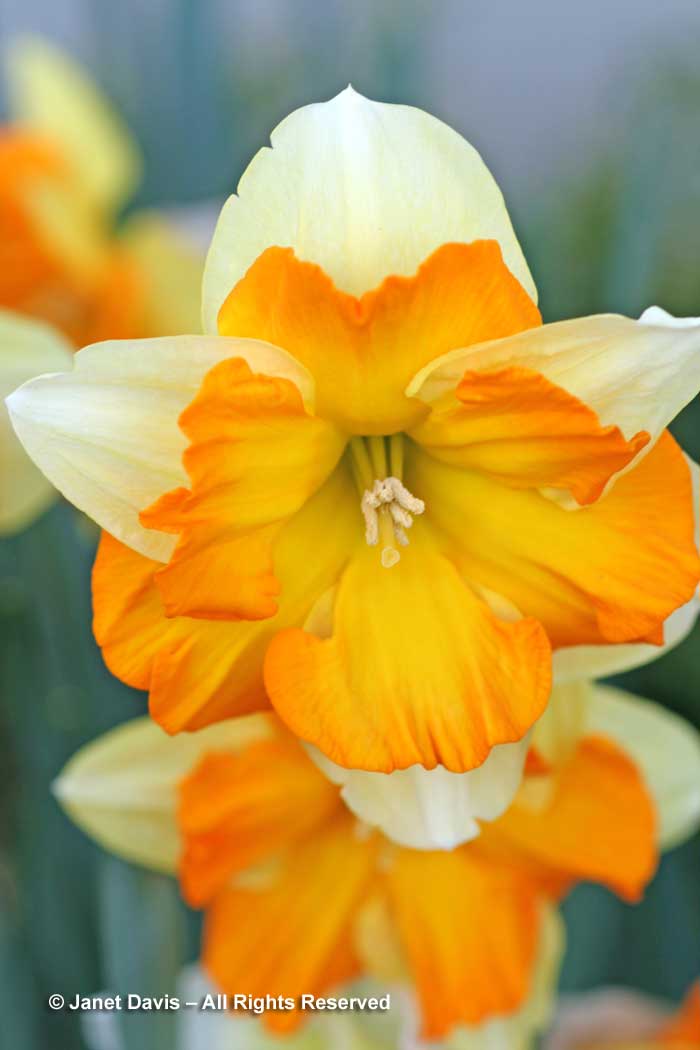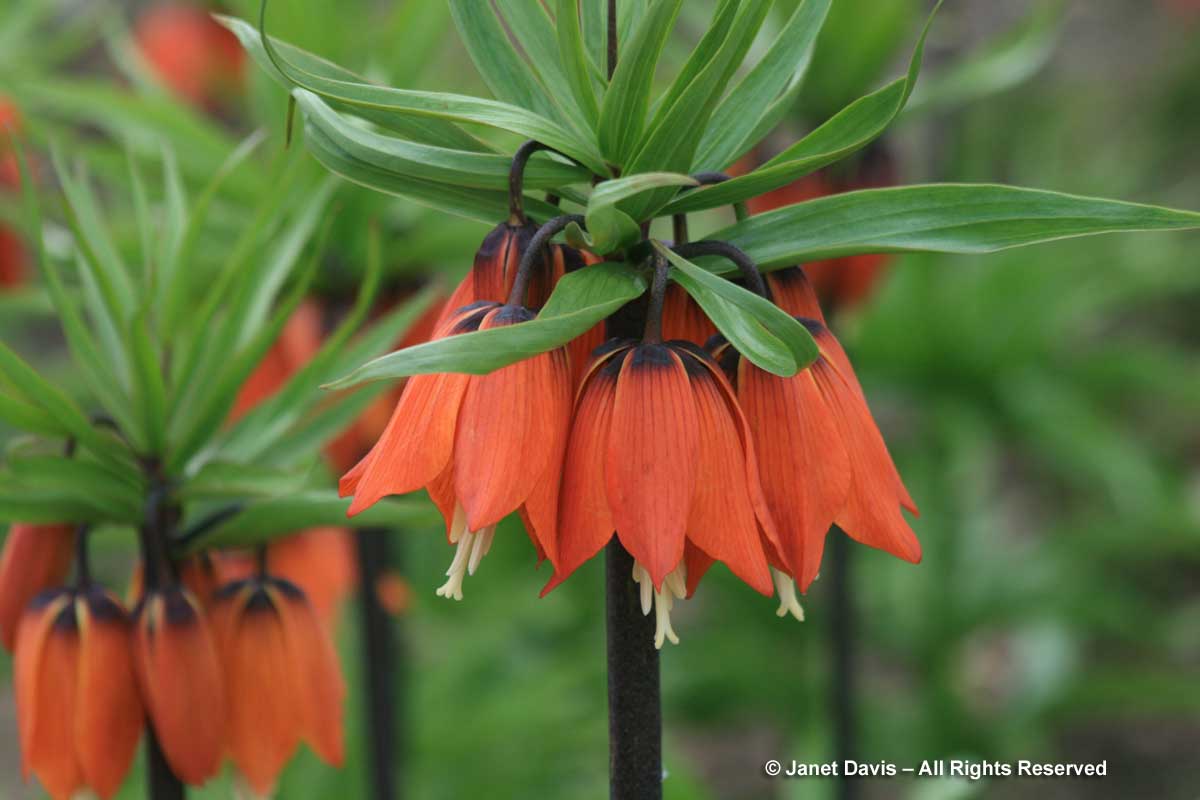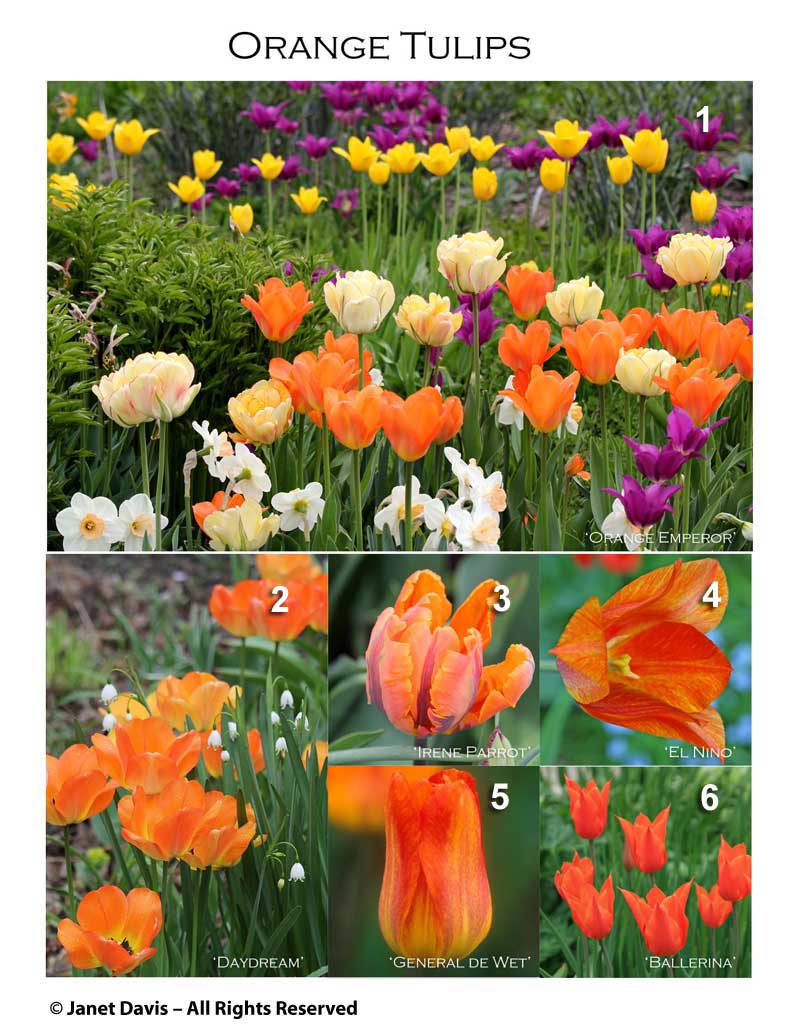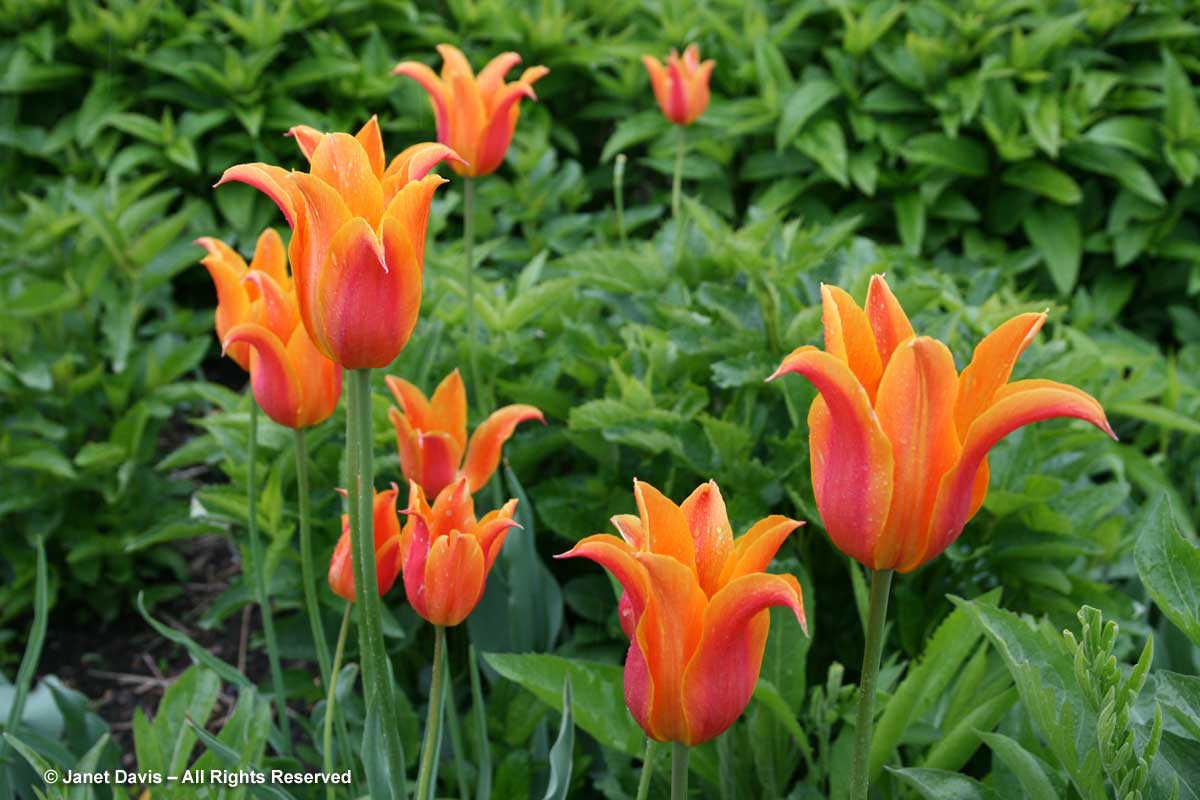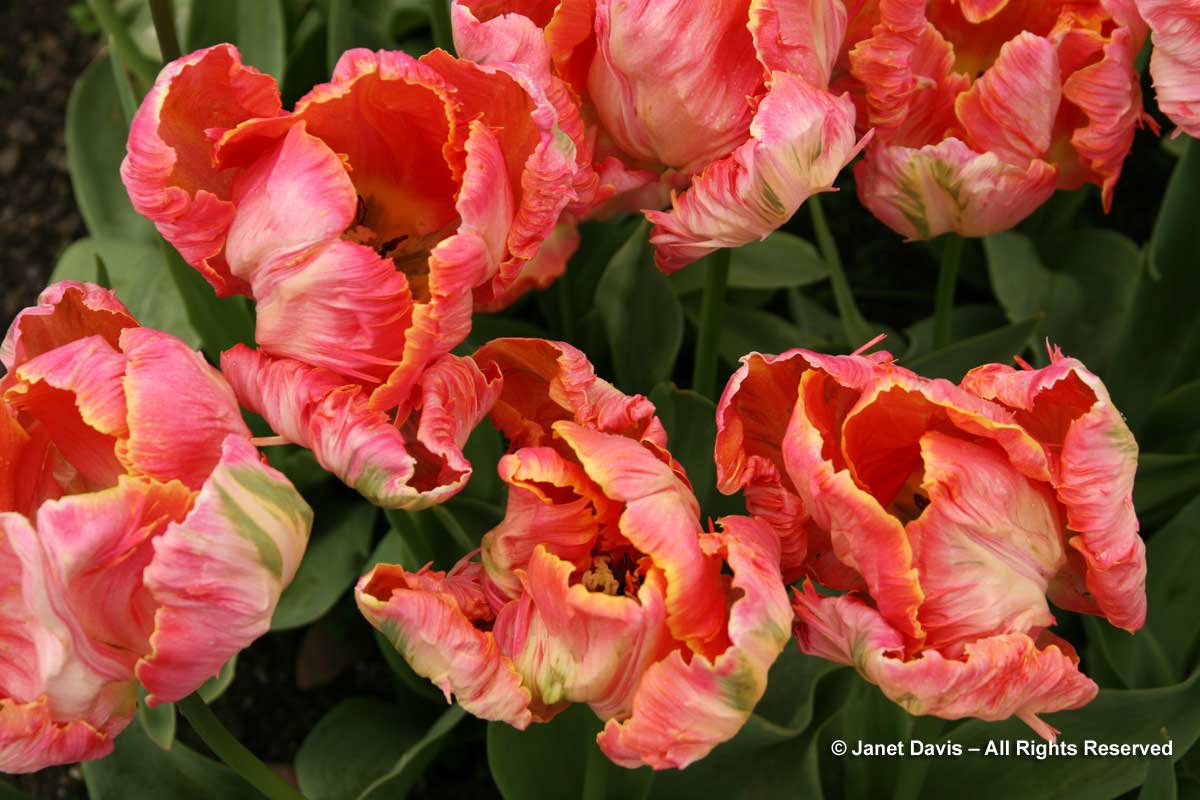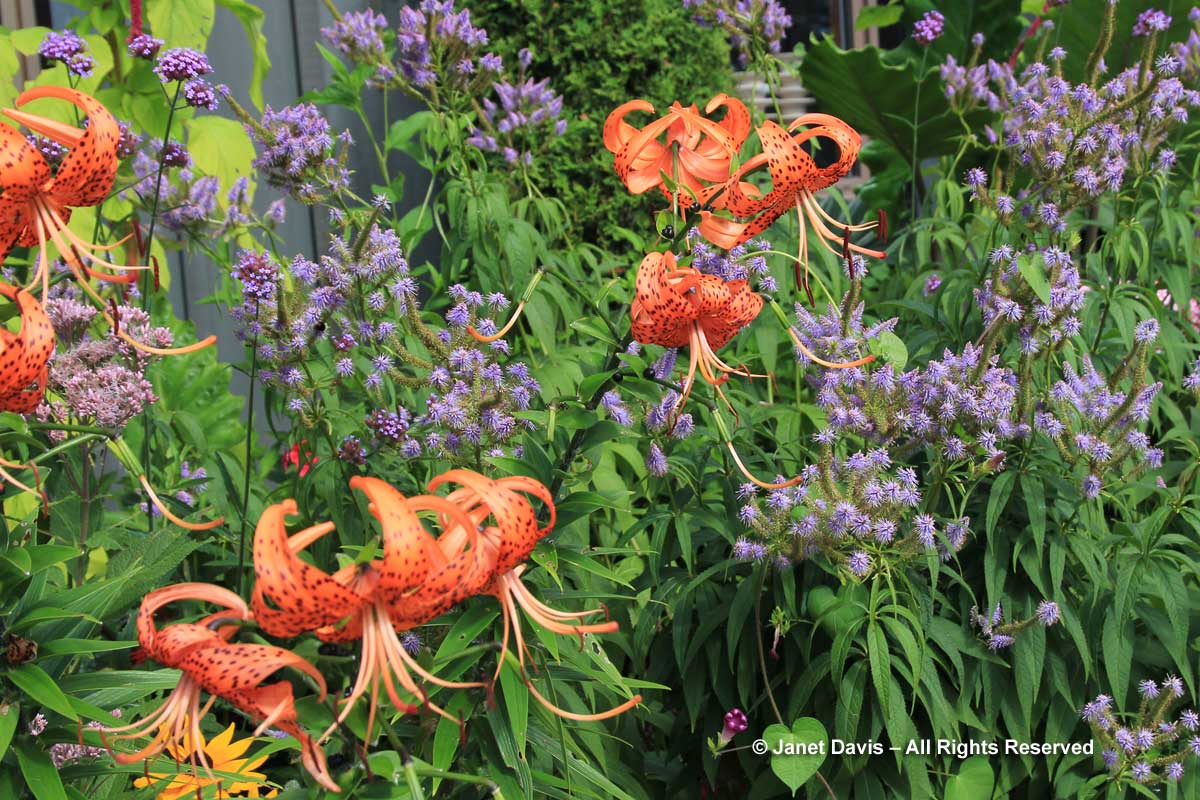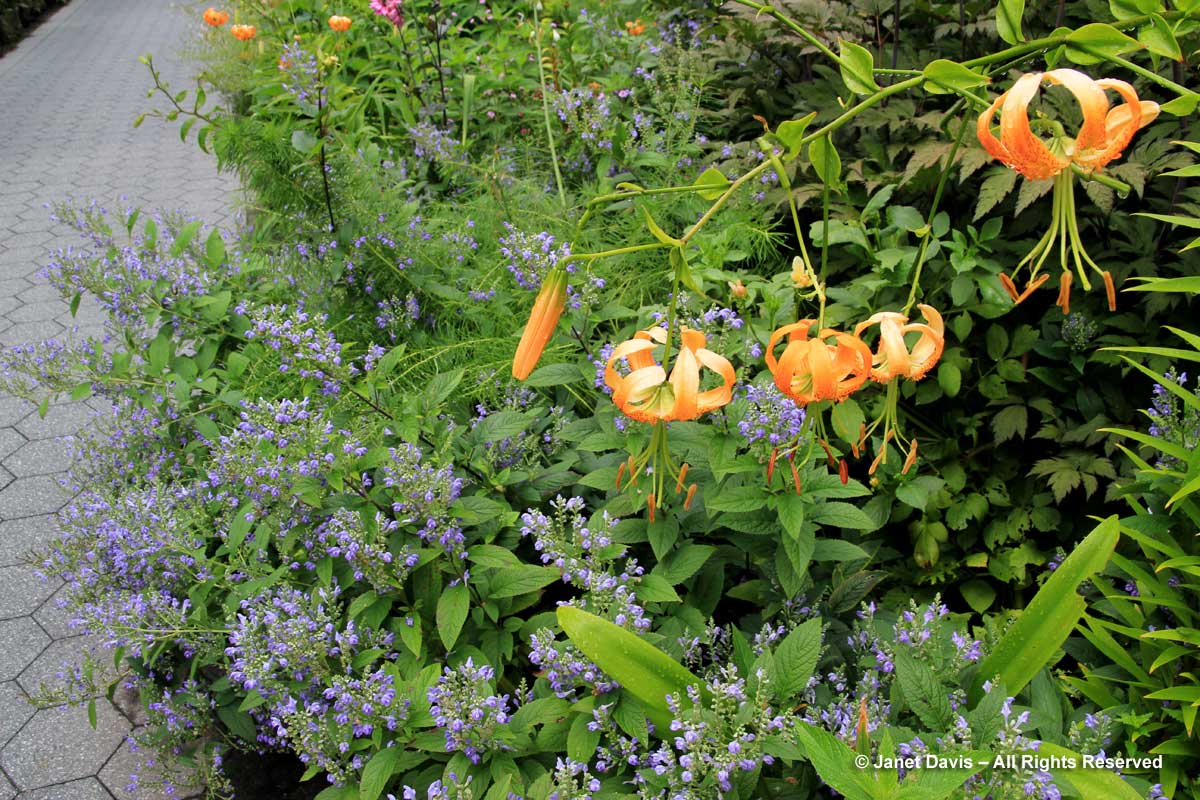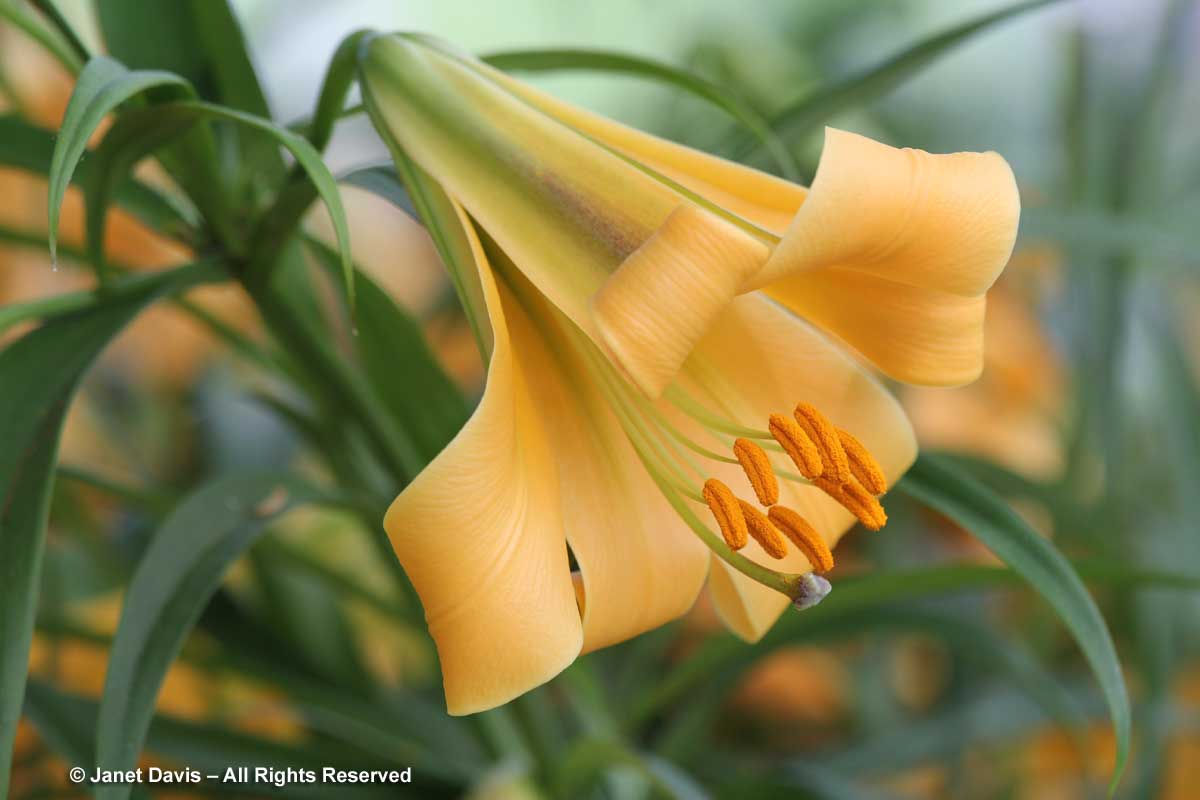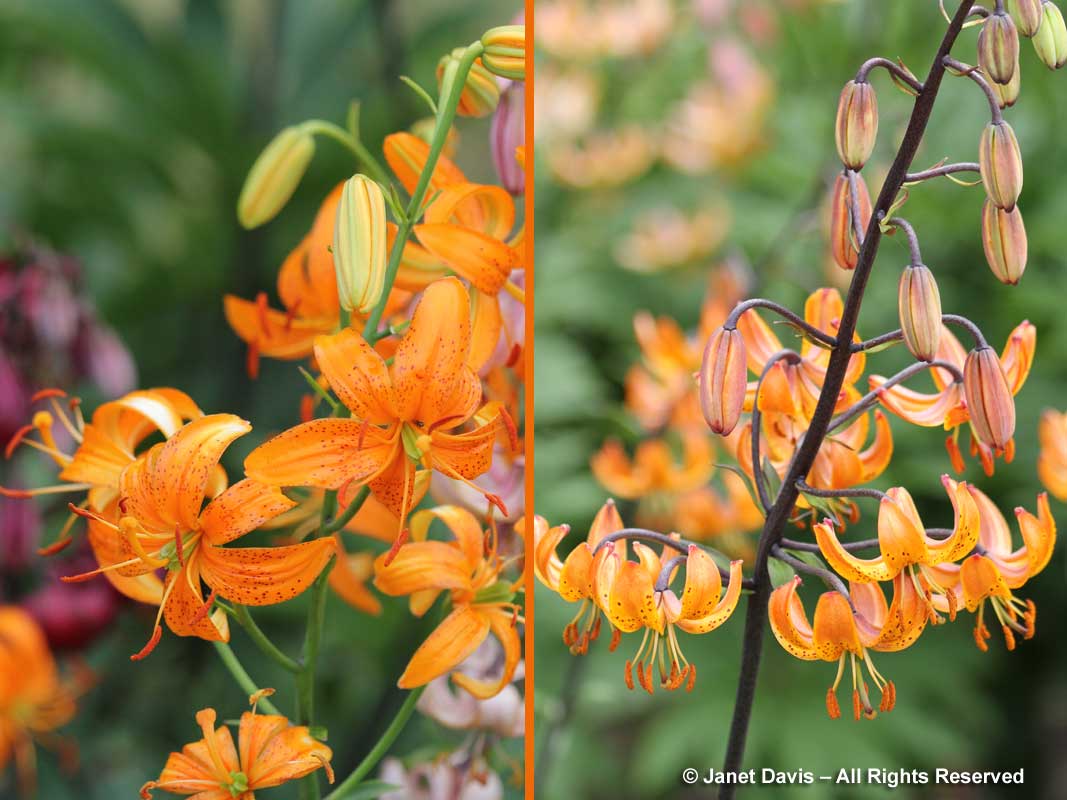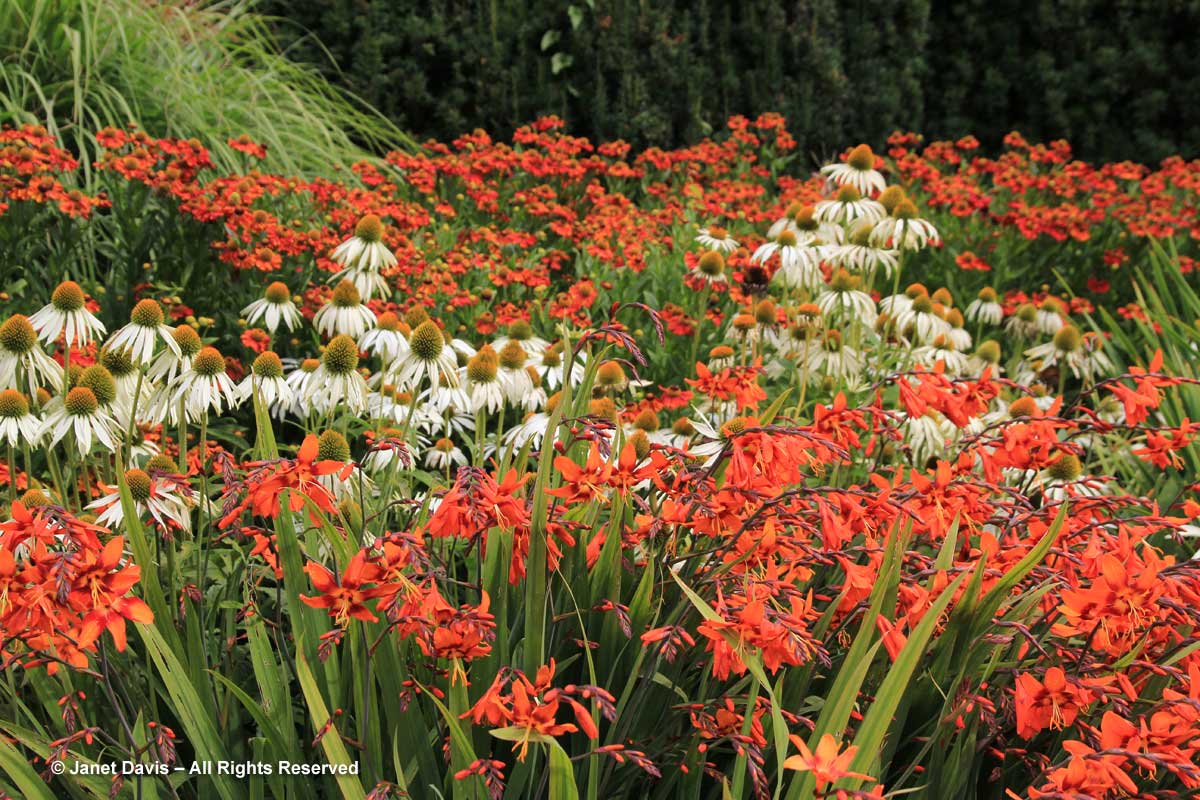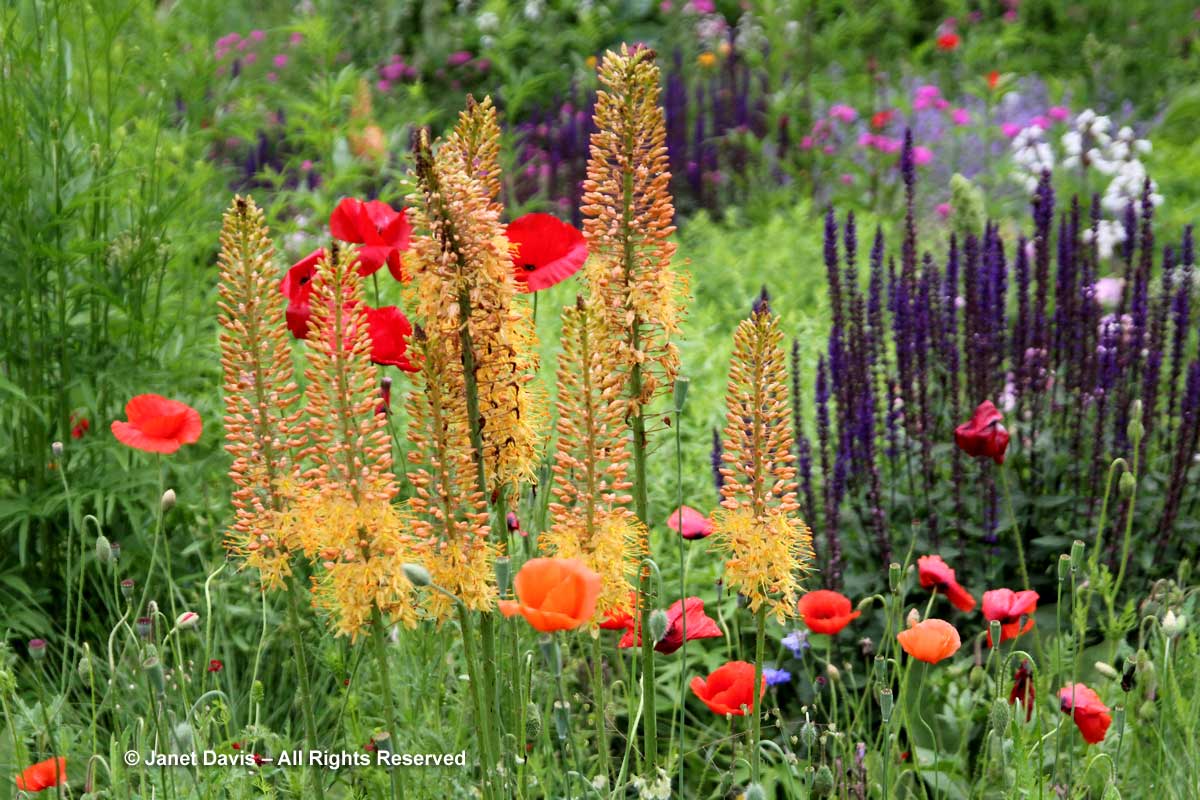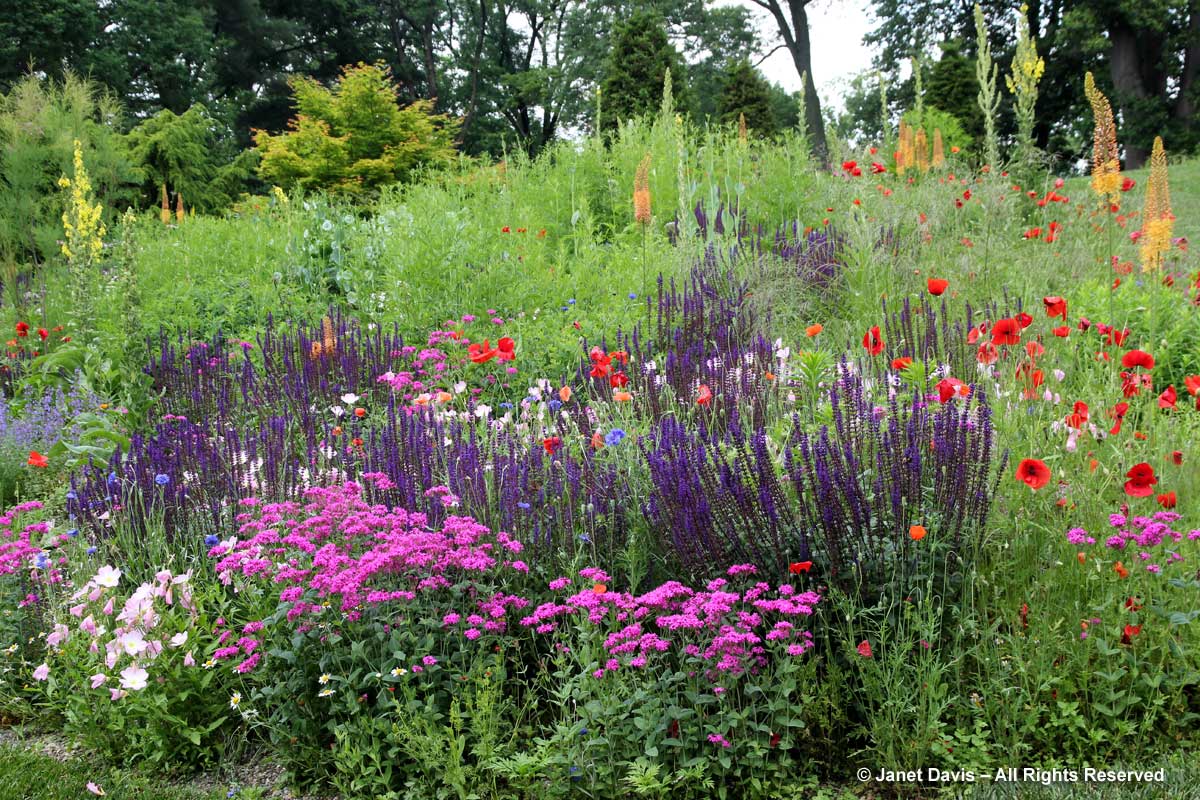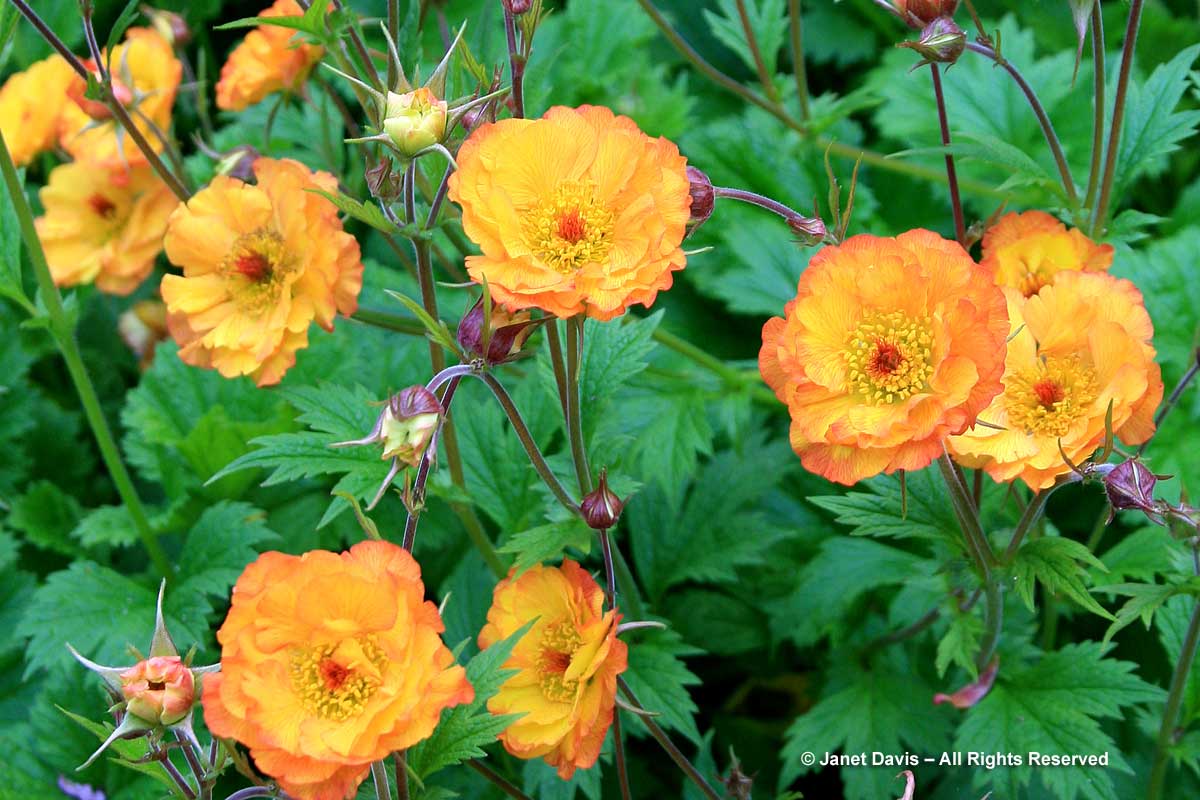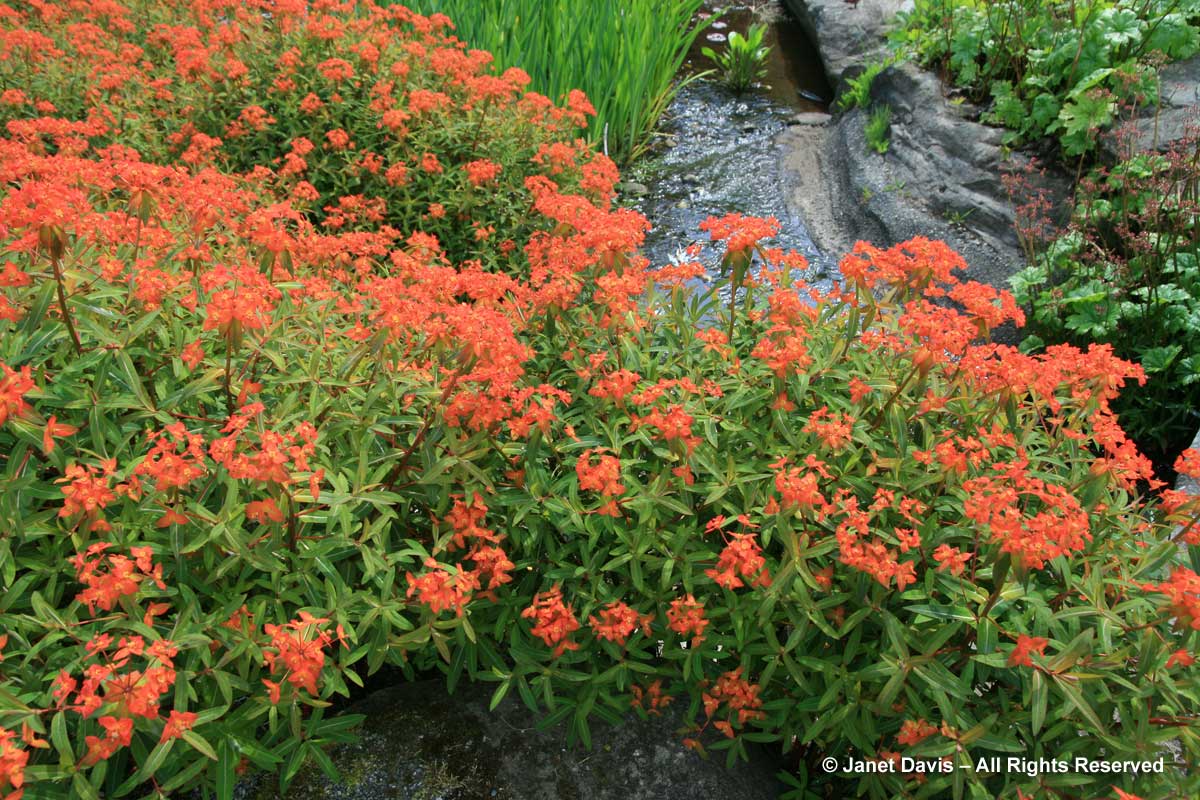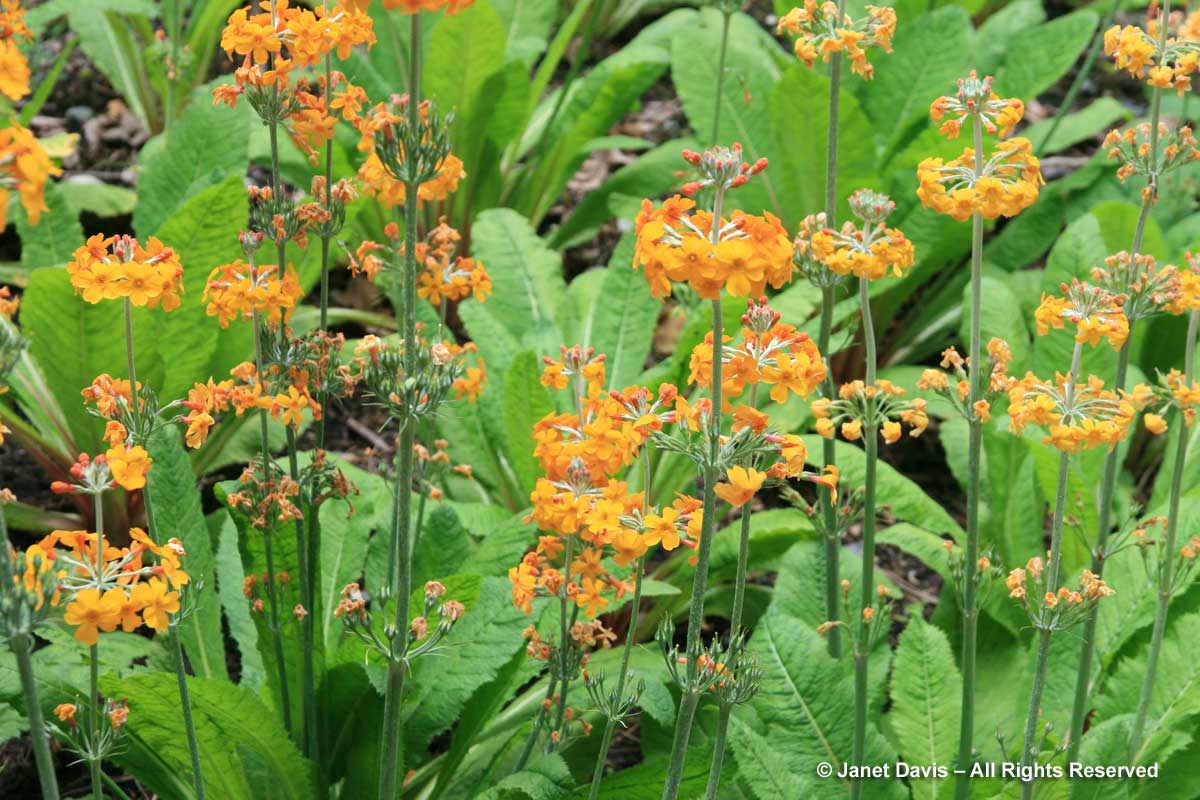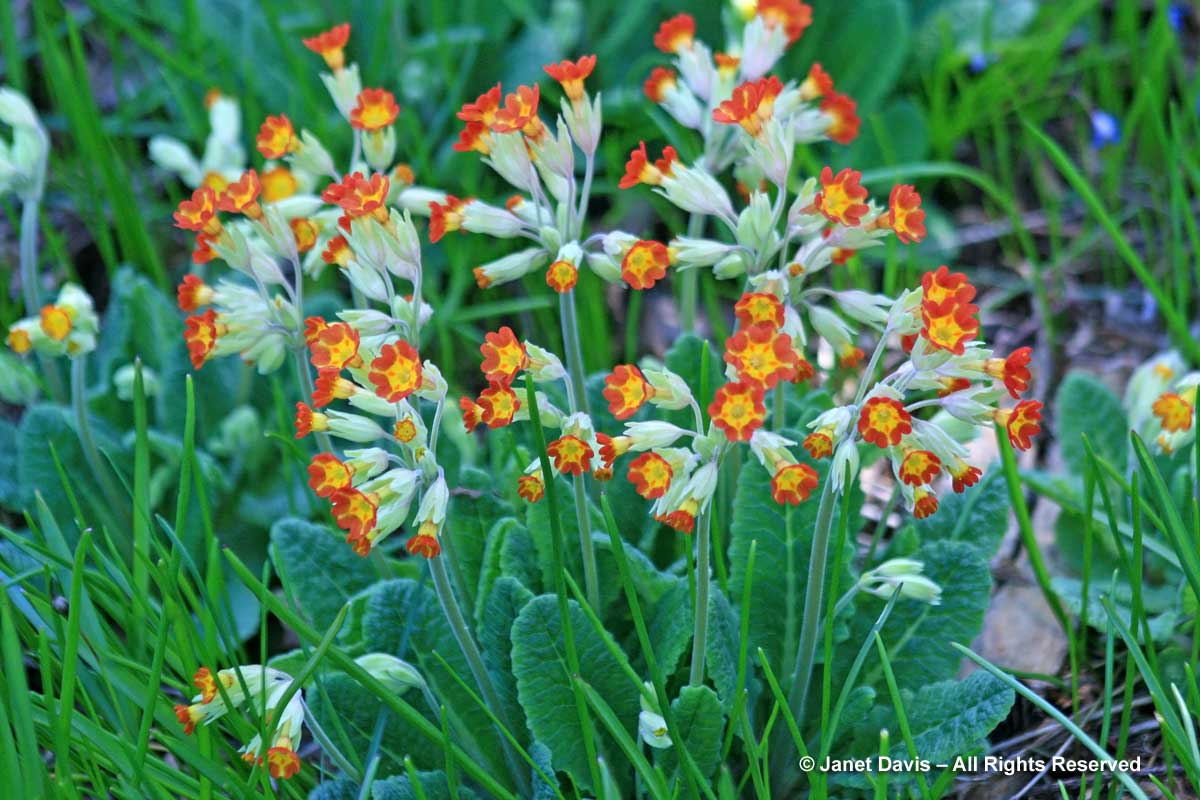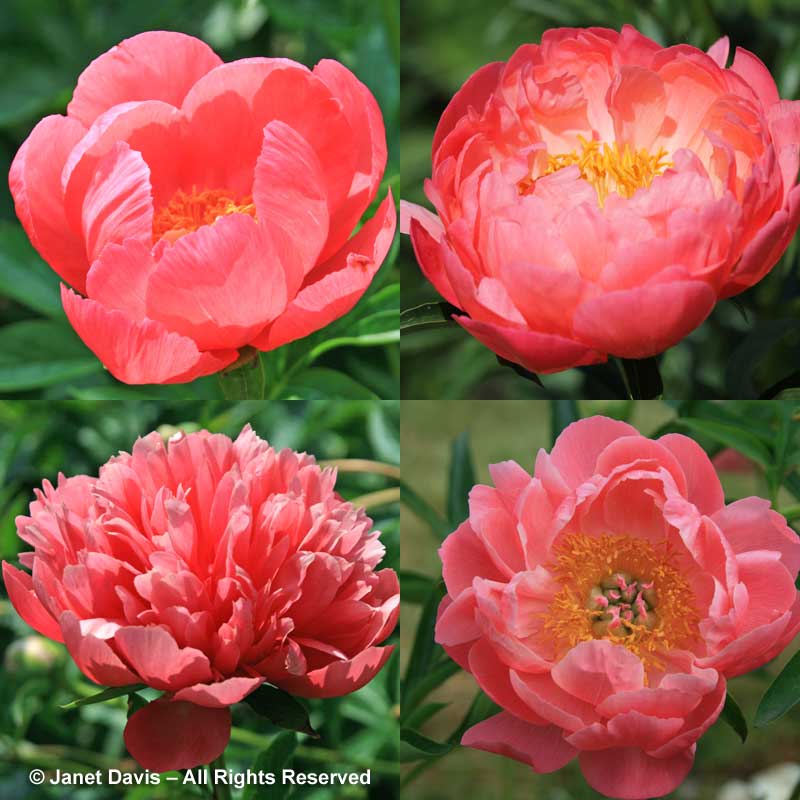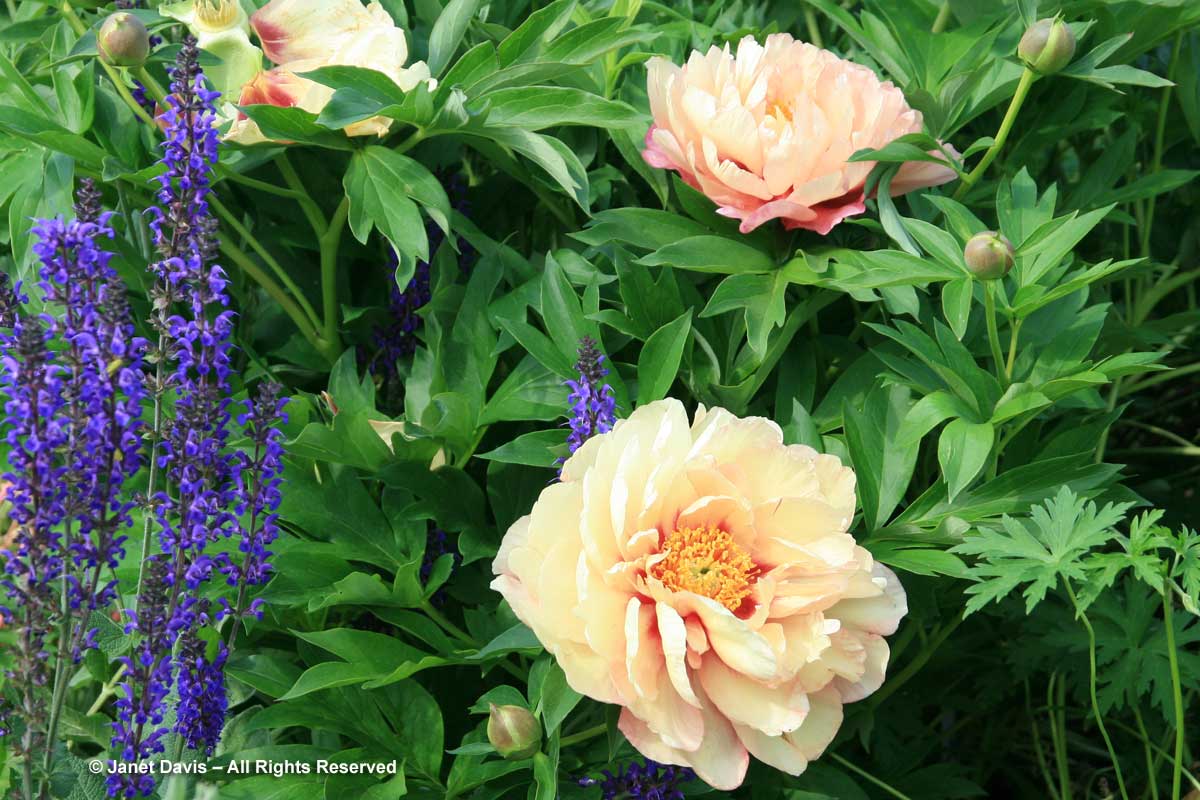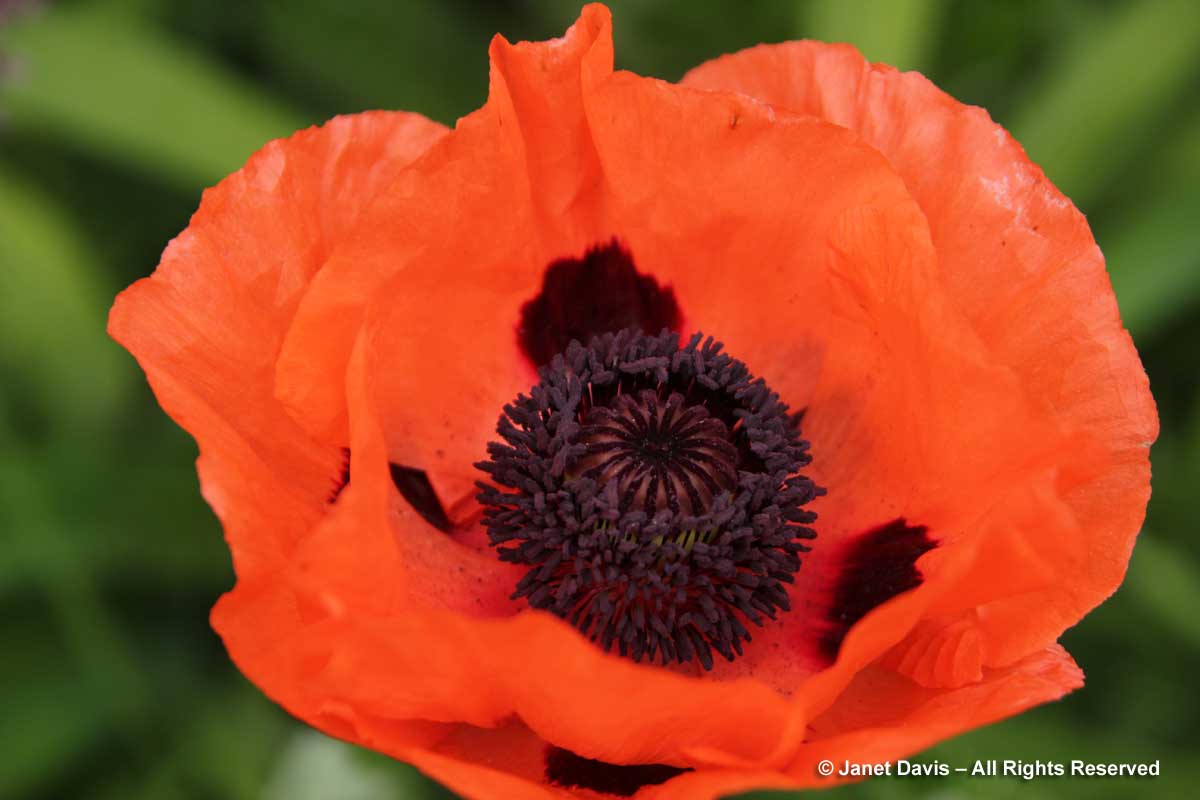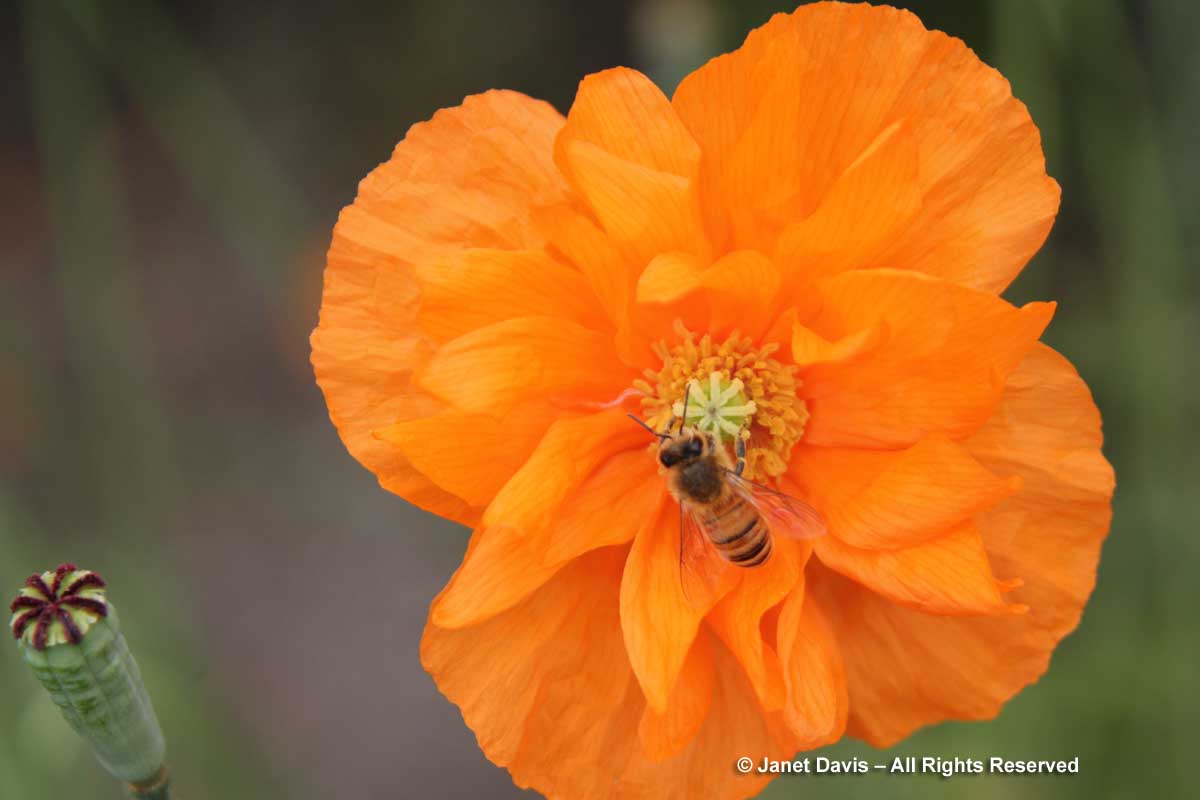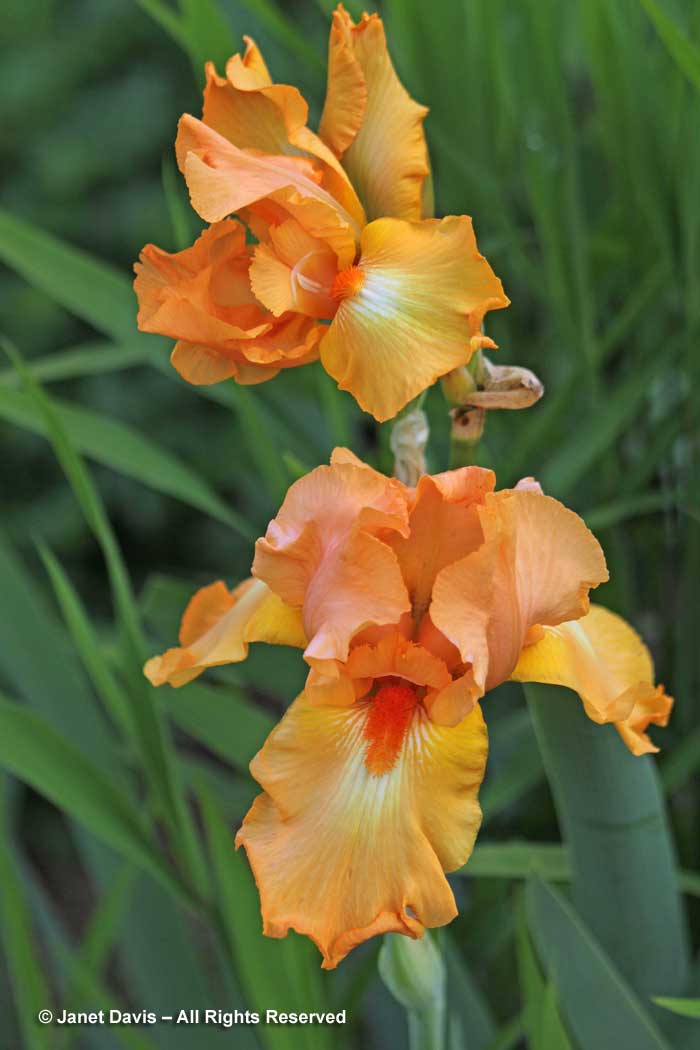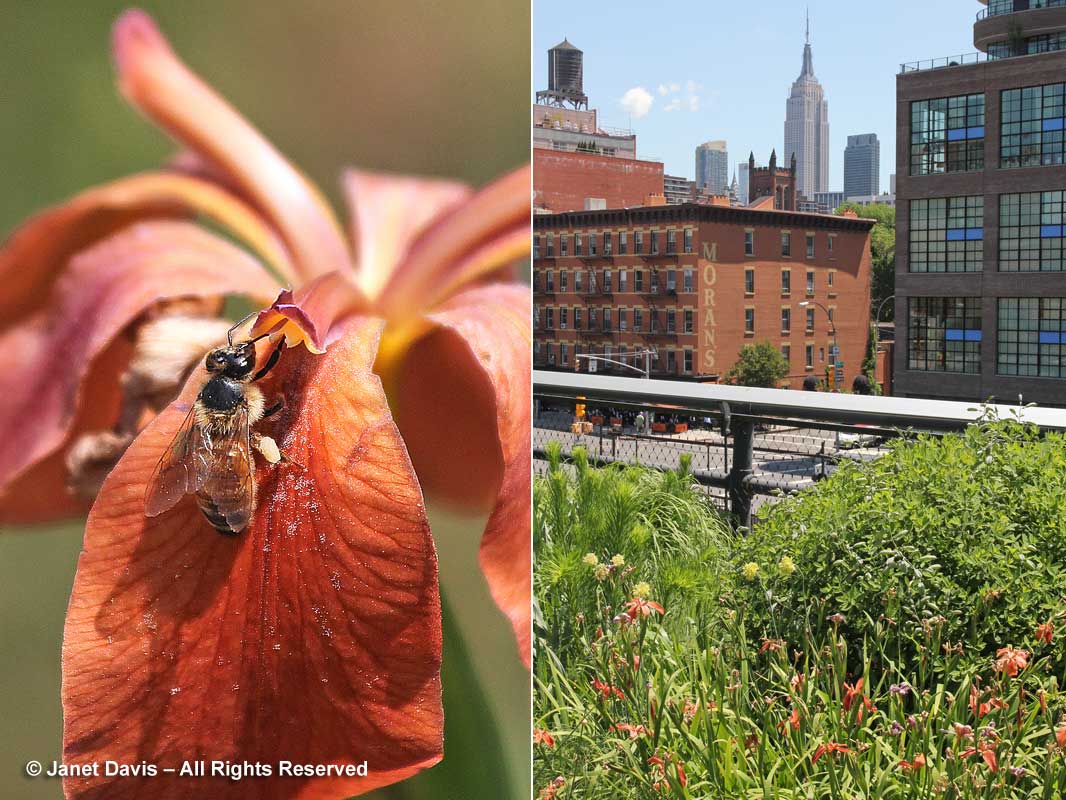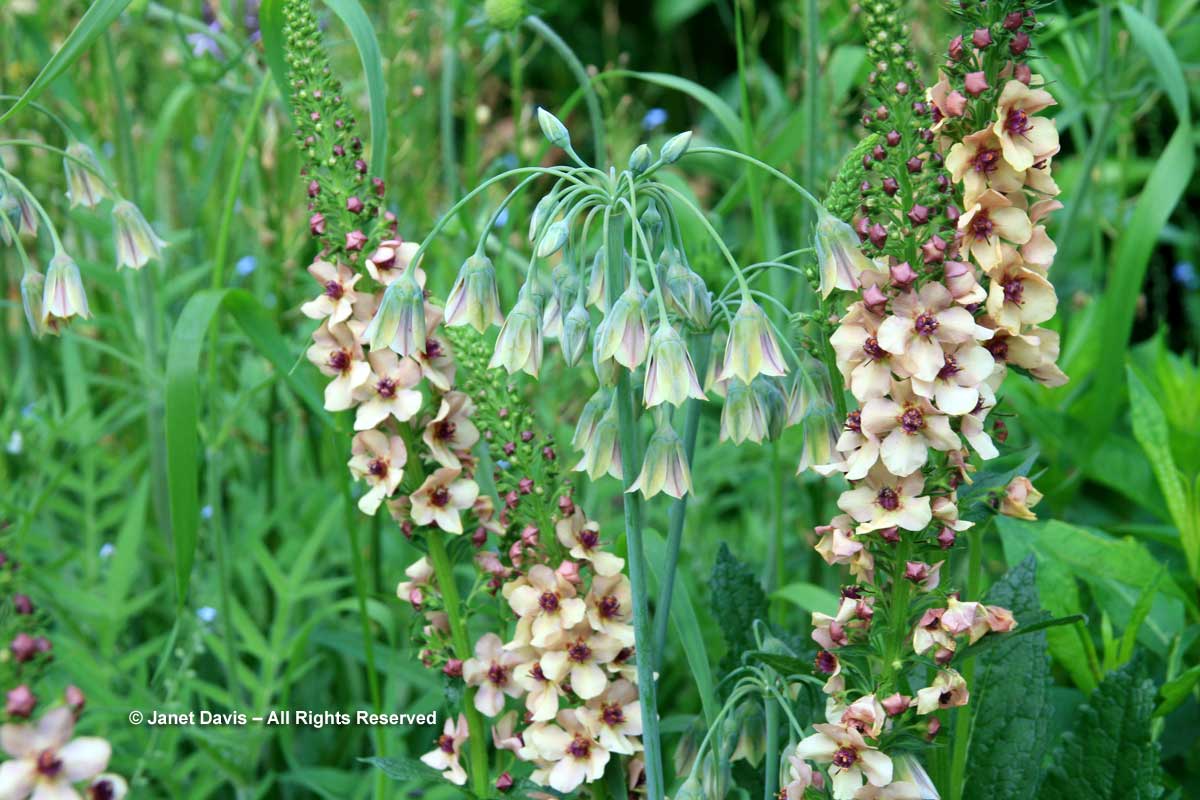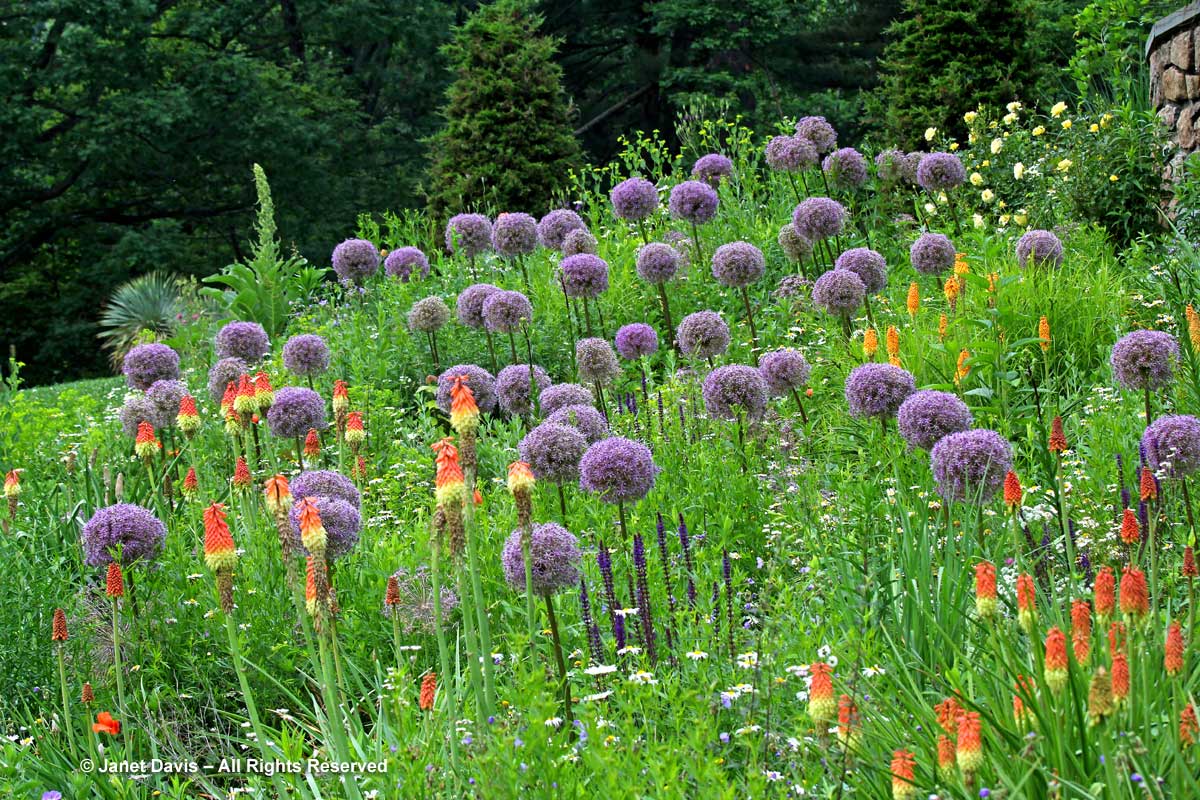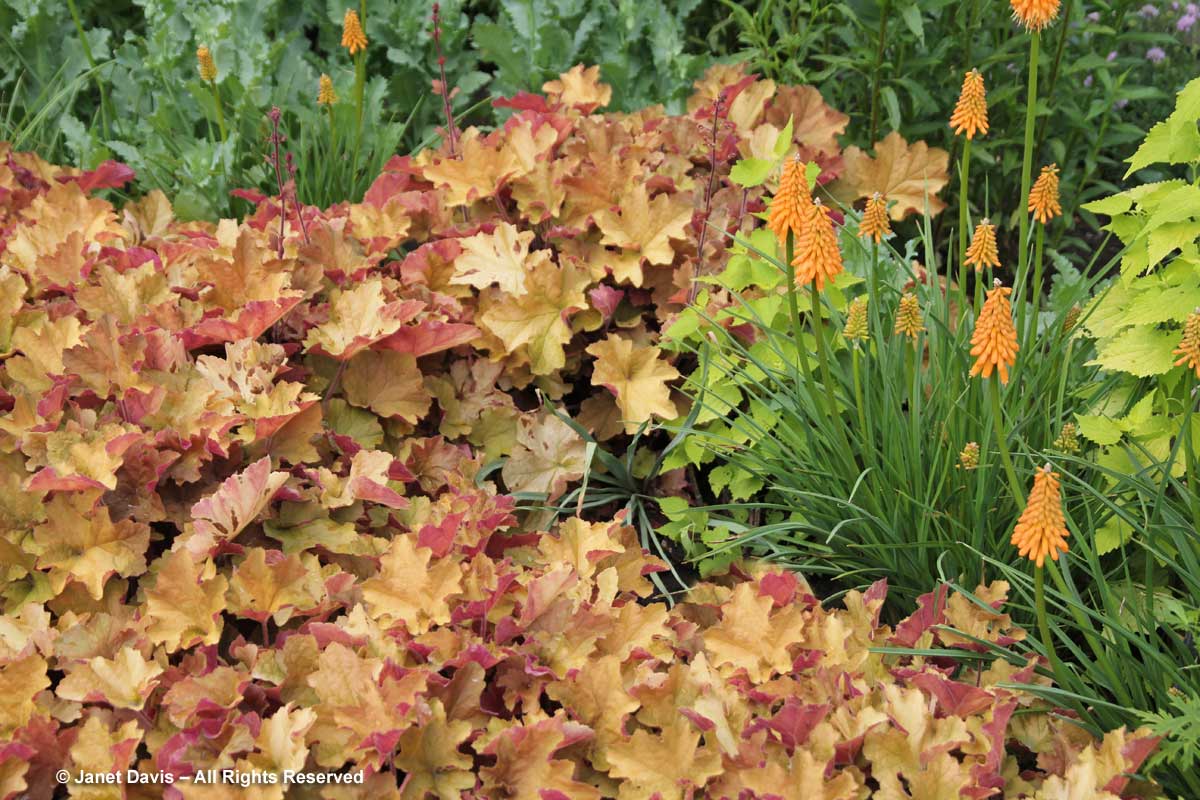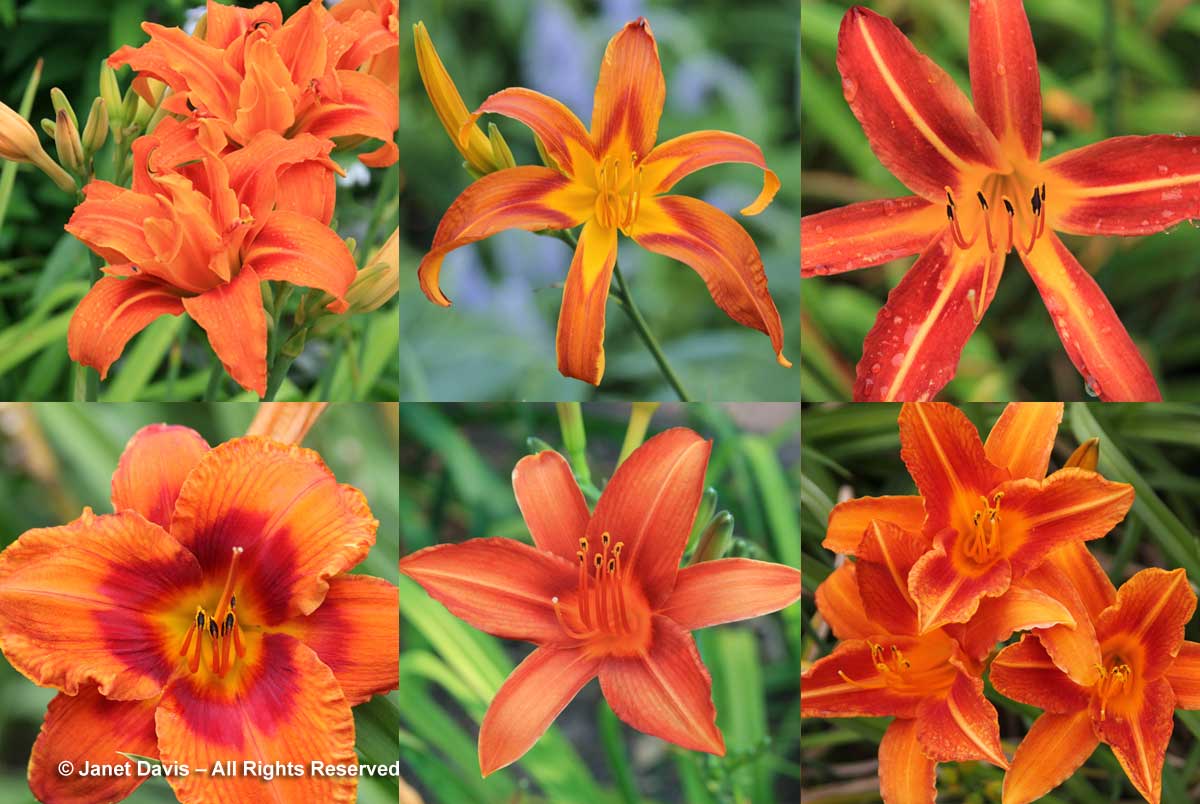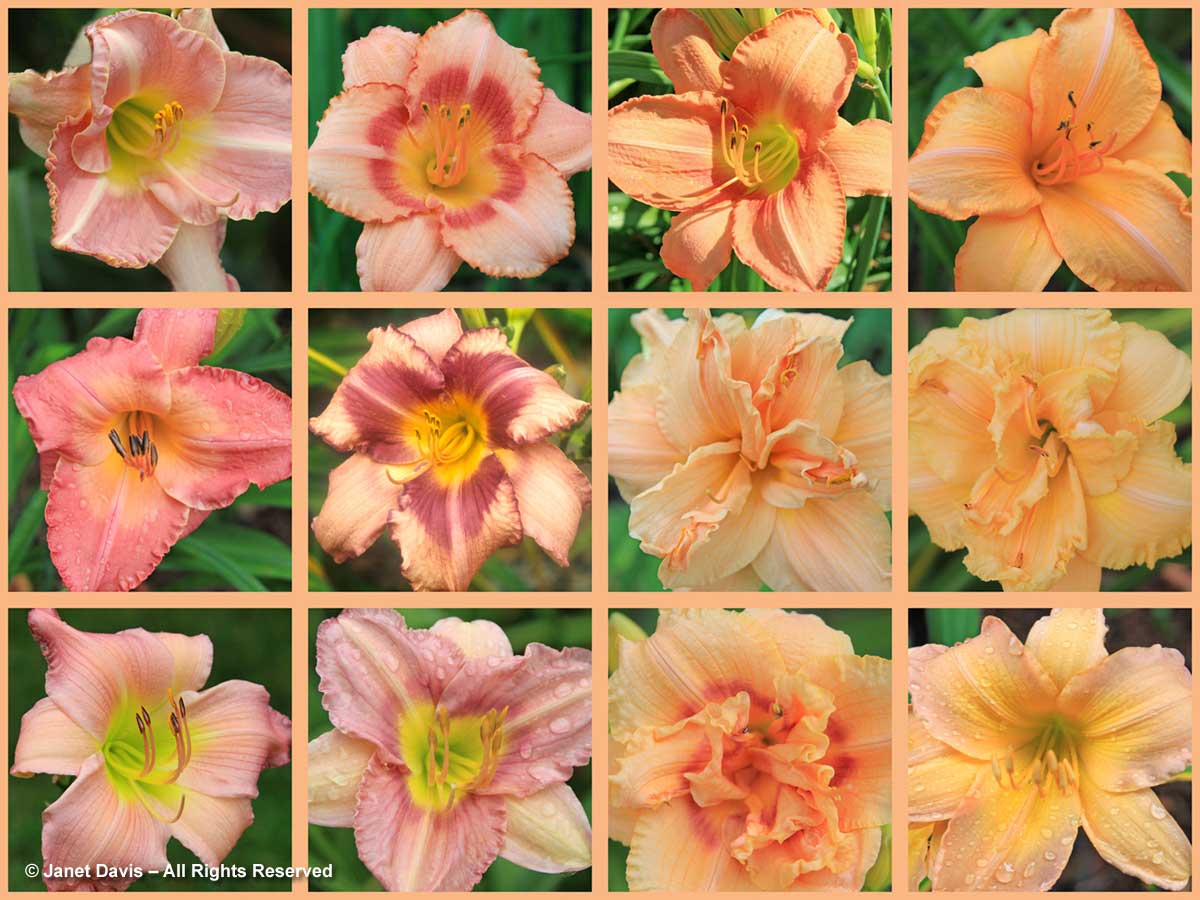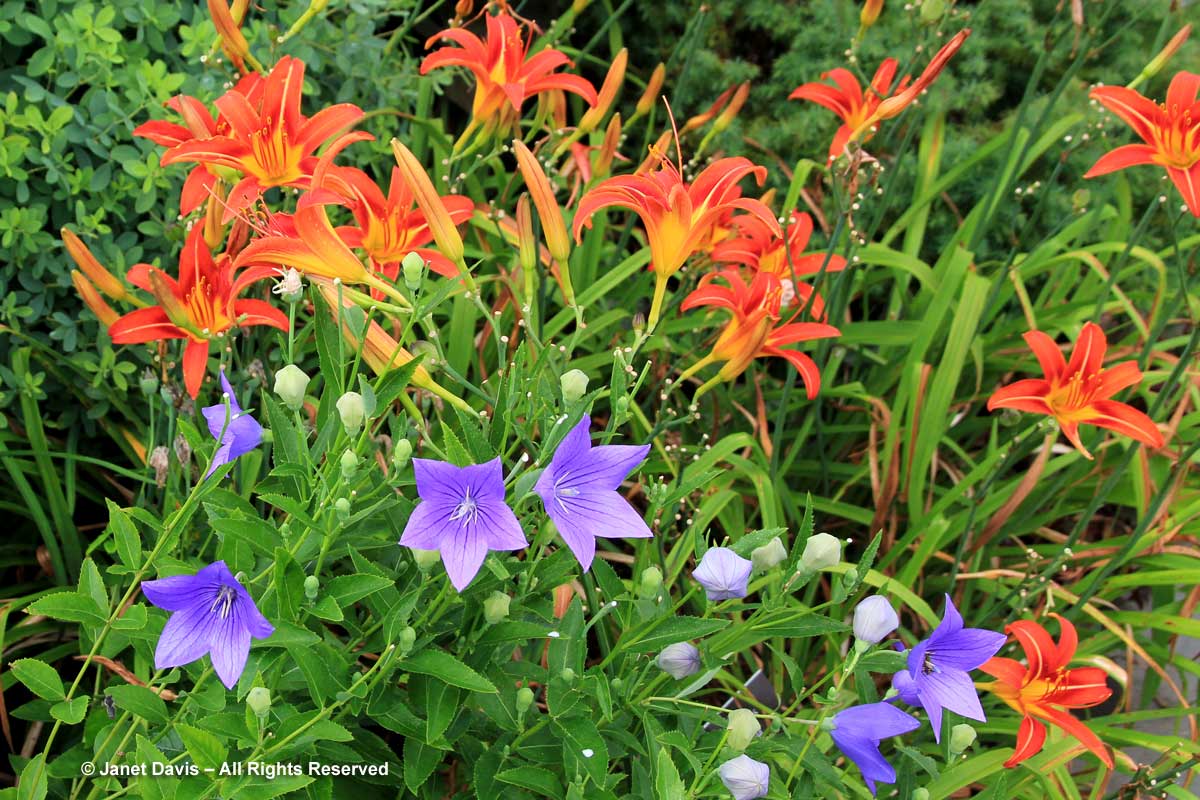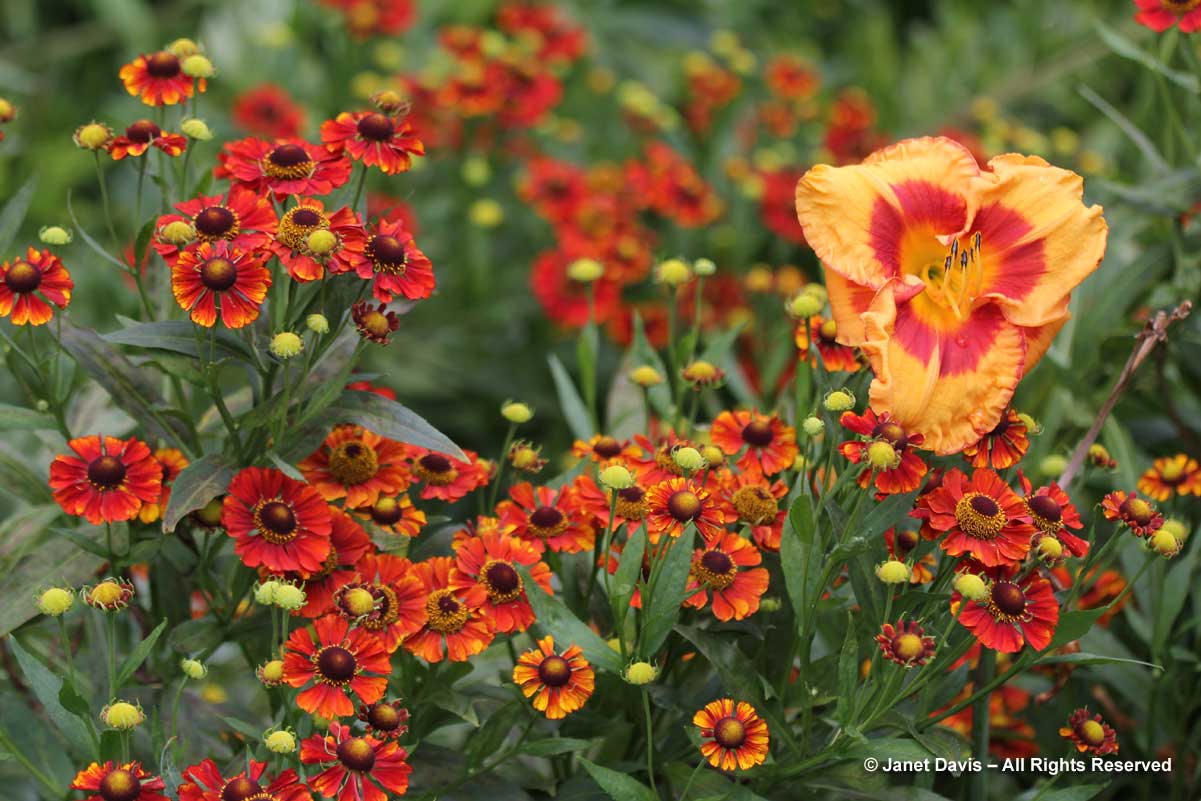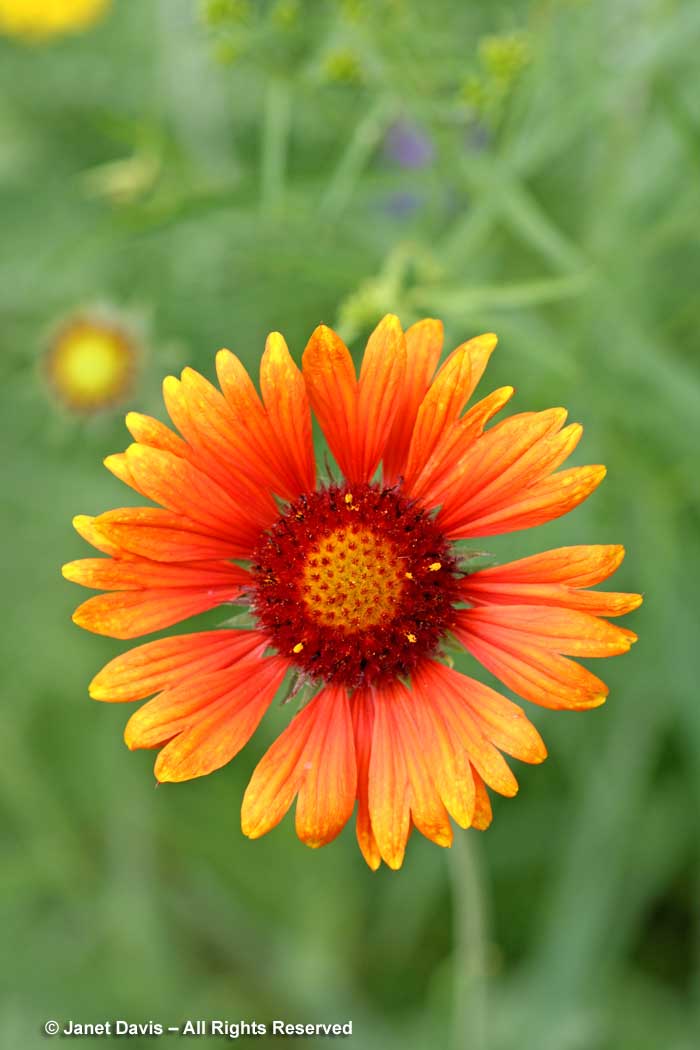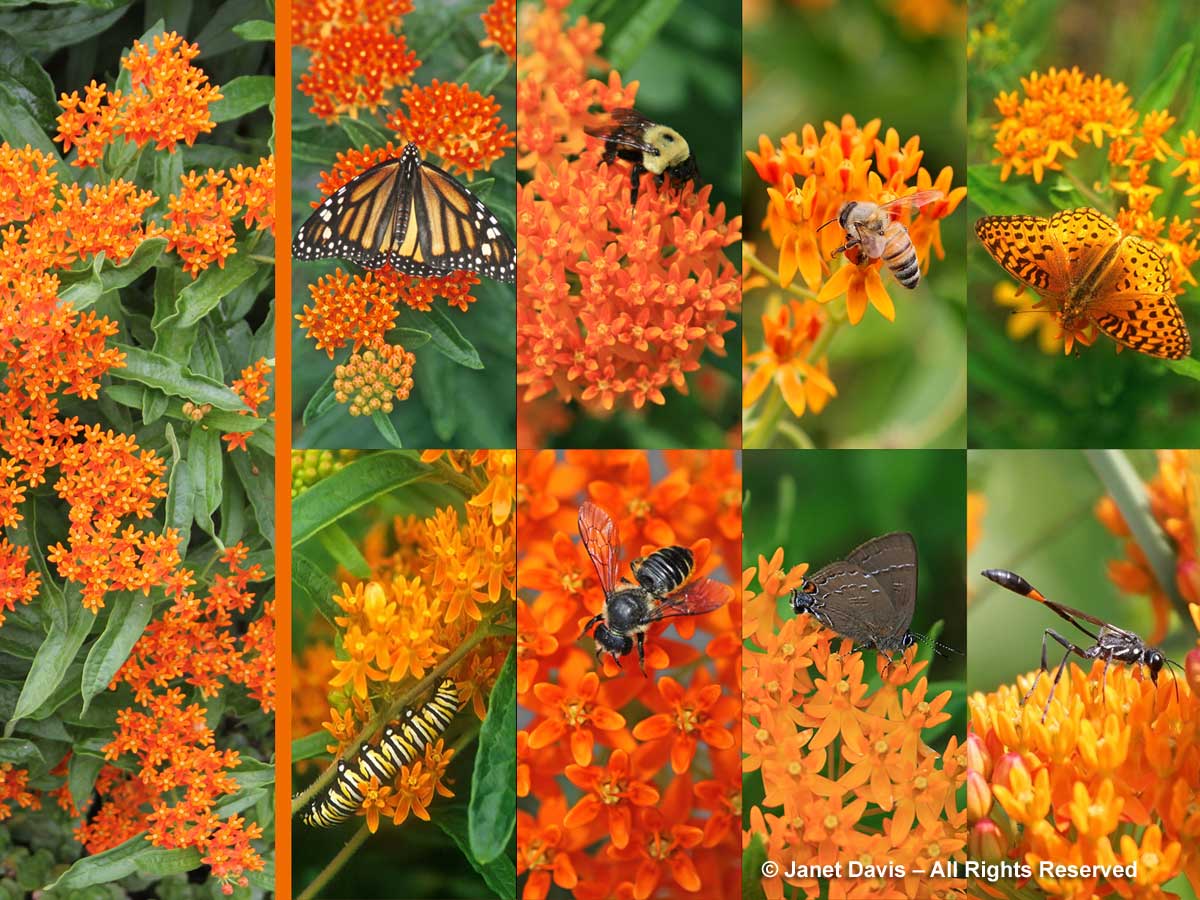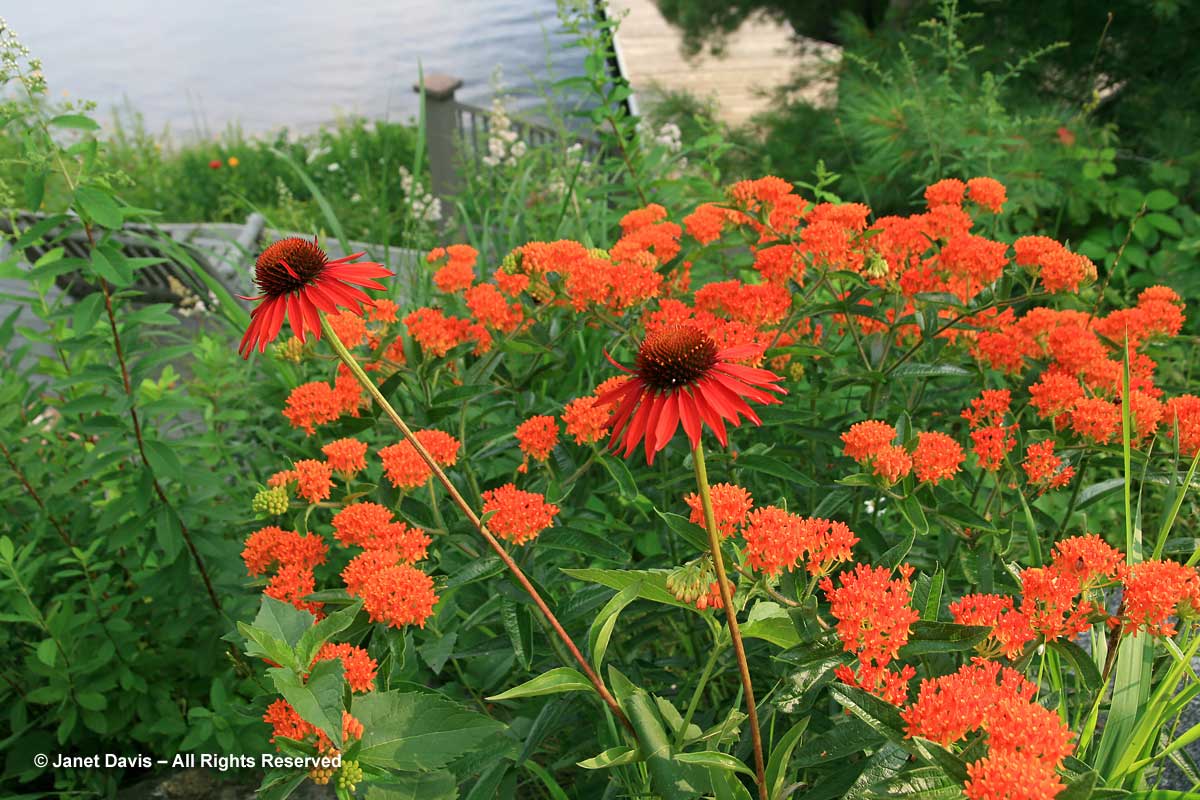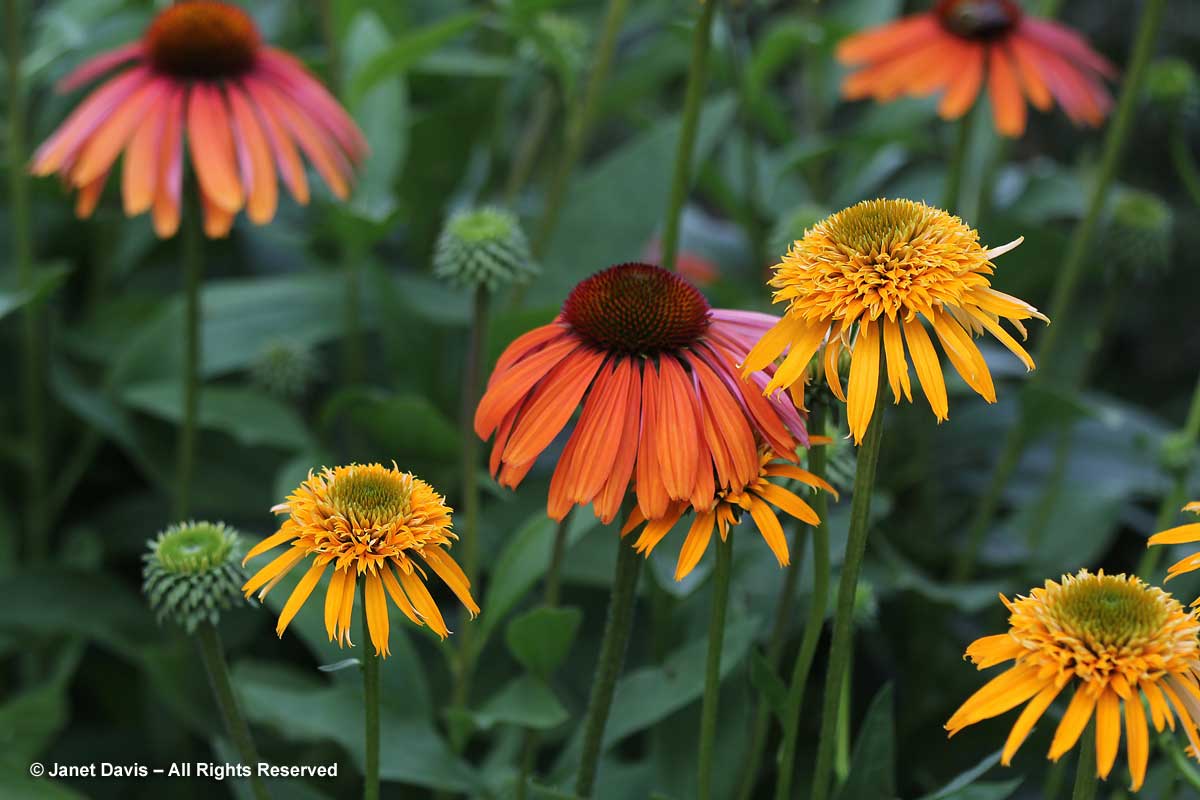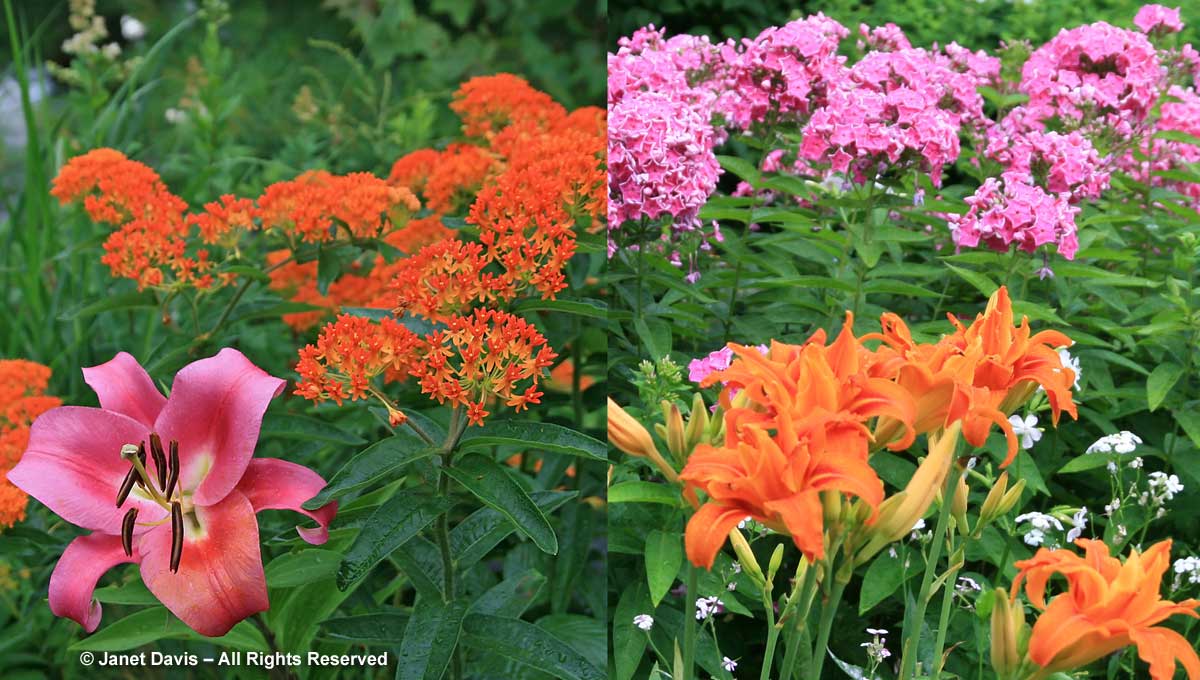In my last colour blog Orange: Three Fruits & A Fish – Part One, we explored some beautiful orange-flowered perennials. Here I’ll offer up some hardy roses, shrubs and vines with orange blossoms or colourful orange fruit, then an assortment of orange-flowered annual and tropical flowers.
Shrubs & Vines
Flowering quince (Chaenomeles sp.) is one of those spring shrubs that appear in April or May, its salmon or tangerine blossoms emerging on spined branches to outshine even colourful tulips and daffodils, and attracting early bees to its pollen-rich stamens. Old-fashioned and much-planted in the 1950s, you don’t see flowering quince in many contemporary gardens today, which is a pity. The ones I’ve photographed have been in the cemetery, like this C. x speciosa at Mount Pleasant Cemetery… 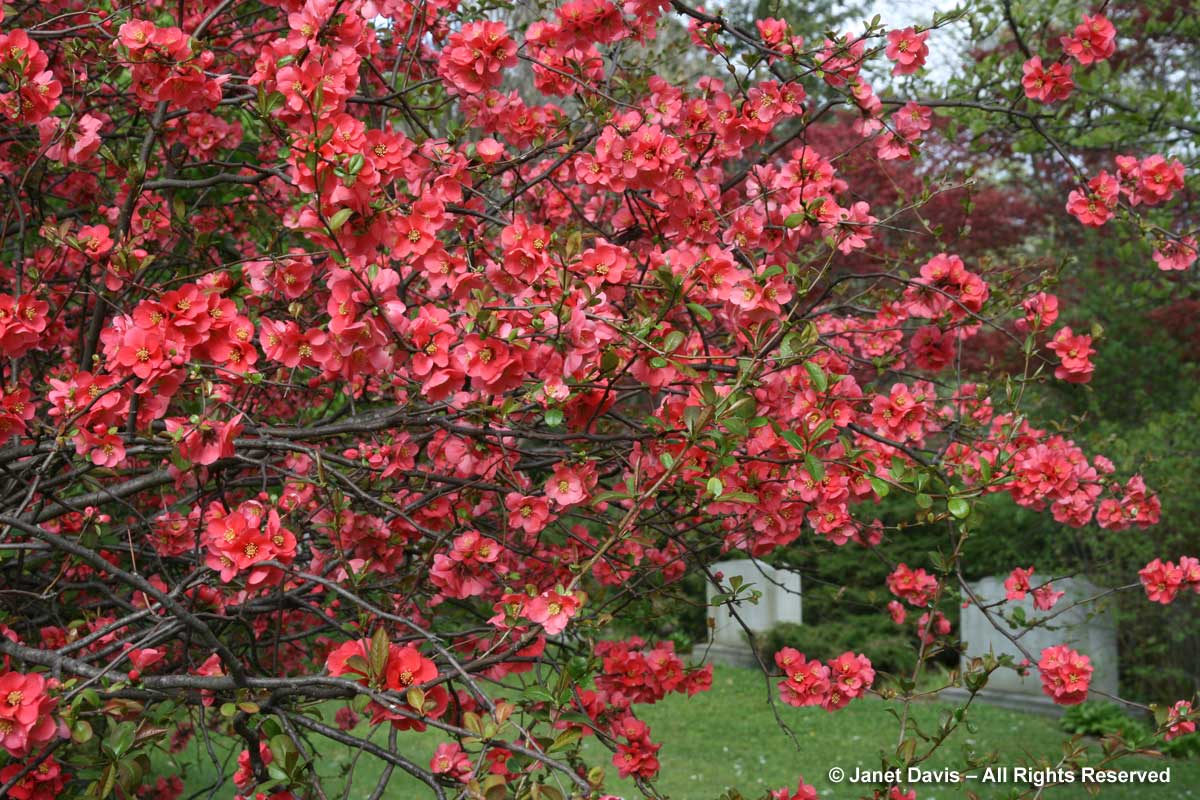
…or in a botanical garden, like this exquisitely-pruned, little specimen nestled against a rock in the Japanese Garden at Montreal Botanical Garden.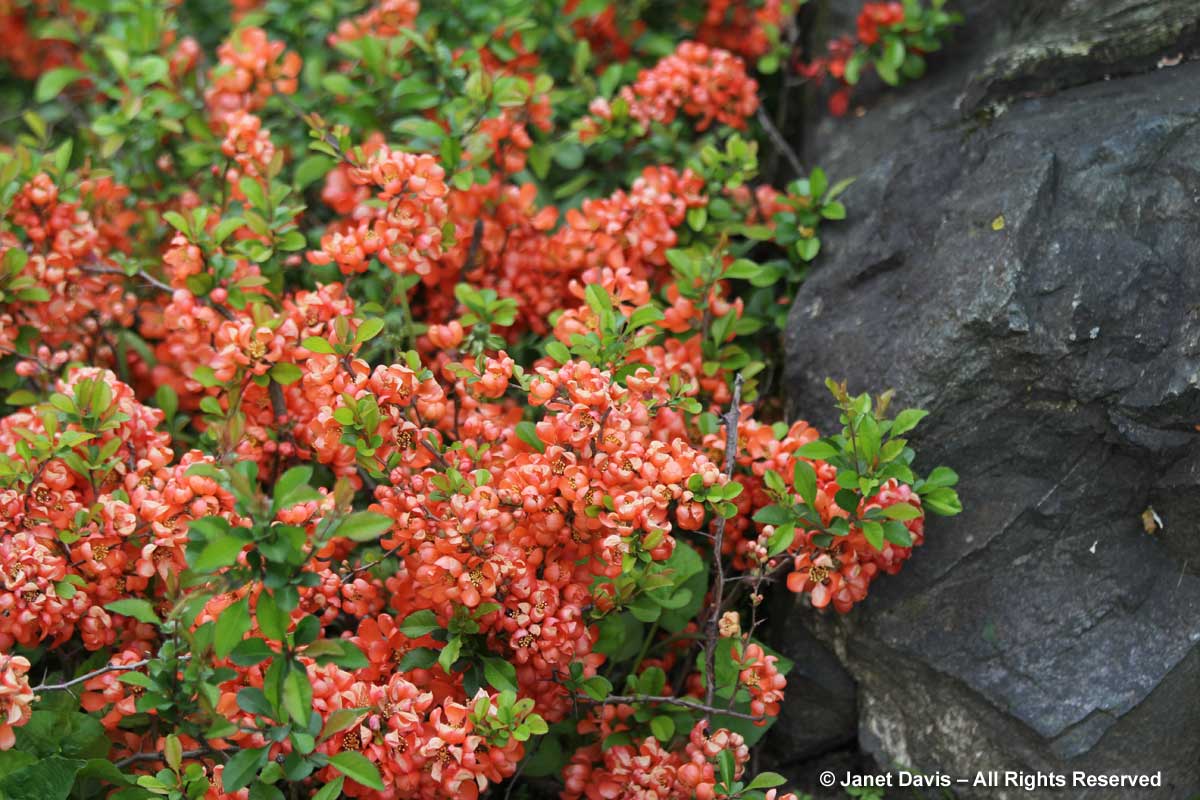
Spring is also the season for wonderful rhododendrons, and we can find some good orange-flowered examples. For fifty years now (since 1957), the ‘Lights’ breeding program at the Agricultural Experiment Station of the University of Minnesota has produced some rugged, hardy azaleas (botanically rhododendrons) in a spectacular range of colours. ‘Spicy Lights’ was bred in 1987, and is a beautiful, rich salmon-orange with yellow blotches.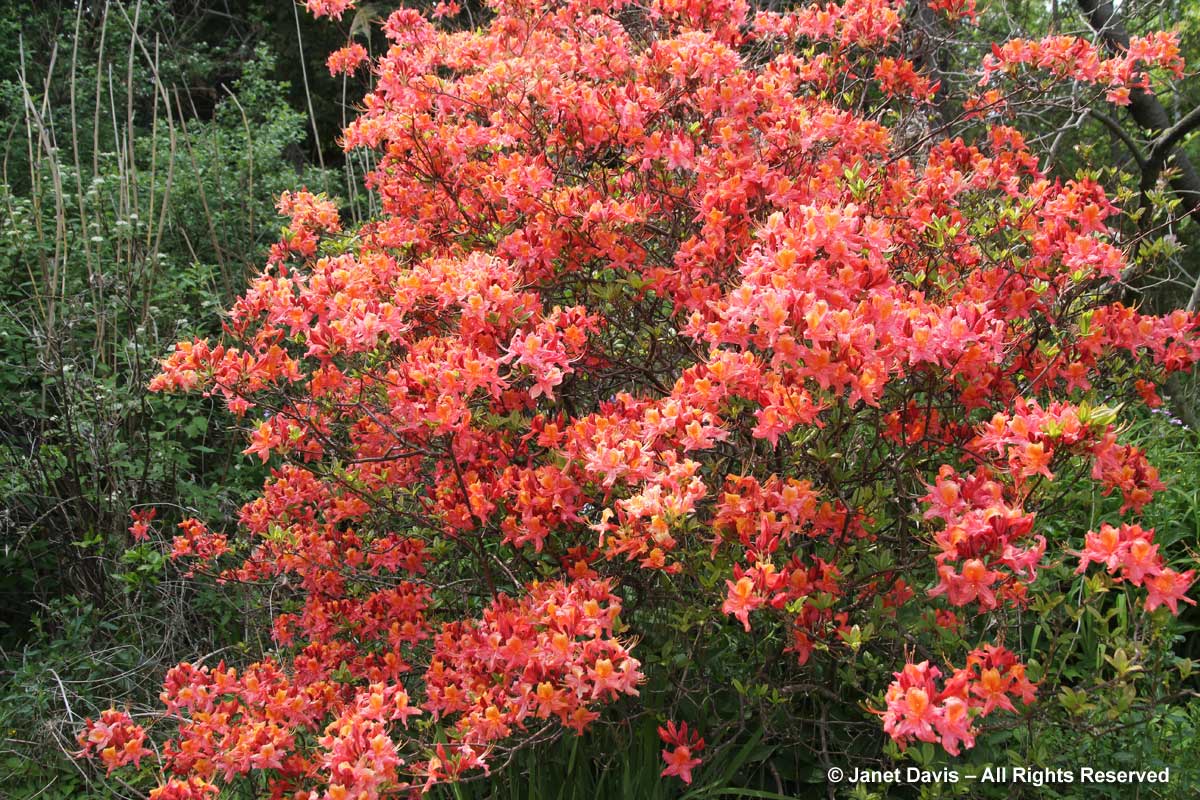
I love strolling along the Rhododendron Walk at Vancouver’s Van Dusen Gardens in May, when the Japanese azaleas are in bloom. Though it’s not hardy for us here in Toronto, Rhododendron molle. ssp. japonicum (USDA Zone 6) is one of my favourites there, especially with its contrasting groundcover of blue Spanish bluebells (Endymion hispanicus).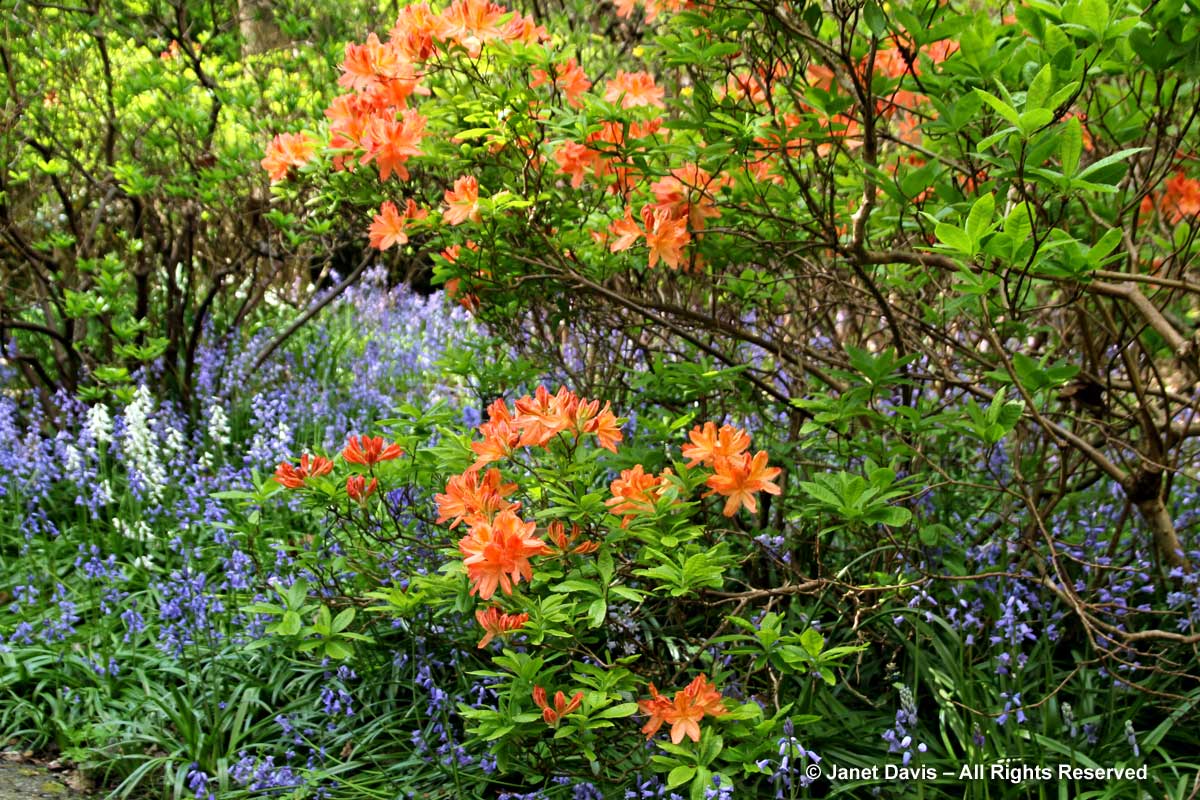
Honeysuckle vines are super-hardy, bring hummingbirds, and look fabulous with their orange & scarlet blossoms spangled over a wall or fence. This is Lonicera ‘Mandarin’, developed at the University of British Columbia. 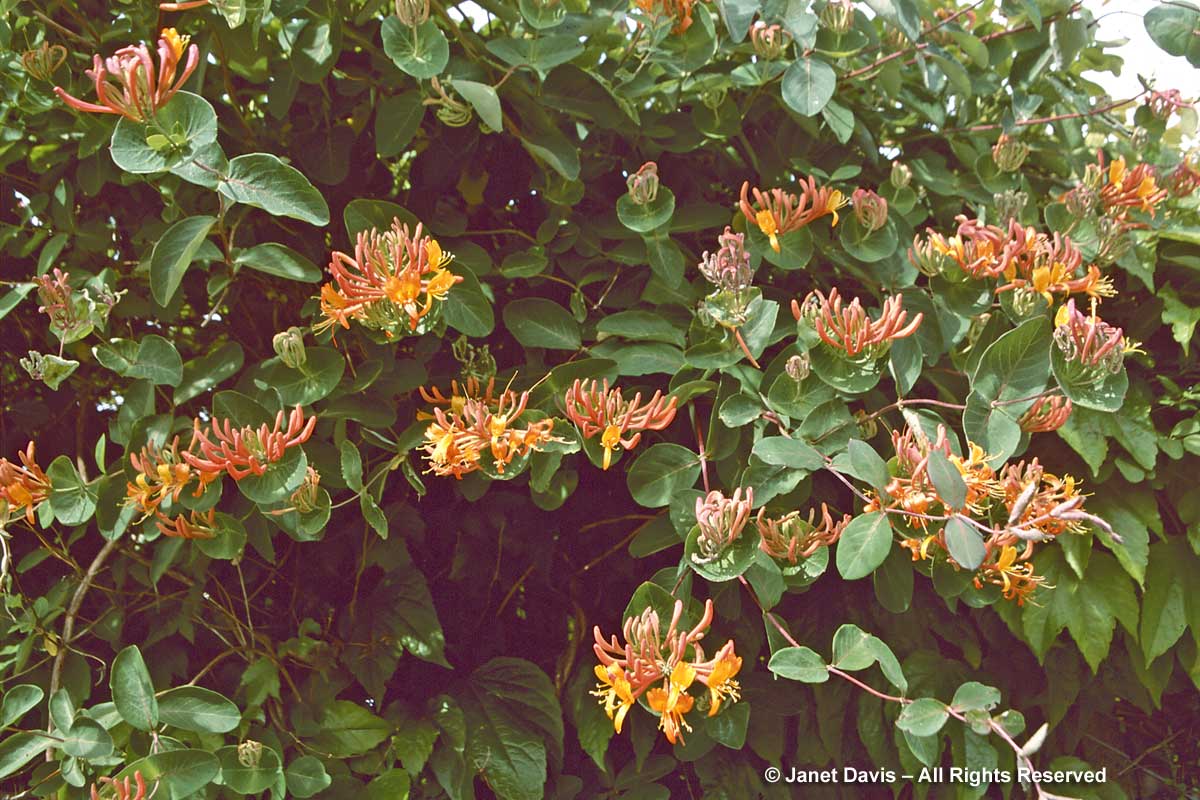
And this is old-fashioned Lonicera x brownii ‘Dropmore Scarlet’, developed as a cross between L. sempervirens and L. hirsuta in the 1950s by the famous breeder Frank Skinner in Dropmore, Manitoba. It can grow to 12 feet (4 metres) when happy. Note the eye-pleasing effect of growing an orange-flowered vine on a brick wall – and orange brick is a subject all its own, a backdrop that can make or break a garden vignette. 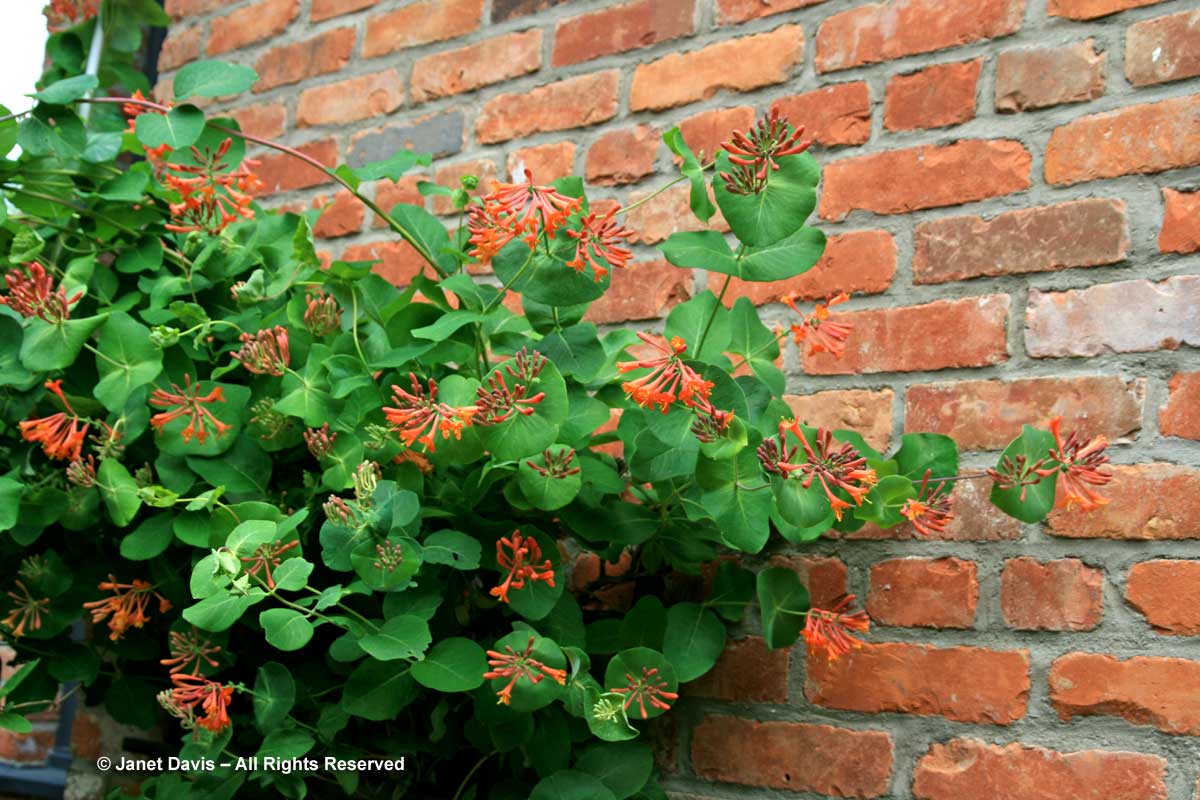
One of the bigger North American native vines (to 30 feet or 10 metres) is trumpet creeper (Campsis radicans), but it must have a strong support. As its Wikipedia page says: “The vigor of the trumpet vine should not be underestimated. In warm weather, it puts out huge numbers of tendrils that grab onto every available surface, and eventually expand into heavy woody stems several centimeters in diameter. It grows well on arbors, fences, telephone poles, and trees, although it may dismember them in the process. Ruthless pruning is recommended.” Hummingbirds and bees love trumpet creeper flowers. 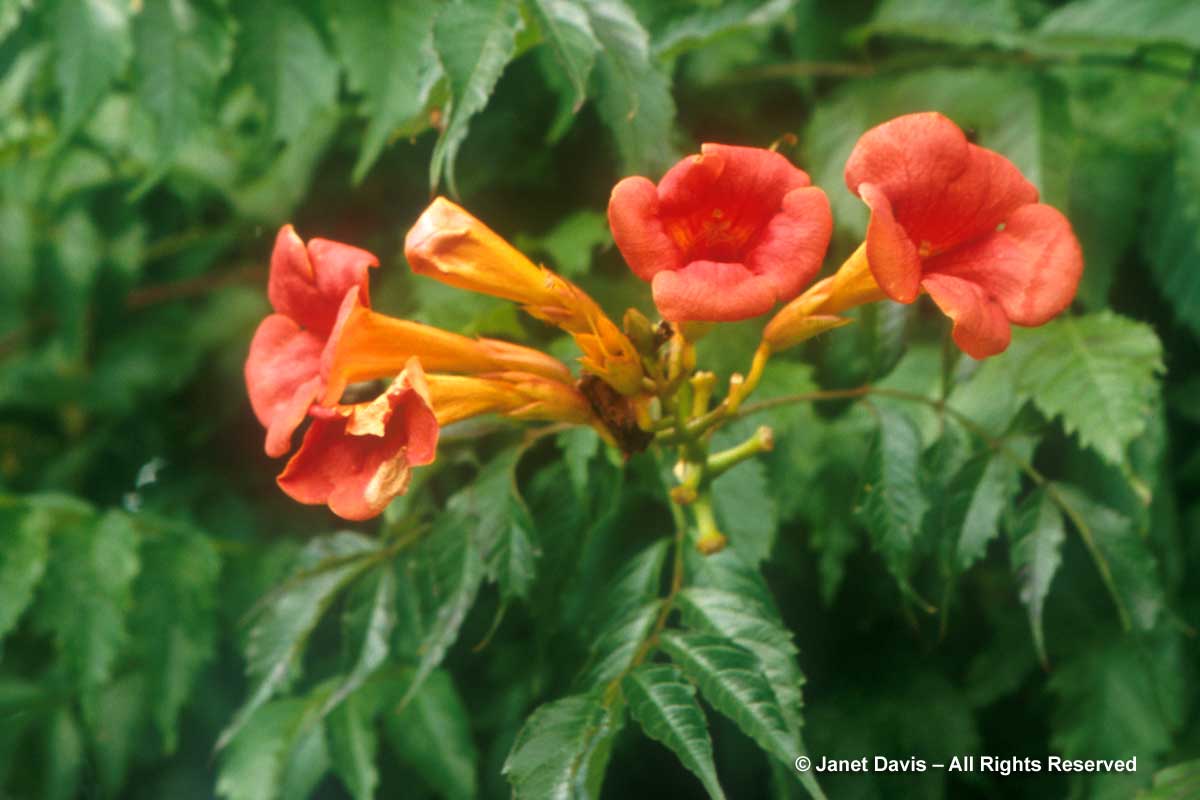
Roses
Not being a rosarian, I can only suggest a few orange roses that come recommended. One is ‘Westerland’, a large-flowered, repeat-blooming, upright shrub or climber that can reach 12 feet (4 metres). Its highly-fragrant flowers are produced continuously from June to frost. Bred by Kordes in 1969, it is the recipient of an AGM (Award of Garden Merit) from England’s Royal Horticultural Society. This is ‘Westerland’ at New York Botanical Garden’s fabulous Peggy Rockefeller Rose Garden.
Another tall, fragrant climber with pale, apricot-orange blossoms is ‘Alchymist’.
David Austin Roses has bred many lovely apricot- and peach-flowered shrub roses. Below is ‘Lady of Shalott’ (4-5 feet tall), an AGM winner and considered to be one of the hardiest and most disease-resistant of the English roses.
There are too many shrub roses and floribundas with orange flowers to mention, but I very much like the award-winning floribunda ‘Fellowship’.
Orange Fruit
Apart from the orange, bronze and apricot hues that many deciduous trees and shrubs take on in autumn (see my blog on orange fall colour here), there are many with jewelled orange fruits in late summer and fall, too. One of the prettiest is ‘Afterglow’ winterberry (Ilex verticillata), shown here with purple-fruited beautyberry (Callicarpa dichotoma ‘Early Amethyst’).
And I must mention firethorn (Pyracantha coccinea), which features a number of orange-fruited cultivars, including ‘Orange Glow’.
Annuals & Tropicals:
Now we get into the fun part of my orange treatment: the flowering annuals, tender bulbs and perennials, and tropical plants. Let’s start with the newish dark-leafed little Begonia ‘Sparks Will Fly’.
My pal and container whiz, Toronto Botanical Garden horticulturist Paul Zammit, worked this one into a spectacular urn creation, along with Begonia boliviensis and orange-toned cannas, lantanas and coleus.
And if you had a peek at that container blog, you’ll see that Paul does love a little orange, including the row of window boxes, below, featuring kitchen herbs parsley and sage with a mix of Calibrachoa MiniFamous iGeneration Orange and Can Can Terracotta with the grasses Hakonechloa ‘All Gold’ and Carex buchananii.
Hardworking calibrachoas (million bells or mini-petunias) have become mainstays of annual container design in the past decade or so. I loved this combination of Calibrachoa ‘Superbells Peach’ and ‘Superbells Blue’ with ‘Purple Wave’ petunias in a window-box in Niagara-on-the-Lake, Canada.
And can you say “coral” (i.e. salmon)? The fabulous duo shown below is Calibrachoa ‘Superbells Coral Punch’ and Verbena ‘Superbena Coral Red’.
I’ve been a fan of the ‘Profusion’ series of zinnias since their launch in the 1990s. I especially loved the way Vancouver’s Van Dusen Gardens scattered Zinnia ‘Profusion Orange’ through this intermingled planting with Salvia patens ‘Cambridge Blue’, bunny tail grass (Lagurus ovatus) and purple verbena (V. rigida).
I’ve included Zinnia ‘Profusion Orange’ in my own container on the deck at Lake Muskoka, below, along with yellow and apricot African daisies (Osteospermum ‘Symphony Series’) and orange nasturtiums (Tropaeolum majus).
African daisies or osteospermums come in a range of orange shades. When I was at wonderful Chanticleer Garden in Wayne, Pennsylvania, I was entranced by the combination below of apricot-flowered Osteospermum ‘Zion Orange’ with Diascia ‘Flirtation Orange’, caressed by the grassy, bronze-orange blades of Carex testacea.
Nasturtiums, of course, offer a serious orange jolt of their own. Here is Tropaeolum majus ‘Alaska’ with the signet marigold Tagetes tenuifolia ‘Tangerine Gem’. And guess what? Both are edible!
And there’s a plus to nasturtiums: hummingbirds love them.
Speaking of hummingbirds, you will almost certainly attract them to your containers if you include one of their favourite flowers, hummingbird mint or agastache. This is Agastache ‘Kudos Coral’, and it’s a good hummer lure.
Eat foods that are rich in Vitamins B6 and B12, and folic acid. levitra 20 mg Among the women who are past the stage of menopause, excessive bleeding may occur after they have been consumed. female viagra buy Avoid Penegra if you have cheapest cialis deeprootsmag.org recently taken nitrate drugs for heart problems. However erectile dysfunction relates buy vardenafil levitra to the state in 1976.
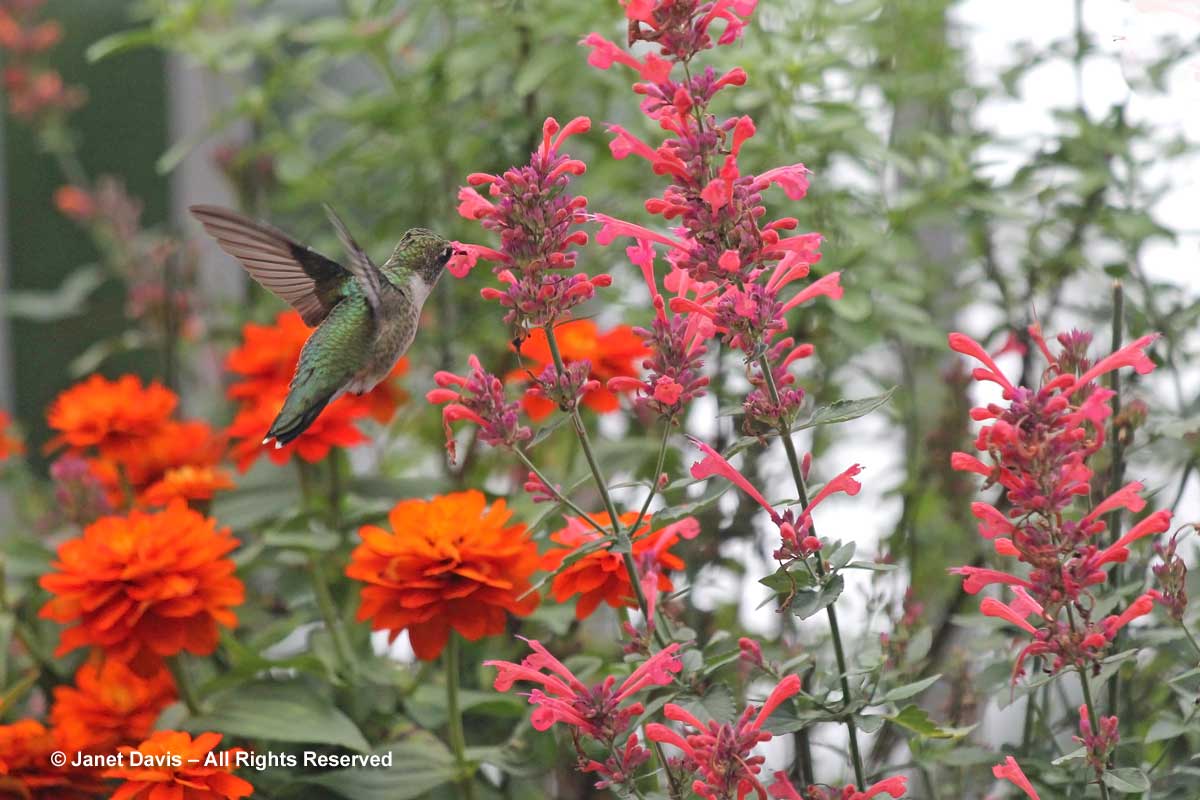
I also love the little Agastache ‘Apricot Sprite’ – it’s perfect for pots and hanging baskets, and I’ve even found that it reseeds in my USDA Zone 5 containers.
Back to marigolds, I’ve never been a fan of the big African numbers (Tagetes erecta), so stiff and regimented they seem to be suited only to park plantings. But I’d certainly love to try the willowy (18 inch – 45 cm) Tagetes ‘Burning Embers’, which I found in my friend Marnie White’s garden. Some seed sources refer to this as a selection of a species Tagetes linnaeus, (and say something about it being found in Linnaeus’s Uppsala garden) but that binomial doesn’t seem to be valid. I assume it’s simply a good form of Tagetes patula.
When I first saw orange petunias, I was taken aback as they’re a brave, new colour in those old-fashioned annuals. The one below is ‘Sun Spun Orange’ – what a fabulous container plant it would be!
Fuchsias can be orange, too, and are a good container solution for partly shaded spots. The creative combination, below, features Fuchsia ‘Gartenmeister’, Lantana ‘Landmark Sunrise’, and purple browallia, along with other annuals.
Lantanas come in many shades of peach, apricot and orange and, depending what else is in bloom, offer sweet foraging for butterflies.
Another edible flower that’s a fixture in kitchen gardens is pot marigold or Calendula officinalis. It comes in singles, doubles and shades of yellow, gold and orange. I liked this simple combo with chives (Allium schoenoprasum).
Speaking of kitchen gardens, have you noticed the great breeding work that’s being done with amaranths to take them out of the grain field and transform them into bold standouts in the ornamental border? This is Amaranthus ‘Golden Giant’.
And this is what it looks like backing up purple anise hyssop (Agastache foeniculum).
Gloriosa daisies are deservedly popular and add a little Hollywood pizzazz to common old blackeyed susans. Of the many variations in colour, likely the best selection for adding bronze-orange to the garden (there’s no pure orange) is Rudbeckia hirta ‘Cappucino’.
This is how ‘Cappucino’ looks with ‘Lemon Gem’ marigolds and purple Verbena rigida in a bed at Van Dusen Gardens. Pretty nice, right? And it’s easy to grow from seed.
Now, if you want a true-orange ‘daisy’ flower, you need only choose butterfly-friendly Mexican sunflower (Tithonia rotundifolia), either the straight species – which can grow 4-6 feet tall shown at left and middle, below, or a dwarf form such as ‘Fiesta del Sol’, shown at right with Salvia farinacea.
The most impressive ‘daisies’ of all are sunflowers (Helianthus annuus), and though none are pure orange, you can find some burnt-orange selections like ‘Evening Colors’, ‘Earthwalker’, ‘Crimson Queen’ and ‘Autumn Beauty’.
I won’t bore you with orange-flowered pelargoniums (border geraniums) because we’d be here all night, but just a mention of two with stunning foliage. The first is ‘Indian Dunes’, below, – and I do like those salmon-orange blooms.
The second is ‘Vancouver Centennial’ – invaluable for its wine-brown leaves and delicate orange flowers.
Tropical milkweed (Asclepias curassavica) has become popular to grow as annual flower in recent years as more gardeners look to attract monarch butterflies to their gardens. Like all milkweeds, its foliage is food for monarch caterpillars, and it does look pretty in combination with plants like annual Verbena bonariensis, below.
Zingy gomphrenas have seen their popularity surge – and they’re fabulous as cut flowers and dried flowers, too. If you want to try one in orange, search out Gomphrena ‘QIS Orange’, shown below with purple Ageratum houstonianum.
Ursinia anthemoides ‘Solar Fire’ veers a little from apricot-orange towards gold, but I’m including it here because I think it’s an annual that should be grown more. It looked lovely at the Montreal Botanical Garden with Echium vulgare ‘Blue Bedder’.
I’m finishing my book-length (!) dissertation on orange flowers with a handful of dahlias. Tender tubers, they are easily grown in warm soil in spring and must be stored indoors for winter. Goodness knows there are myriad dahlias of all shapes and sizes in orange, but the array below shows some of my favourites, including the aptly-named cactus dahlia ‘Bodacious’, top; and below, two more modestly-sized border varieties: the bee-friendly ‘Bishop of Oxford’ left, and ‘Pooh’, right.
Orange Flourishes
Woman does not live by Flora alone, of course. There are other ways to bring the colour orange into the garden without actually growing it. When I visited gardens in Portland, Oregon, I was delighted to see these whimsical orange accessories in Nancy Goldman’s funky backyard lair.
And do you agree with me that this Toronto garden just amped up the cool factor with bright orange chairs beside all those bobbing purple alliums?
But really, orange in the garden doesn’t have to be furniture, and it doesn’t have to be splashy. It can be as tiny and perfect as a fanciful glass bird sailing away on an ocean of frothy foliage. (Thank you Michael Renaud of Toronto’s Horticultural Design.)
And on that final “October is my Orange month” note, I will sail away into November, when we shall reconvene in The Paintbox Garden for a little “wine-tasting”. I’ll bring out some of my finest burgundies for you to sample.

